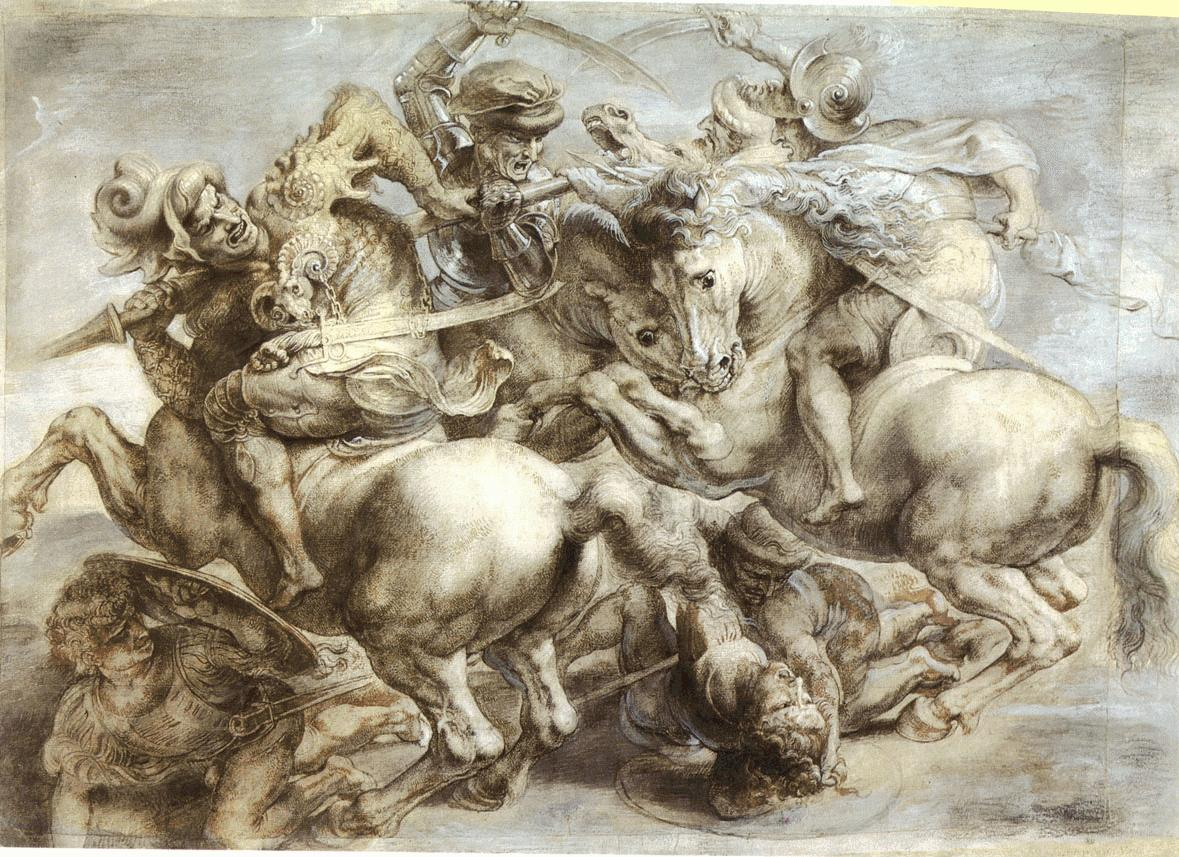Arth 1: Introduction to Art
Early Greek Archaic, Classical and Hellenistic Sculptures
What to Consider:
- sculpture as a means of creating and discussing identity
- What are the differences between Archaic, Classical, and Hellenistic?
- Where does Greek classical start?
**Art is representative of both culture and societal norms/desires.
Archaic Sculptures
- Menkaure n Khamerenebty statue captures the essence of Egyptian Art
- Egyptians culturally made the decision to not alter their art (if it’s not broke don’t fix it kind of thing)
- think about it narratively
==Kore== - maiden
==Kouros== - young man
Kroisos 530 BCE (archaic sense)
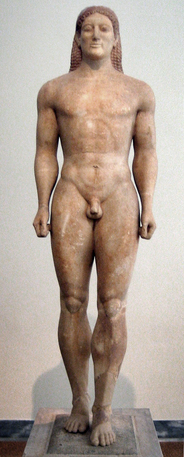
- stiff, same body type of Egyptians (shoulders and torso still stiff)
Kore 630 BCE
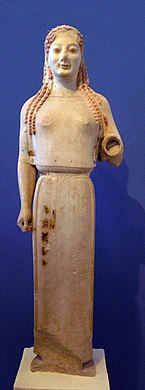
- dressed
- by choosing to clothe women (regardless of the misogyny imbedded) artists are forced to understand the stretch of fabric with relation to how the body moves beneath it
Temple of Artemis at Corfu (depiction of Medusa) 600-580 BCE

- Pediment - refers to the triangular build that sits atop Greek temples
- beneath the pediment lays the rectangular base which is the Entablature
- believed Medusa was placed as a symbol of protection
The shift of archaic to classical begins when artists learn how bodies and shapes contort to create realism in their work.
Greeks demonstrate technical ability (classical) v. concept of ability (archaic)
The Siphian Treasury, Dekphi 530 BCE
- where all the valuables were housed for the Gods
- incredibly detailed, Gods were honored and praised through gifts
==Acroteria== - usually terra cotta (clay) sculptures the cover the corners and top of pediment
==Frieze Sculpture== - a continuous band of sculpted decoration
==Gigantomachy== - a depiction of a √battle between Gods and giants
- the usage of Gods against beasts when demonstrating war occurs because it dehumanizes death and glorifies their strength
- theatric works
East pediment of Temple of Aphaia, Aegina, 500-480 BCE
- there becomes an interest in proportions
Dying Warrior from west pediment, 490 BCE
- contains Archaic style from its smile to the very rectangular torso
- not naturalistic
Dying Warrior from east pediment, 480 BCE
- more natural
- better movement of the body (torso is turning, arm is reaching over, overall better understanding of mobility) and reaction to being wounded and dying
- first initial shift to classical work
Classical Sculptures
Better understanding of naturalism
Kritios boy
- elegant poses
- focus was on the correctness of anatomy instead of what shapes create a body (connects back to natural look v. stiff and almost natural look)
- not many muscles
- classical, free standing, carved 3D sculpture (different from the reliefs, or 2D, of archaic style)
Contrapposto
==Contrapposto== - pose that are connected with classical sculptures, a show of repose
<<Doryphoros<<<<, Polykleitos aka spear bearer, 450 BCE (THE Classical Sculpture to remember)<<
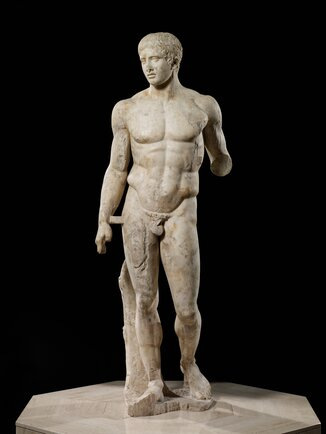
- first contrapposto
- first shift of naturalism
- indicates how the body looks in repose (natural state)
- symbol of what men should strive to be in this society (a soldier or athlete, as these people were capable of gaining power)
- idealized sculpture (focus was the creation of a symbol for what a Greek man os)
Zeus or Poseidon, 460-450 BCE, Bronze
- not as many of these sculptures around because bronze could be repurposed, many of the ones we have right now were found in the sea
Discobolus, Myron, Roman copy of Greek og 450 BCE
- themes of classical in Greece - proportional, mobile, idealized bodies
Riace Warrior 450 BCE, Bronze
- natural, a contrapposto, free standing, strength is a source of idealization (similar to Doryphros)
- symbol of military, strength
Battle of Lapiths and Centaurs, West Pediment, Temple of Zeus 460 BCE
- depicts wedding of soldier and princess, centaurs (who were invented) drank too much and a battle arises
- Apollo - God of art and enlightenment (in this depiction, he’s on the side of the humans as a motivational form)
- Greeks thought it was too prideful to simply claim a win, instead their victory had to be depicted as a storyline/episode under the watch/encouragement of their Gods
==Centauromachy== - a depiction of a battle between Gods and centaurs
- these pieces had more action, and intense dynamics
- there’s a bigger understanding of figures
==Metope== - part of a temple that fills the open spaces in an ionic temple
Atlas Bringing Herakles (Hercules) the Apples of hesperides 460 BCE. East Pediment
- showcases his 12 labors (specifically the 11th one, the Apples of Hesperides)
==Atlas== - a man who holds the world on his shoulder
- underlines cleverness and ability to outsmart enemies (showcases that both brain and brawn can be useful)
Nike Adjusting her sandal
- a relief sculpture
- although she is not nude, the clothes manage to be almost sheer and full of movement
- a mundane depiction (suggests a humanization of the Gods)
- ==Nike== - Goddess of victory (although not Athena, she is closely associated with her)
- an ==allegorical figure== - a sculpture that describes an abstract idea
Architecture
Doric, Ionic and Corinthian Architecture
- orders of architecture
- Doris, first, oldest, Ionic, second, at the end, Corinthian (usually the tallest)
- these orders had a mathematical organization
- had harmony and proportion, something loved by the Greeks
- Doric
- the most simple of the three
- the capital, very top, sits on top of a column
- these temples were usually shorter
- Ionic
- elegant and long
- more “feminine” in its structure
- Corinthian (Roman Architecture)
The Parthenon in the Athenian Acropolis
- 480 BCE - Greek-Persian War, Persians destroy the Athenian Acropolis and existing temple dedicated to Athena
- Battle of Plateaea
- decimated remains of the building remained for 30 years to create a hatred of Persians for those who set their eyes on what remained of such an important aspect of their culture and worship
Perikles
- took all the money from the city states and invested it into the acropolis
Parthenon ca. 447-438 BCE
- carved entirely of marble
- was seen as the most important building, had to be the most beautiful building
- architects wanted to prevent the illusion where things are the same size but look smaller due to the size/height of the building and the angle of sight by the human eye
- ==Entasis== - a swelling of the shaft of a column
- outside of the temple is Doric, inside if Ionic, first time both classical orders are together as Doric has always been seen as old, archaic
- the purpose of this was to show history, to show lineage
Top: Helios and his Horses and Dionysus. East Pediment of Parthenon. Athenian Acropolis, Greece 438 BCE
Bottom: Three Goddesses from East Pediment of the Parthenon (Hestia, Dione, Aphrodite)
- realistic
- fluid, movement of the fabric
- men are nude, women are not, however, there are aspects shown through the fabric of the female figures (fabric seems wet so that aspects can be seen through the cloth)
Athena Parthenos, Parthenon. Athens, Greece. 430 BCE
- attributes to Athena; spear, shield, armor (war), snakes, owl on right arm as a representation of Nike
- Athena sent an enormous snake to kill a man who said not to accept the Trojan Horse
- expression of identity is highly present
Aphrodite of Knidos, Praxiteles 350 BCE
- nude woman
- by this time, we begin to get softer figures (there are curves to her pose)
- peak of idealized form
- first huge sculpture that’s touristy/influential
- depicts an interruption of her bath, specifically the viewer interrupting
- this sculpture is known as Venere pudica aka Modest Venus (she’s moving to cover herself in modesty)
Farnese Hercules (Herakles), Lysippos. 320 BCE
- heavily muscular, one of the attributes of Hercules being a Demi-God
- leaning against two of his attributes, one most importantly is the Lion’s Head
- tears a lion apart from the inside out, represents his strength
- a hand behind his back, pushes people to look behind him and see the Apples of Hesperides
- a deal he made with Atlas where Atlas will hold the world if Hercules gets him the Apples of Hesperides
- represents his intelligence, not just his strength
- the statue itself is 12-13ft tall, another attribute to Hercules as a colossal being
Hellenistic
A style that comes after the death of Alexander the Great, incredibly ^^dynamic^^, ^^discussing a concept^^ (war, sorrow, victory, etc.), incredibly ^^realistic^^ with a much ^^higher understanding of human anatomy^^.
The Altar of Zeus, Pergamon (Turkey) 175 BCE
- dynamic
- an incredibly deep relief, straddles the line between relief and in the round (3D)
- sculptures that are far more empathetic, more emotional, almost grotesque
- gigantomachy - the Gods fighting against Giants, after Alexander the Great has taken all of Egypt, Persia, India, etc.
- sculptures represent Greeks v. Persians, Gods v. Giants, a way of discussing the events through art
- depicting Persians as grotesque monsters and Greeks, themselves, as glorious Gods
Ludovisi Gaul, 230 BCE. Pergamon. Dying Gaul, Pergamon 230 BCE
- sculptures created by the Greeks of the Gauls, represents the Gauls as barbaric, however humanized them
- this sculpture was created as honorable for the Gauls, not representing them as monsters (giants), and rather as human beings saving their wives and families from slavery through death, and then killing themselves
- Greeks are honoring themselves by showing that they have defeated an honorable group of people
- Dying Gaul, dying on his shield
- meant that a soldier died an honorable death, fought to the death, gave your life for your cause, rather than running
Nike of Samothrace (Winged Victory),
- placed atop a mast of a boat, symbolic of a naval victory
- her fabric and wings are behind her, her clothes are affected by the wind
- was a fountain, meant to be placed under/surrounded by water
- something that would not have been seen in the archaic era
Sleeping Satyr (Barberini Faun), 230 BCE
- Satyr - half goat, half man, follower of Dionysus (Bacchus), God of Wine, Drinking, etc.
- multiple ways of looking at the figure, being drunk and completely vulnerable (whether that is a good thing or a bad thing is up to the viewer)
Seated Boxer, 100 BCE
- meant to inject some pathos, something emotional, into the viewer
- an older, calloused fighter
- has been a boxer his whole life
- still has to fight for money to survive despite his age
- emotional
- attempts to connect the viewer to the emotion and the feeling of the sculpture/man
- classical bronze
<<Laocoön and His Sons<<<<, 1 CE (THE Hellenistic Sculpture)<<
- horrified expressions, a man and his sons being attacked and assumingely killed by a giant snake (Athena’s snake)
- Trojan priest, advised against accepting the Trojan horse into the city of Troy
- Trojan Horse had been filled with Greek soldiers
- was being attacked by the snake because he was going against the will of the Greeks and by extension the will of the Greek God Athena herself (he is being punished)
- a projection of Greek identity
- no interest in expanding Greek territory, care only about creating a style, creating temples and creating sculptures to go into those temples, creating narratives and documentation of their history and mythology
Roman Art and Architecture
Rome
- founded 753 BCE
- Republic founded 508 BCE - 27 BCE
- kings are kicked out of Rome, republic set in place
- two counsels, two men set in the highest political position for one year only
- Constantinople founded 330 CE
- Constantine splits the empire into the Eastern (Capitol (Constantinople) and Western Empire (Capitol: Rome)
- Falls 476 CE
- Barbarian king comes down, replaces the last proper Roman emperor
Etruria, pre-existing kingdom 753 BCE
- Roman art is a mix of Greek and Etruscan art, takes the style of art and makes it their own
- didn’t really make marble buildings, made art and architecture out of timber and wood
- we do not have a single surviving Etruscan temple, as they were either assimilated into Roman architecture or destroyed during their conquest in Etruria
- Etruscans were separate groups of people in Etruria, predated Rome
- interested in death, necropolis , funerary monuments and sculptures
- cremated human bodies and remains and placed them in sarcophagi
- often traded with Greece, influenced by Greek sculptures and architecture
- urban planning comes from the Etruscans
Sarcophagus from Cerveteri, 530 CE
- ==Terra Cotta== - low fire clay
- not as robust as marble
- did not use very long lasting materials
- a woman and her husband relaxing on a couch, can be connected to Greek archaic sculpture (archaic smile), but more dynamic
Etruscan Temple (reconstruction as described by Vitruvius, Roman Writer and Architect)
- resembles Greek temple architecture
- Etruscan temples were not made from marble, made from timber, plaster, mud brick
- the pediment is empty, not filled with relief sculptures
- sculptures placed at the very top of the building
Apollo (Aplu) of Veii, ca. 510 BCE
- similar to Greek sculpture, cloth drapes, rectangular torso
- interest in minute detail
- clay, painted
- more dynamic, more movement compared to Greek archaic sculpture
She Wolf, ca. 500 BCE
- Remus and Romulus being raised by the She Wolf
- bronze, Romans wouldn’t have understood this process, Etruscans did
- one of the oldest sculptures connected to Remus and Romulus
Aule Meteli (L’Arringatore - The Orator) 1st C, BCE
- resembles Greek classical
Rome (cont’d)
Republican Vertus, Veristic, based on age
Veristic Male Portrait, Early 1st C. BCE
- an older man with a very worn-down, stern expression
- his face is not clear, many lines and marks
- not perfect
- ==vertus== - truth
- at the time, considered a peak sculpture because it’s deeper
- republican era, age was thoroughly connected with position and wiseness
Pompey Magno, 50 BCE
- attempts to stop Caesar from taking power
- retreats to Egypt, killed by one of Cleopatra’s relatives, head given to Caesar
- older, larger man
- emphasis is not on idealized beauty, rather on naturalism, realism, depicting all the imperfections of the human face
- hairstyle similar to Alexander the Great
Alexander the Great, Lyssipos. Roman copy 1st C CE
Togate Male Portrait with Busts, Later 1st C. BCE
- a man holding the heads of the older men in his lineage, nepotism, showing his great lineage to show how great he is
Head of Roman Patrician (from Otricoli) ca. 75-70 BCE
- underlines age, experience, realism, naturalism
- to the extent of almost exaggeration/grotesqueness
- Patrician, wealthiest families that came from Romulus’ first generals
- lots of political power
<<Augustus (Octavian) of Primaporta, 20 BCE<<
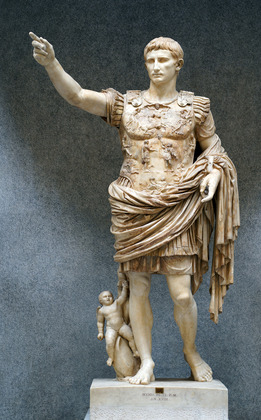
- the first Roman Emperor, Caesar’s nephew
- a piece of propaganda, about power essentially (oversimplification)
- connection to Classical Greece, idealized, not a continuation of the Veristic style
- made when Augustus was much older than he’s portrayed
- found within Livia’s (Augustus’ wife) villa
- original was probably a bronze
- shift in the style of art, away from veristic style, ==imperial style==
- breastplate shows a depiction of Rome and Parthia
- Parthia holds Roman standards (if they were captured, Rome had lost the war)
- Augustus retrieves the standards from Parthia, therefore no one ever rises to stand against or up to Augustus
- little baby at his feet is Cupid, sone of Venus, the God (Goddess?) of Love
Midterm: Ancient Greece and backwards (not including Paleolithic)
- the three pyramids (Egyptian religion, the three pharaohs, the construction, etc.)
- the Doryphoros
- mesopotamia (Persian empire, portrait sculpture importance)
- SmartHistory
Roman Architecture (after the Midterm)
“Architecture aims at eternity.” - Sir Christopher Wren
- important to distinguish that some of these buildings were for both public and private use
- Corinthian style architecture (taken from Greek Classical)
Arch of Septimius Severus, Leptis Magna. 3rd Century CE (Corinthian)
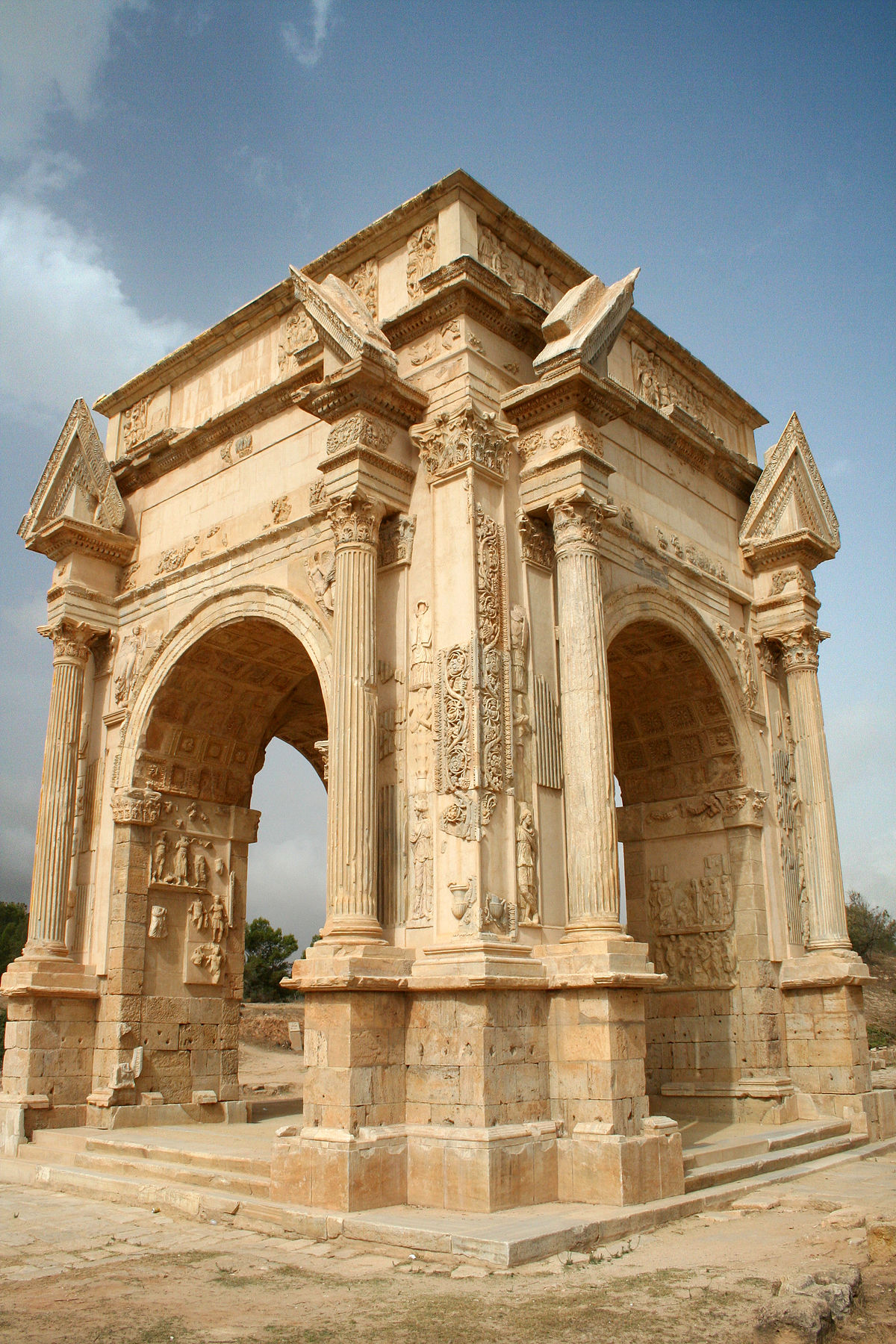
- Romans are more creative in the way they make architecture in comparison to the Greek as they do not just make it for religious purposes
- used for political purposes
- propaganda
- used architecture as a way of displaying power
- Roman architecture had three main elements
- beauty
- strength
- utility
- was used as a way to subjugate people that the Romans had conquered
- @@Projecting Power@@
- implies the power of the Roman Empire over the lands that the architecture has been built on
- when Rome went to war, they always brought architects
Four Aspects of Roman Architecture
Vault
4 arches that meet in the middle
- creates a larger, open space
- allowed for vast open spaces without the need of columns
Arch
Dome
Concerete/Cement
Baths of Diocletian, 300 CE
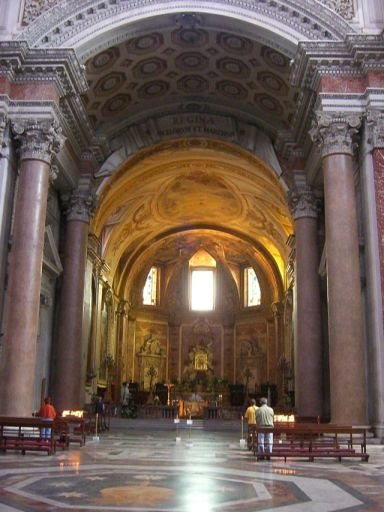
- vault
Aqueduct, Segovia. 50BCE
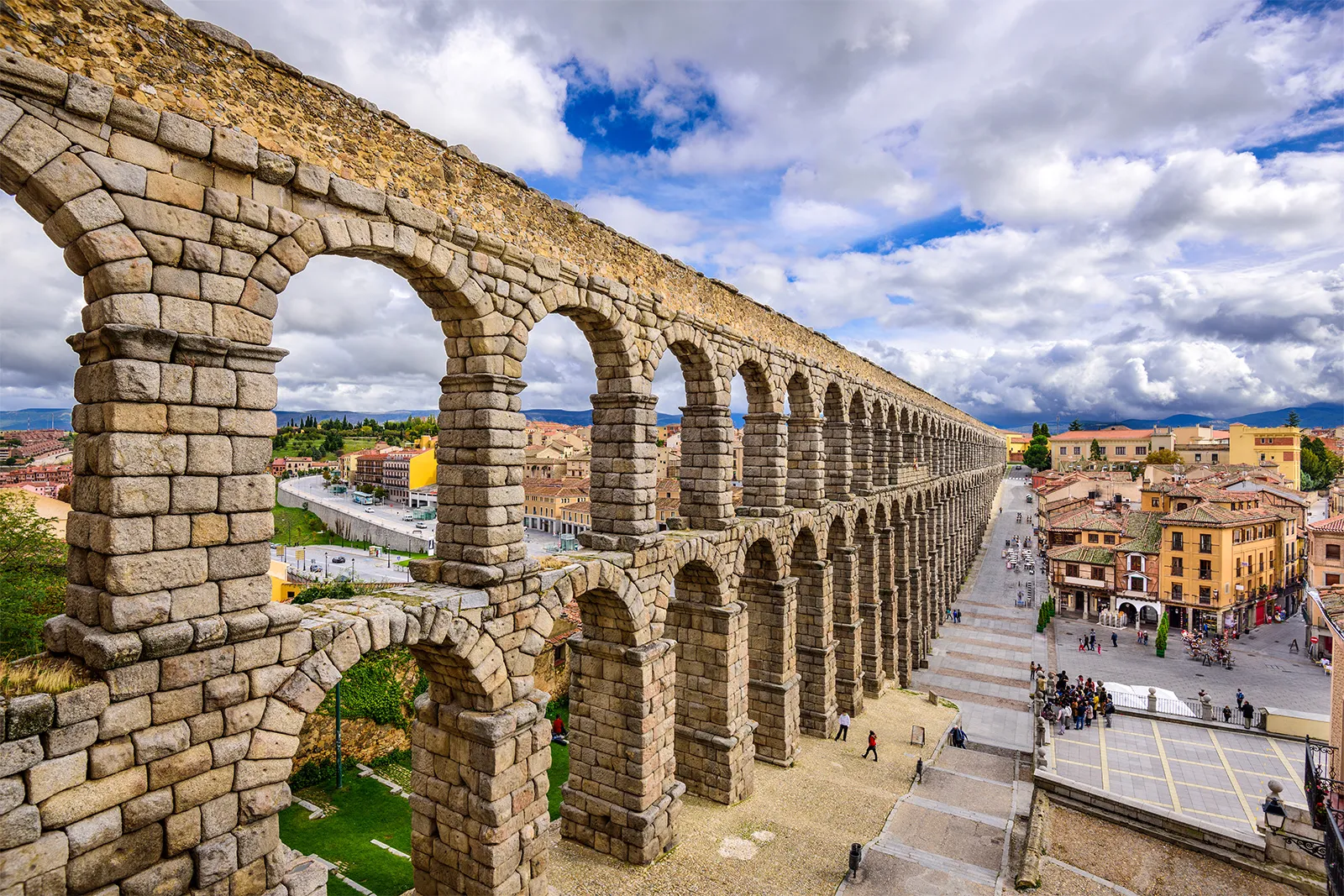
- arches
- brings fresh water down to the city of Segovia
- modern-day Spain
Dome of Pantheon, 126 BCE
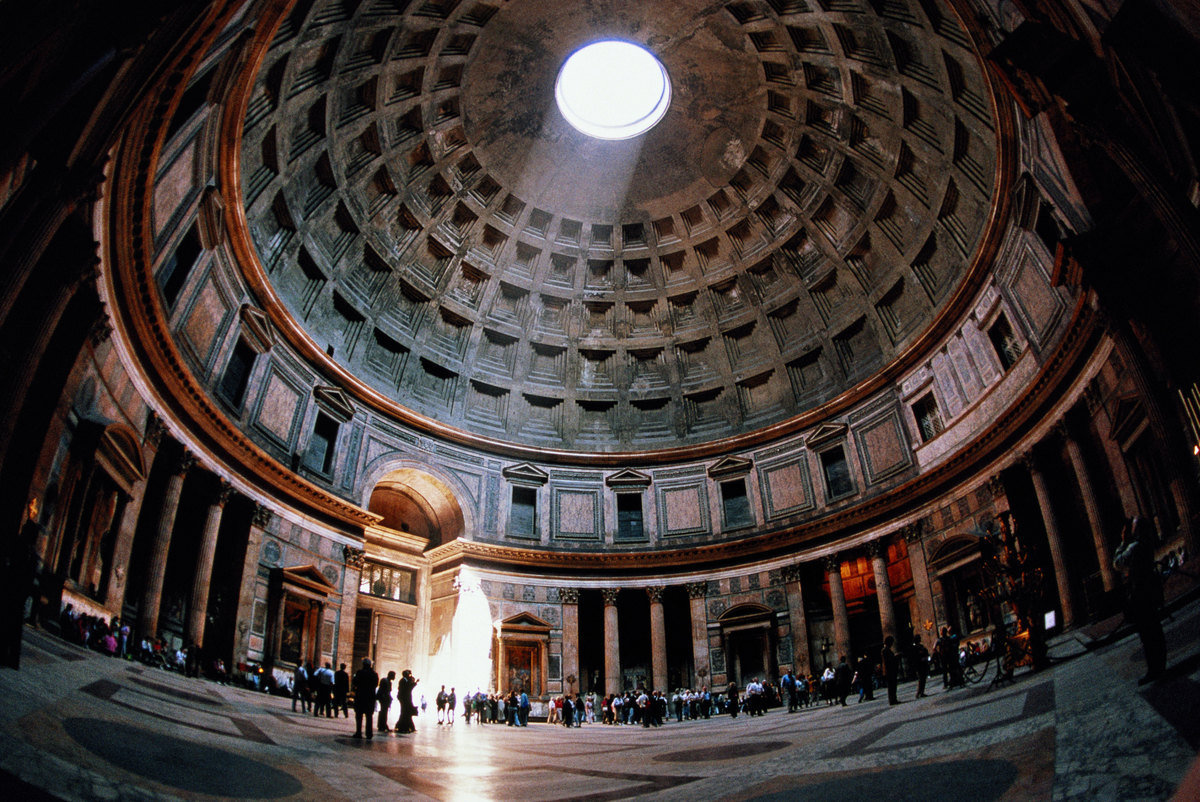
- the first enormous dome
Theatre Complex of Pompey, Rome. 55 BCE
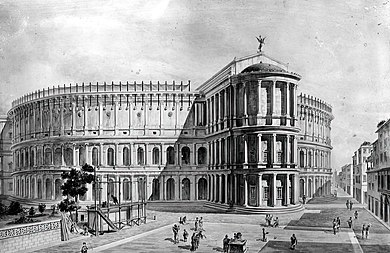
- Roman cement
- strength of cement gave Roman the ability to make more complication and intricate buildings with the same strength as the more simplistic buildings
- massive in size (colossal)
- paid for by Pompey for the people of Rome
- Romans begin to understand how strong the connection is between architecture and politics
Amphiteatrum Flavian (Colosseum) 1st Century, CE.
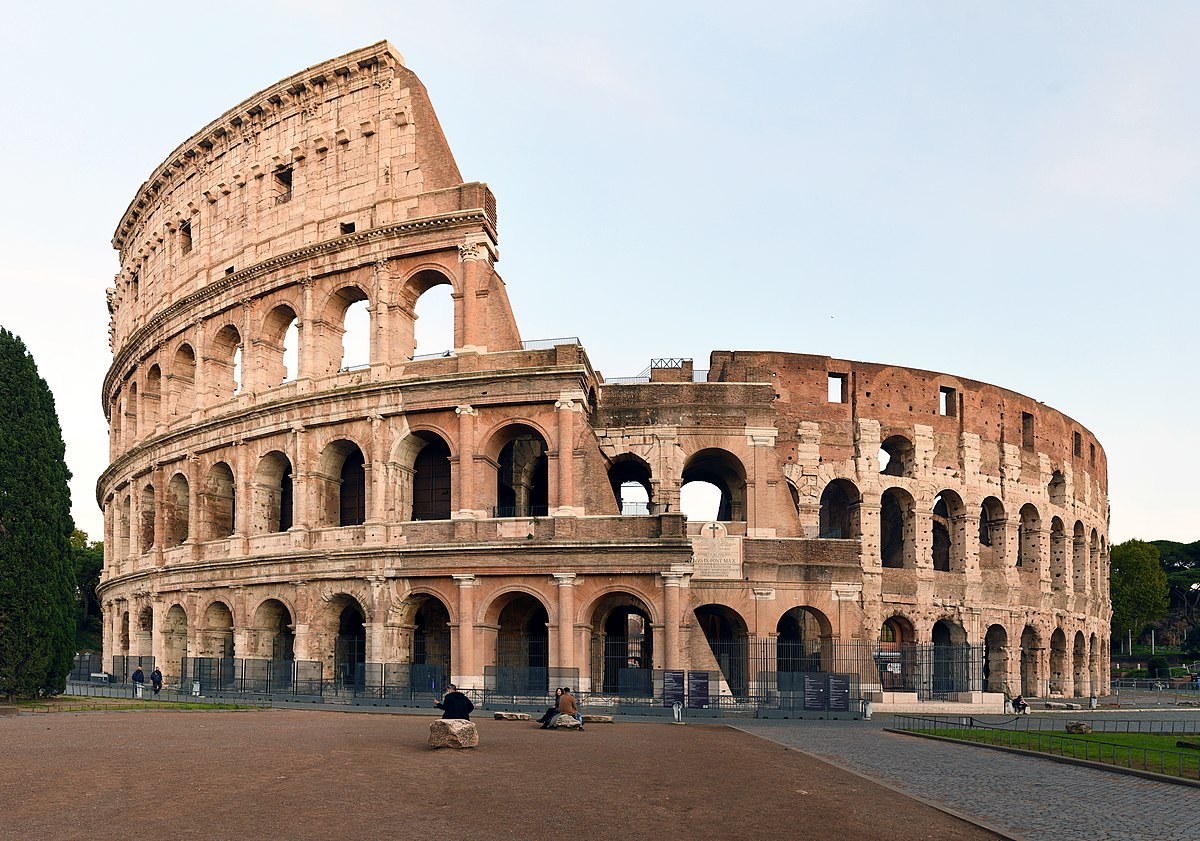
- Romans believe that public buildings must be the most beautiful and vast buildings
- the more someone paid for public buildings, the more they became important to the Roman people
- buildings become a cornerstone for Roman politics
- eventually turned into a church
Ara Pacis, 13 BCE
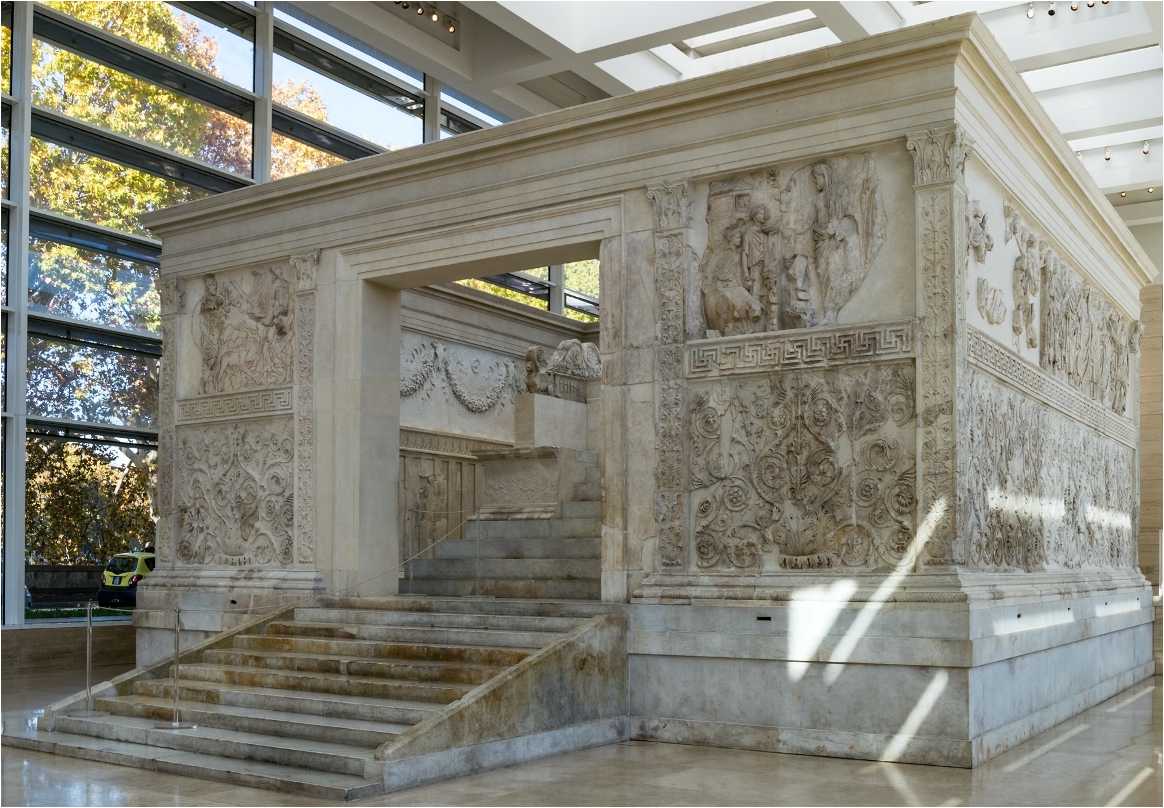
- coincides with the Augustus of Primaporta
- “The Alter of Peace”
- Augustus is seen as a bringer of peace despite the number of people he killed in wars/civil wars between Rome and Egypt
- serves as a religious alter for sacrifices and precessions
- propaganda cloaked in religion
- has the names of his lineage on the structure as who came next in line as the first Roman emperor was very important
- his step-son Tiberius eventually becomes emperor after him, his name is also on the structure
Roman Forum
==Roman Basilica== - courthouse
- secular building, served no religious purpose
free buildings, public
Arch of Septimius Severus, 203 CE
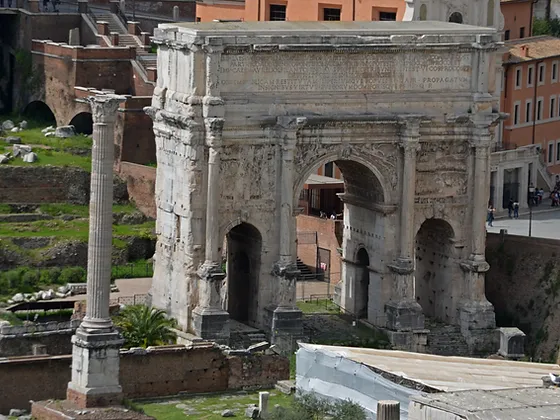
- permanent symbol of military leaders who won important battles
- speaks about a war against the Partheons
- propaganda
- connected to triumph
- had relief structures of Gods, war was justified with the Gods like the Greeks
- unlike the Greeks, they directly showed the battles rather than reliefs of Gods vs. Giants or Centaurs
Temple of Portunus, 2nd Century, CE
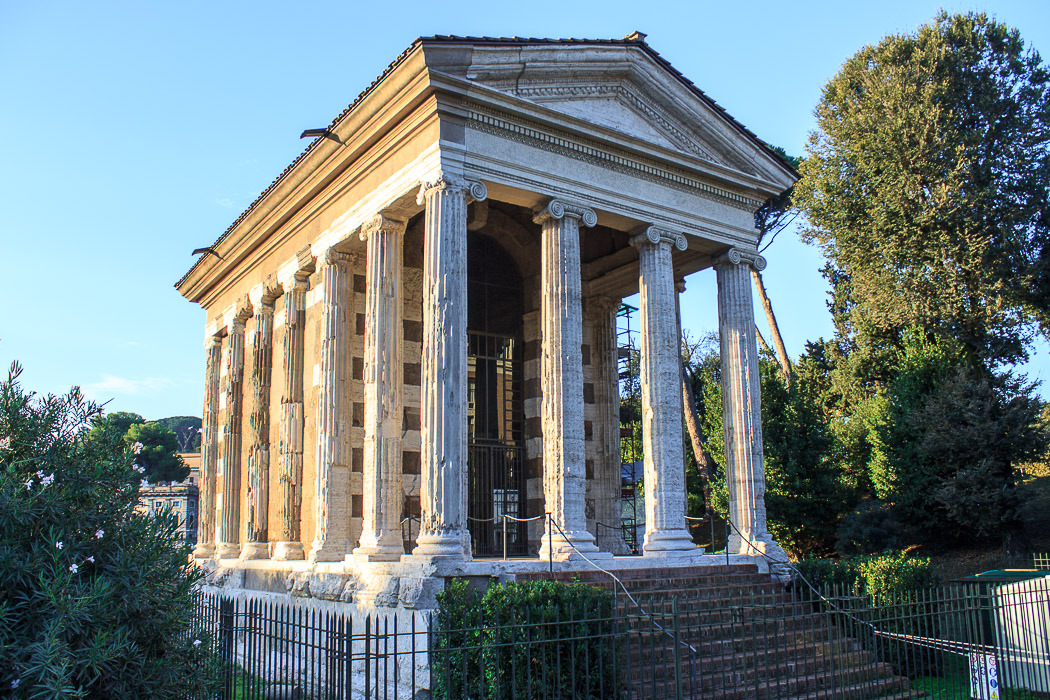
- Pagan, small because worship was done from the outside, only priests, priestesses and virgins were allowed inside
- ==cella== - most important religious space inside the temple
- ==freestanding columns== - columns that hold the weight of the porch (pronaos), load-bearing, not connected to the building at all
- ==engaged columns== - connected to the building, not very load-bearing, aesthetic consideration
- Portunus, God of the Port
Apollodoros of Damascus. 2nd Century. CE
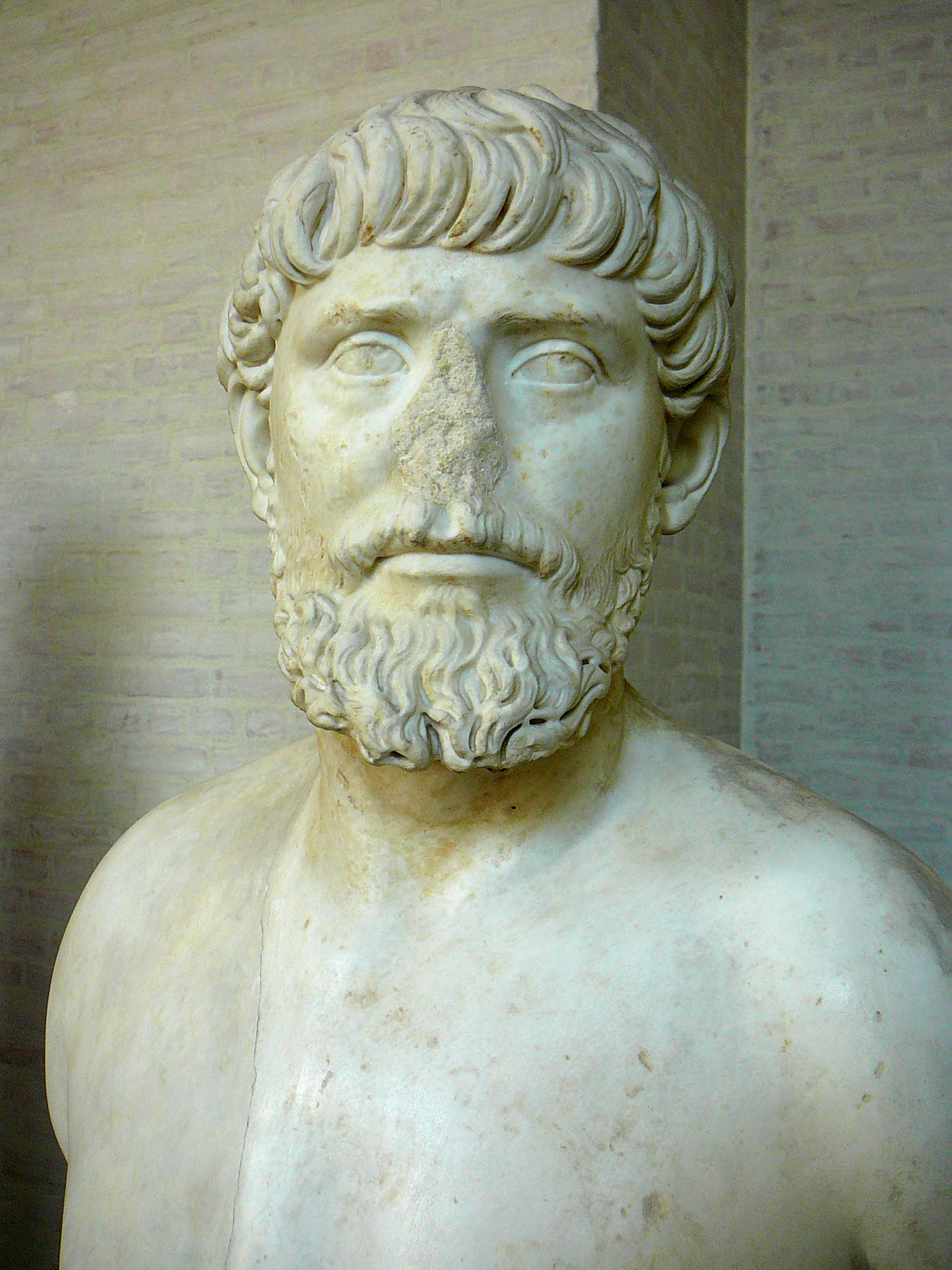
- architect, engineer, soldier
- at this point, Rome still thrived because of meritocracy (not primarily nepotism, gave the line of succession to the people who were best suited, who deserved it)
- works credited to Apollodoros of Damascus
- Column of Trajan
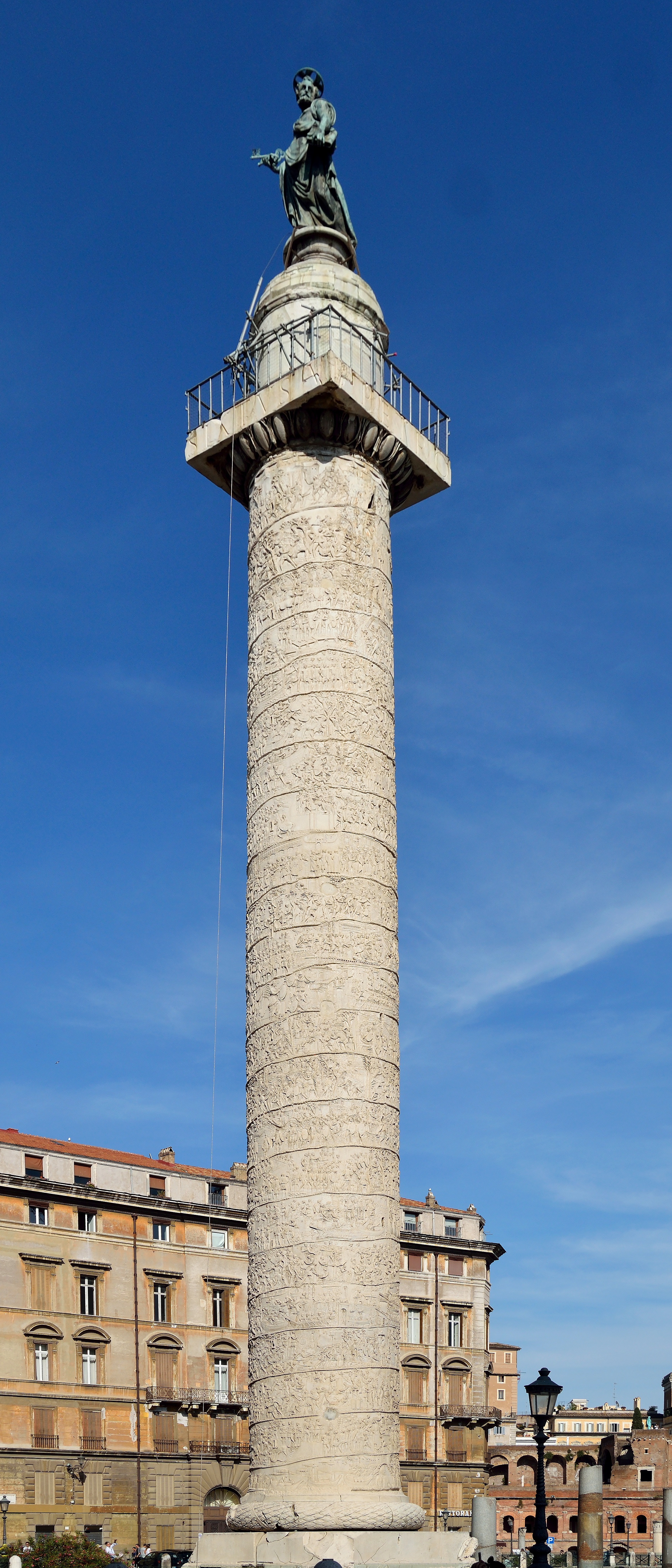
- tells the story of the Dacian campaign in its entirety
- at the top, originally had sculpture of Trojan as victor
- original sculpture was removed, melted down, and repurposed
- current sculpture is of Saint Peter
- figures of victory, gods and goddesses, all intertwined with the narrative
- Forum of Trajan
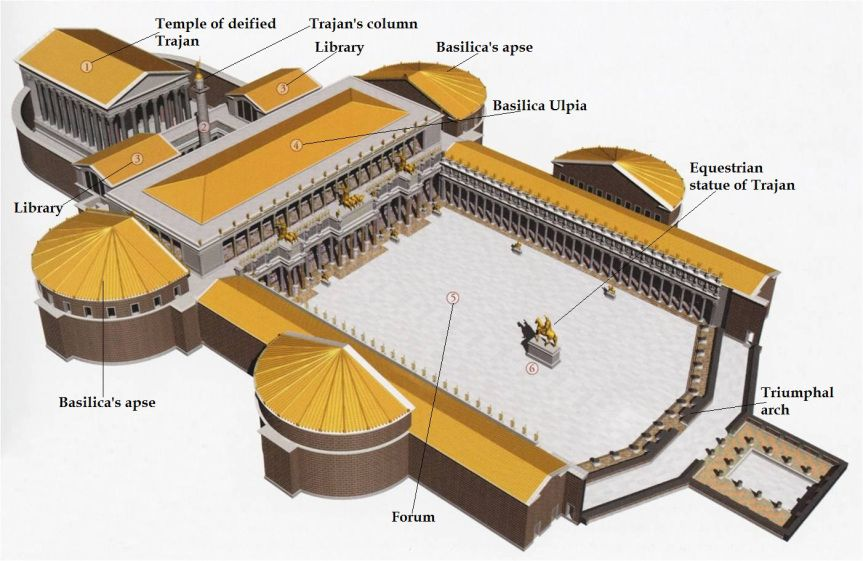
- public space, anyone could use these facilities, however the court was reserved for more important cases meaning not anyone could go to this court for disputes
- would’ve been constructed in marble with a large bronze sculpture of Trajan victorious in the center holding a Roman standard
- Markets of Trajan
- Baths of Trajan
- Temple of Trajan
- Trajan is the emperor who pays for all of these
- bridge across the Danube River
- bridge was destroyed
- used for troops to go over and go to the East to defeat the Dacians
Emperor Trajan, Reign 98-117 CE
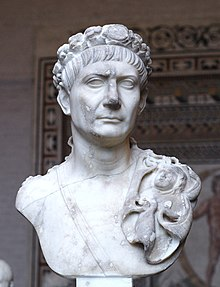
- warrior emperor
- most well known for the Dacian campaign (modern-day Romania)
- find gold and silver mines
- all this money was directly invested back into Rome for infrastructure
Emperor Hadrian, Reign (117-138 CE)
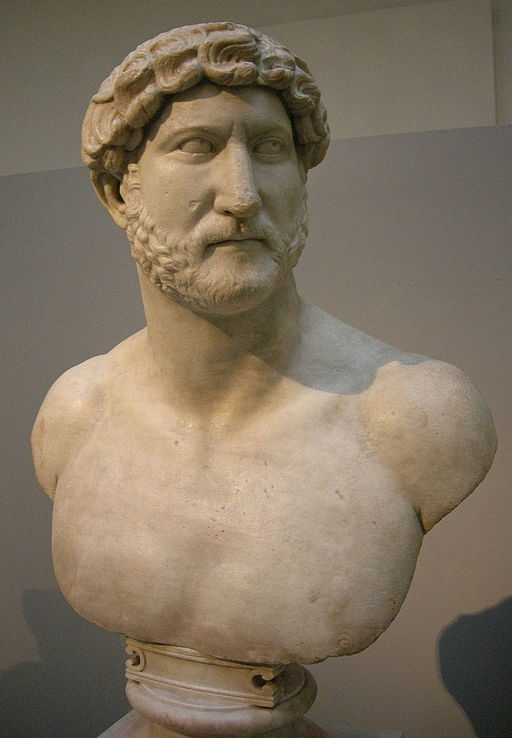
- Trajan’s adoptive son
- wore a beard, huge controversy, only Greeks and Roman soldiers wore beards
- was nicknamed “little Greek boy”
- was meant to be an insult but he loved Greece
- his villa was beautiful, strong, but it served no function
- this was his private villa, if it was attempted to be built in Rome, he might’ve gotten assassinated as his villa served no functional purpose, it just looked nice
- Antinonoeion, Hadrian’s Villa, 2nd Century, CE
- pseudo-Egyptian type architecture
Antinous Osiris, 2nd Century, CE
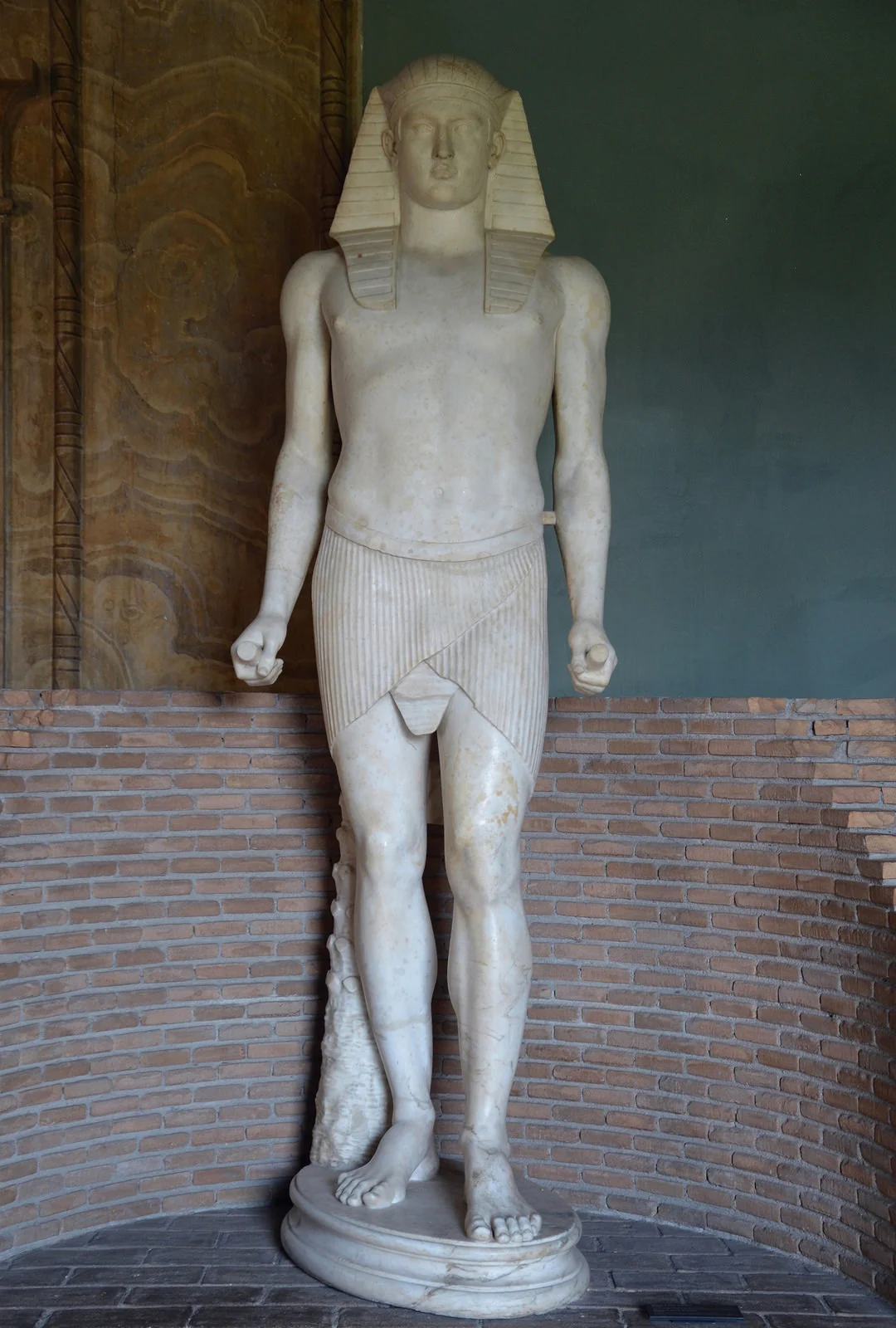
- a Roman sculpture of a Greek boy as an Egyptian god
- Antinous was Hadrian’s lover (non-Roman), drowns in the Nile River in Egypt
- as a result, Hadrian turns Antinous into an Egyptian God, names a city after him
<<Pantheon, Rome, 128-131 CE<<
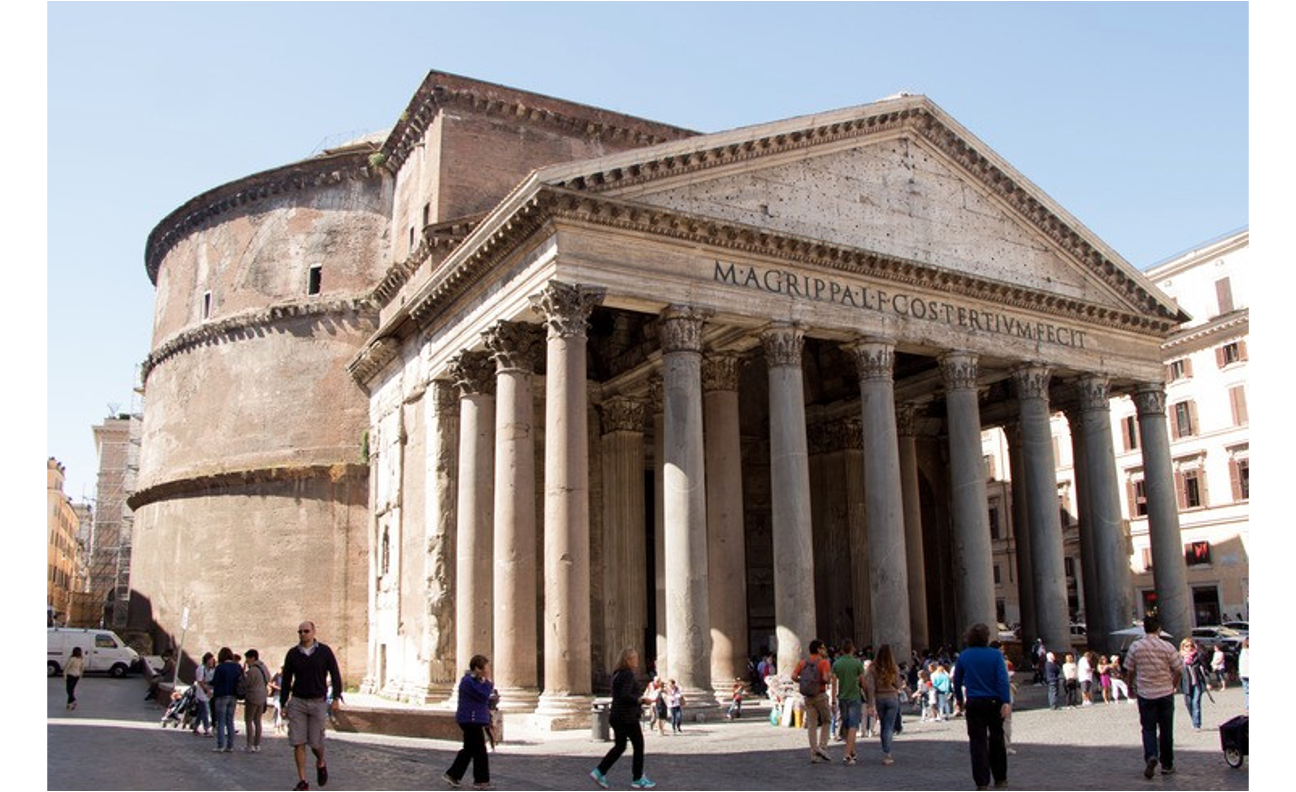
Apollodoros of Damascus was hired by Hadrian to recreate a religious building originally paid for by Marcus Agrippa after Trajan had wanted to, but died before he could accomplish this
public
pediment has an inscription, “Marcus Agrippa, the son of Lucius, three times consul, built this.”
- a way of honoring Marcus Agrippa, a hero in the canon of Roman history
- humbles himself by not putting his name on the buildings
originally, it was completely covered in marble
the dome was enormous and incredibly hard to construct, all done by hand
how and why it was managed to be constructed perfectly spherical (three innovations that helped the dome remain standing for so long)
\
- ==oculus== - allows light to come into the building, removes the weakest part of the spherical dome, no weight to hold this part down, connected the temple to the celestial world
- the sphere represented the concept of the entire Earth
\
- cement, cement is heavier as it goes down to keep the dome up, and has kept the dome up for centuries
\
- coffers - ==coffered ceiling==, served to take the weight out and make the heavier cement of the dome lighter
the shape was connected to divinity, as these shapes were perfect
was constructed to honor all the Pagan Gods of the world
Late Gothic into Early Renaissance
==Renaissance== - a rebirth of classical ideas
- all encompassing, has everything to do with art, literature, and politics
- writings shift from Latin to Modern Italian
- manages to be the beginning of modernity
- leaving the idea of one king and the power of the pope, of the sanctity of Roman Catholicism (Christianity), begins to be impacted by paganism
- different political organization
Gothic Art
Madonna Enthroned with Angels and Prophets, Cimabue. 1280
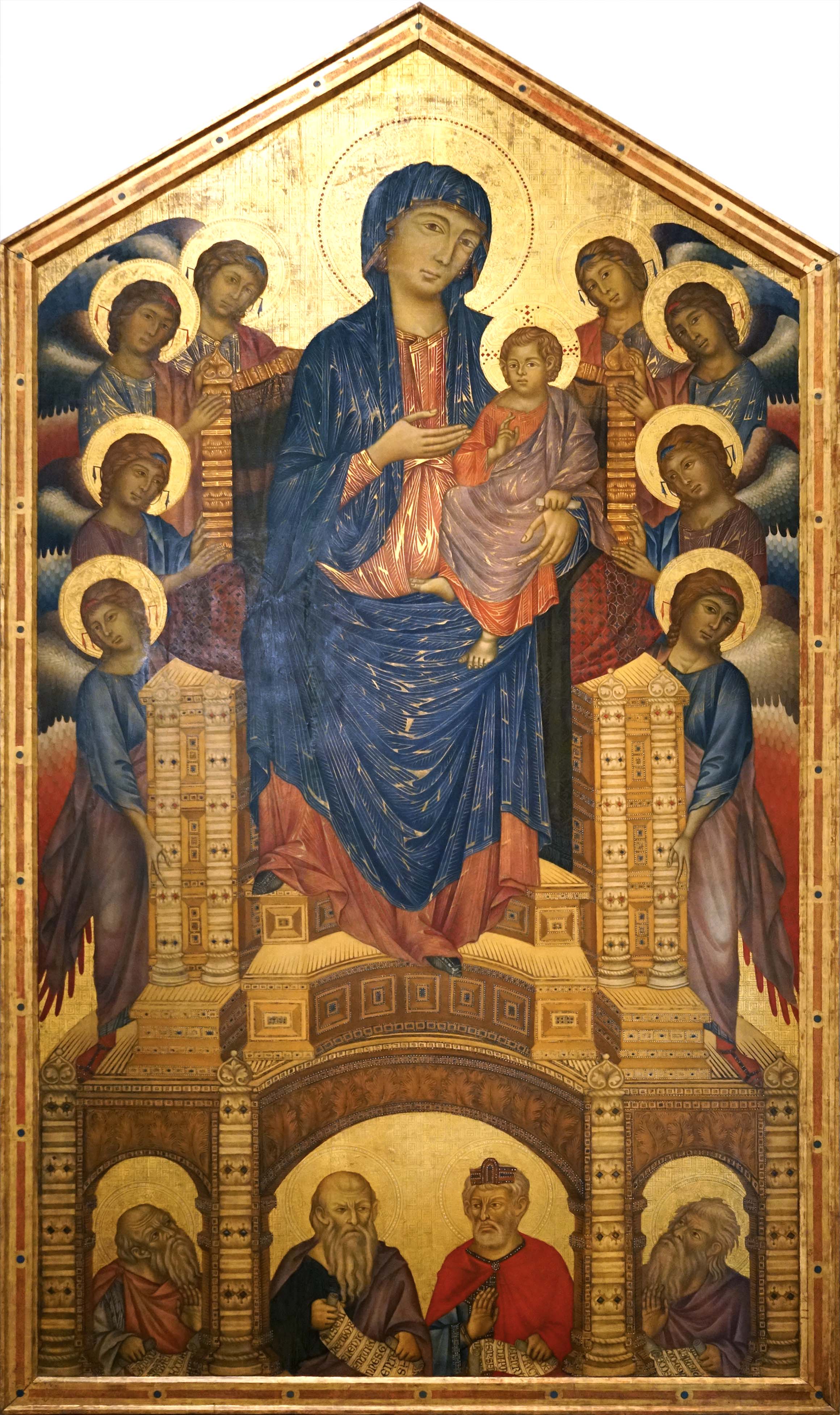
- painting
- symmetrical, lacks a sense of 3-Dimension
- very little individuality, some depth in the architecture, but flat in the background
- gothic painting is quite flat
Madonna Enthroned, Giotto. 1310
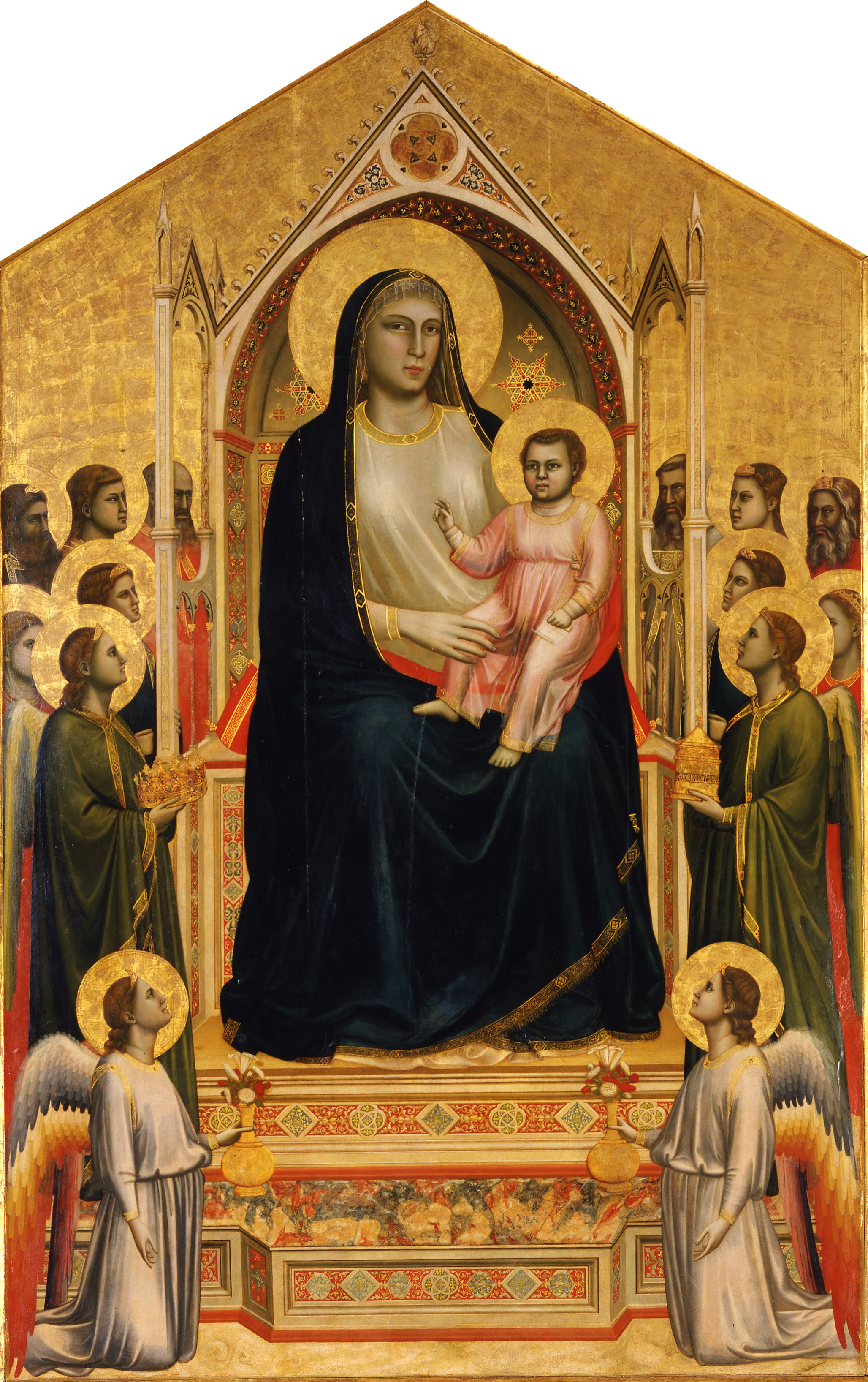
- painting
- similar in style to Cimabue except;
- Mary is more naturalistic and far larger, takes up more space, the painting has more depth to it, more 3-Dimensional
Saving Myra from Famine, Ambrogio Lorenzetti. 1332
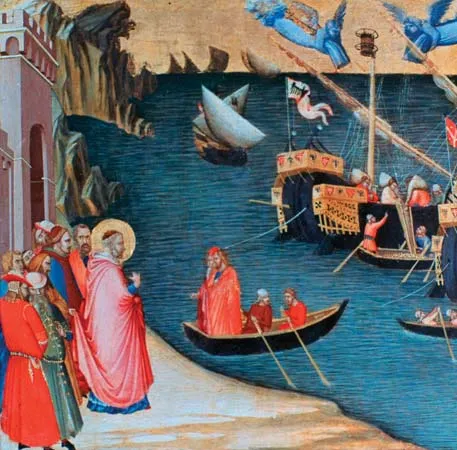
- Biblical theme, Saint Nickolas saves people from a famine
- more color, linear perspective, however it doesn’t make much sense
- figures are all different sizes, boats are off, buildings are slanted and different sizes, etc.
- the ability to create space is not there yet
Peaceful City, Ambrogio Lorenzetti, 1338
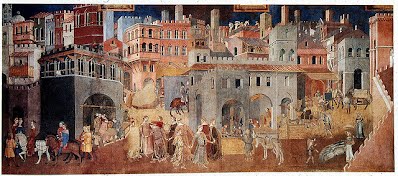
- interest in depiction of civic/political life
- discussing the lives of the people in Sienna, peaceful, organized
- the attempt to create space and dimension but only partial success
Madonna Enthroned with Saints, 1387. Agnolo Gaddi
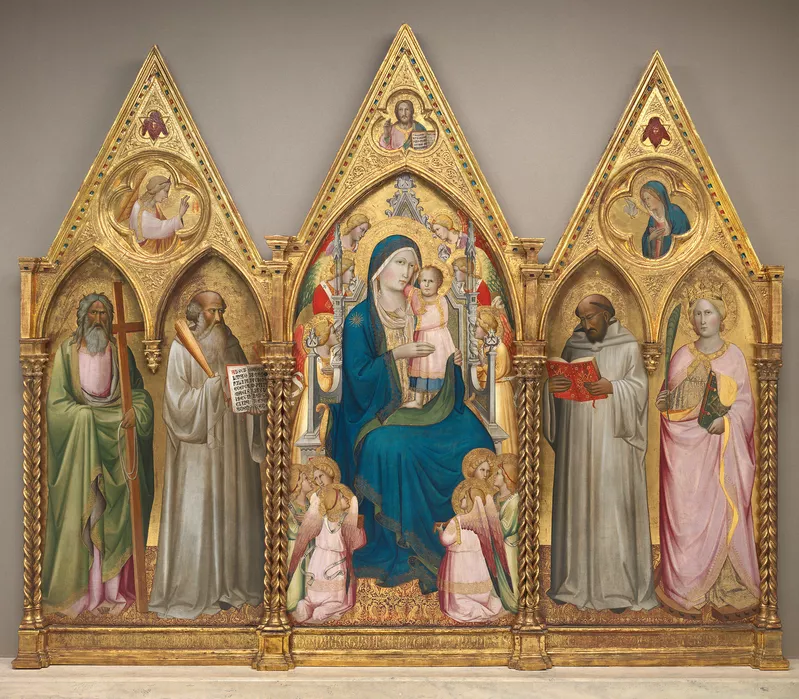
- more natural, clothes are draped, faces are more detailed and realistic
Lamentation (Scrovegni Chapel), Giotto. 1305
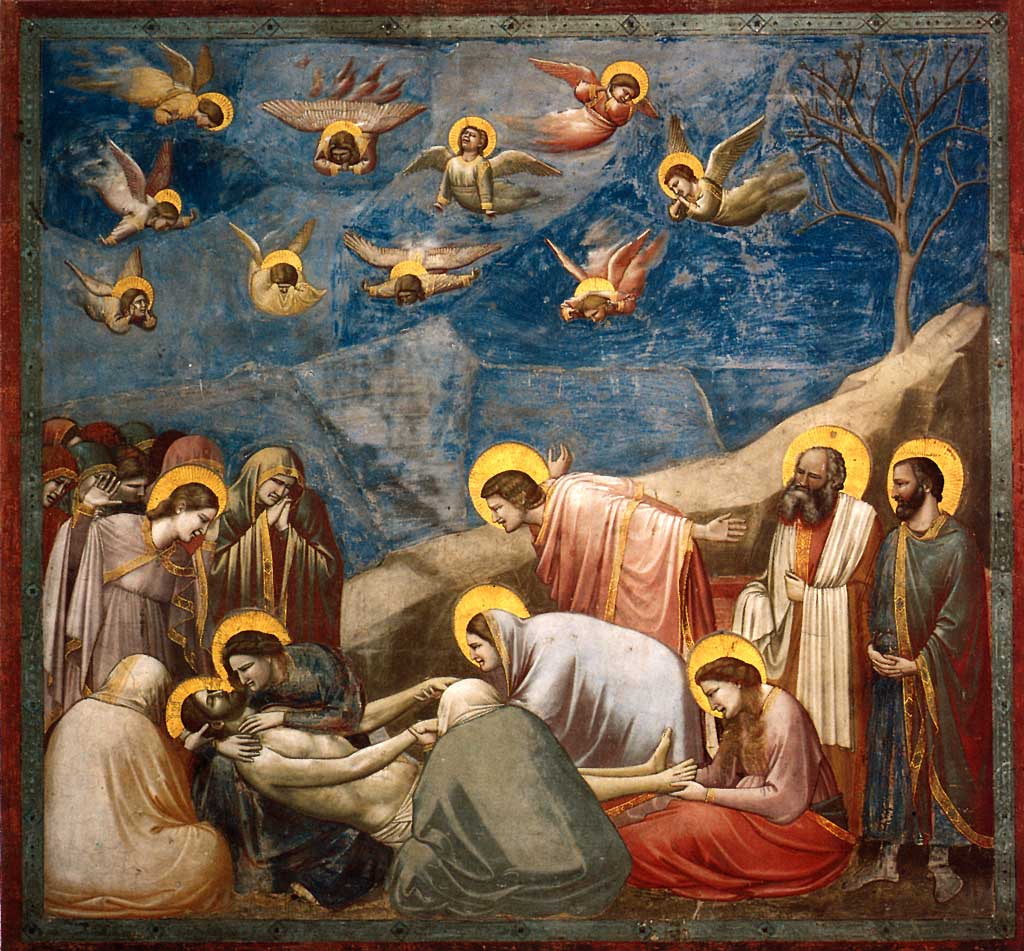
- ==fresco== - sketching first before filling in the colors
- shows a sad scene, people mourning over the death of Christ
Annunciation, 1435. Masolino
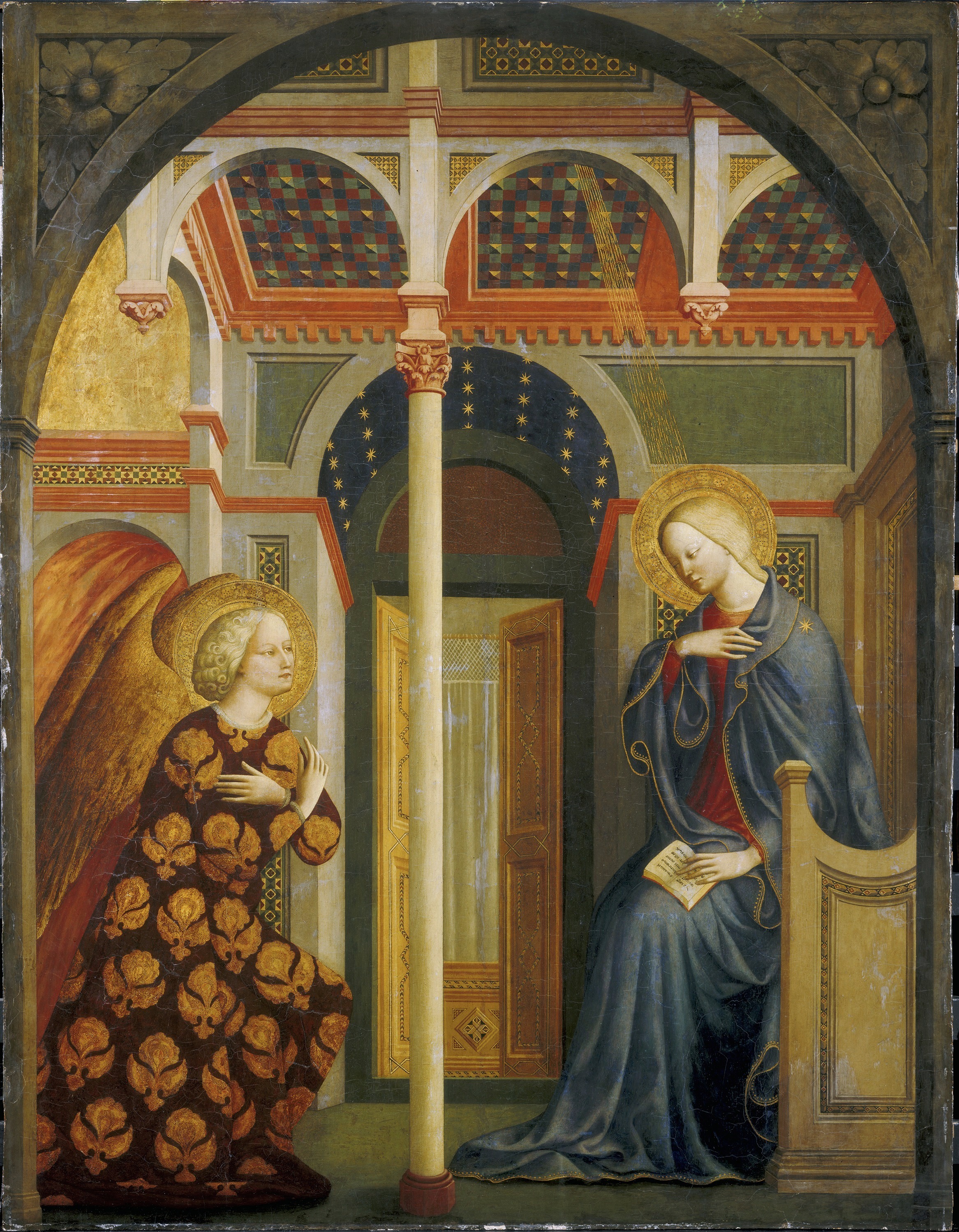
- the space behind the figures looks 3-Dimensional
- ==linear perspective== - how artists manage to create a believable 3-Dimensional space on a flat 2-Dimensional surface
Cosimo de Medici
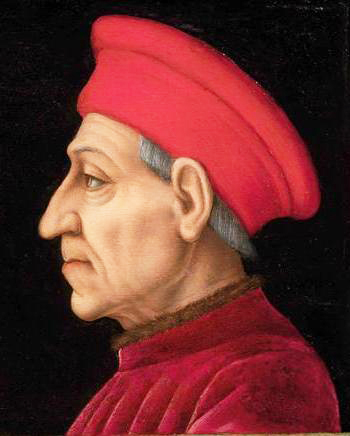
- rise of patronage in the Renaissance, people pay to have paintings made
- one of the people who hires Renaissance painters to paint him
- invests very seriously into the arts and letters (interested in philosophy and recovery of lost manuscripts)
Renaissance Art
Main Focuses:
- Masaccio - Painting
- Donatello - Sculpture
- Brunelleschi - Architecture
Masaccio - Renaissance Painting
Holy Trinity, 1427. Florence. Masaccio
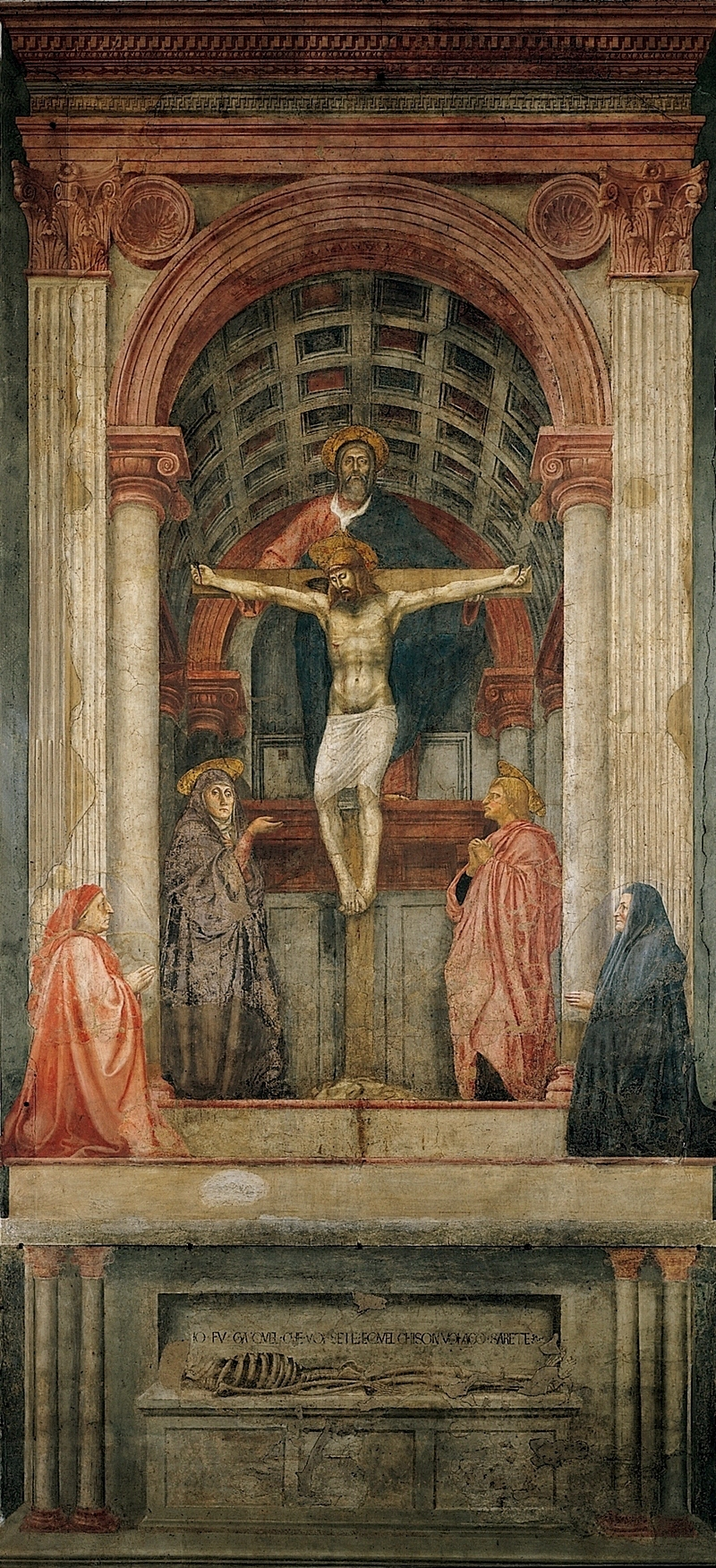
- understanding of depth
- compared to earlier paintings, its darker (not as vibrant)
- fresco painting, paid for by patrons, two patrons depicted in the painting (sitting outside of the space the biblical figures are occupying)
- architecture is organized
- ==chiaroscuro== - light and dark
- at the bottom, ==memento mori== - reminder of death, “you will die”
- inscription says in Italian, “that which you are, I was, and that which I am, you will become.”
- creates a full narrative
- linear perspective
Brancacci Chapel, Santa Maria Delle Carmine, 1425. Florence
- partnered with Masolino
- all about the life of Saint Peter
Expulsion from the Garden of Eden, 1425. Masaccio
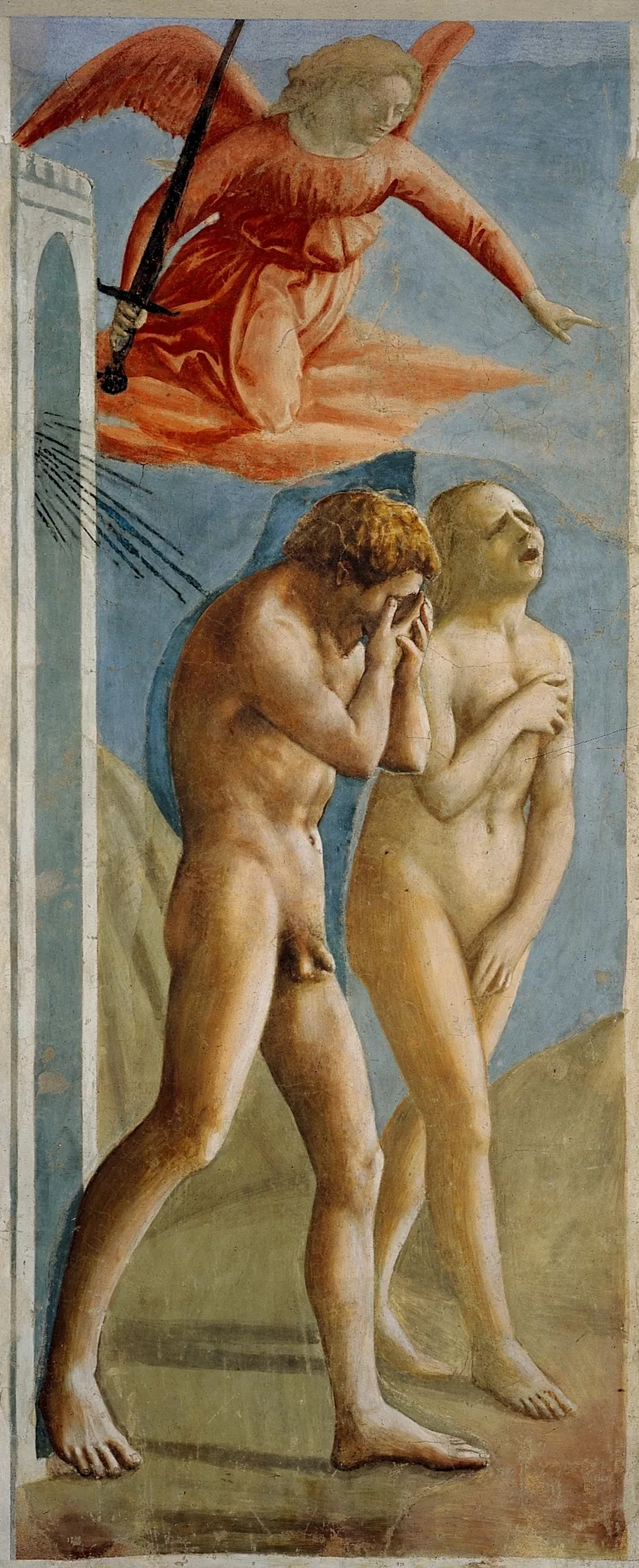
- chiaroscuro in the depiction of 3-D objects using light and shadow, shown in the shadows that are casted on both the ground and against Adam and Eve’s bodies, the parts facing away from the light source are darker than those facing the light source
- more pathos, heavily emotional, figures are more believable
Tribute Money, 1425
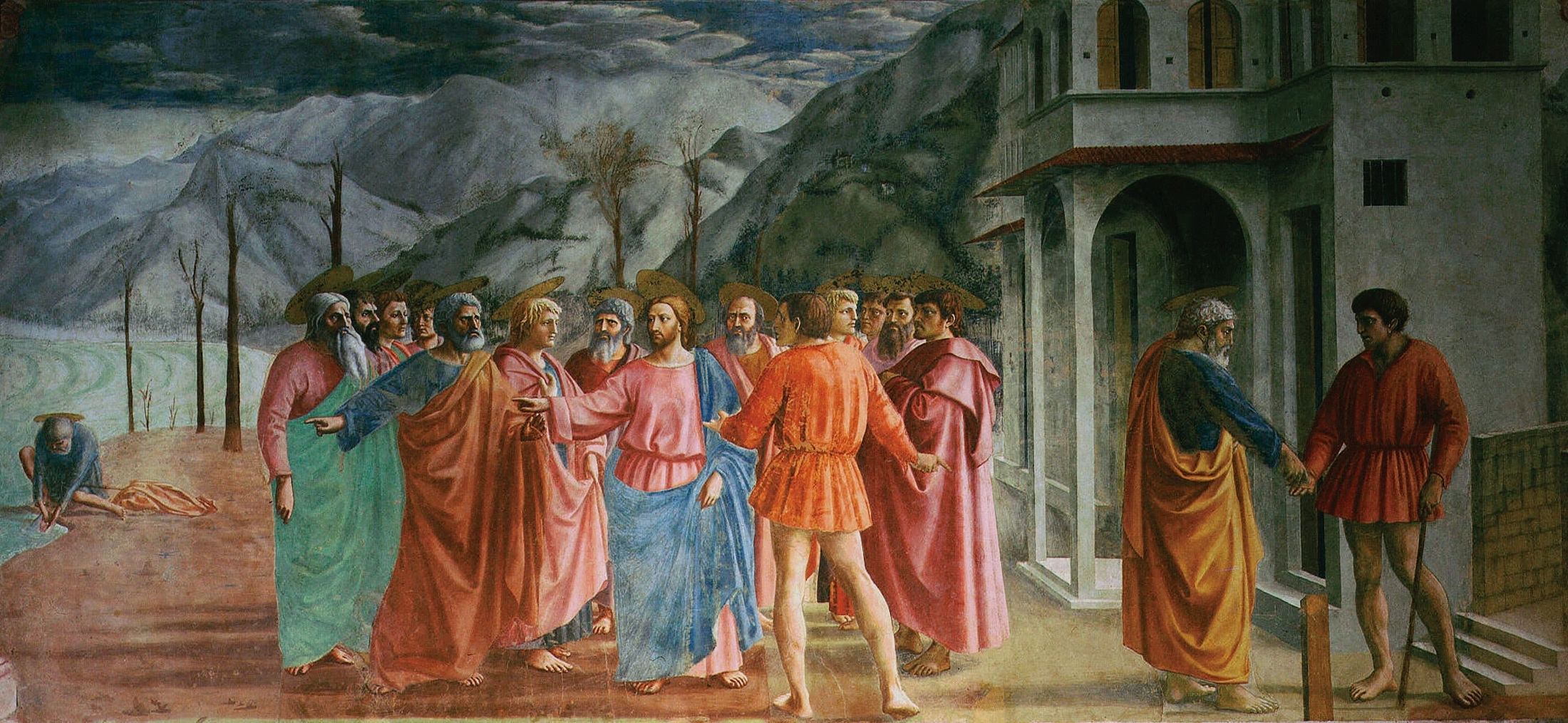
- ==atmospheric perspective== - less detail and value to create the appearance of depth
- deals with distances that are further away
- Saint Peter in orange and blue, Christ in red (pink) and blue, halos like a plate rather than flat behind their heads
- Renaissance in painting, Gothic in organization
Adoration of the Magi, 1420. Lorenzo Monaco (Late Gothic, Early Renaissance)
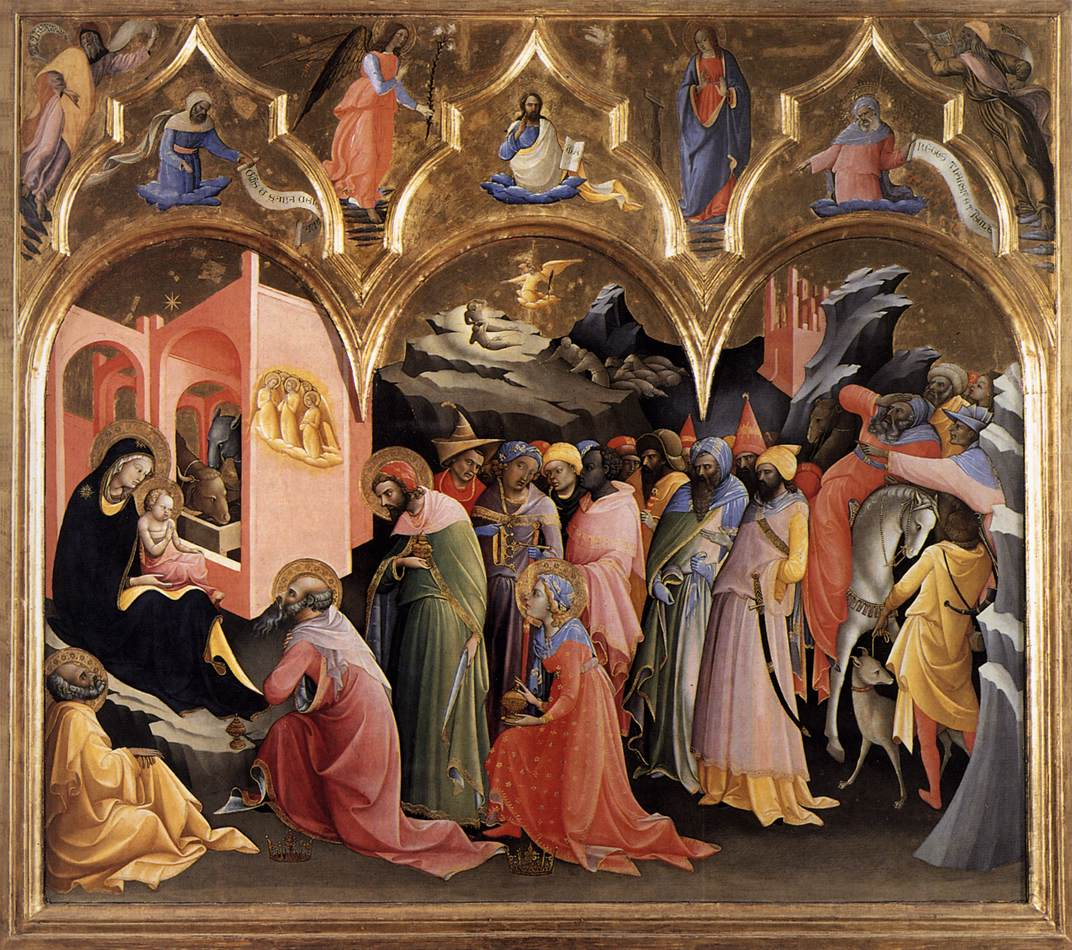
- conservative painter, looks more like the Gothic paintings rather than Renaissance paintings despite being made during the Renaissance era (first Renaissance building has already been constructed by Brunelleschi)
Adoration of the Magi, 1423. Gentile da Fabriano
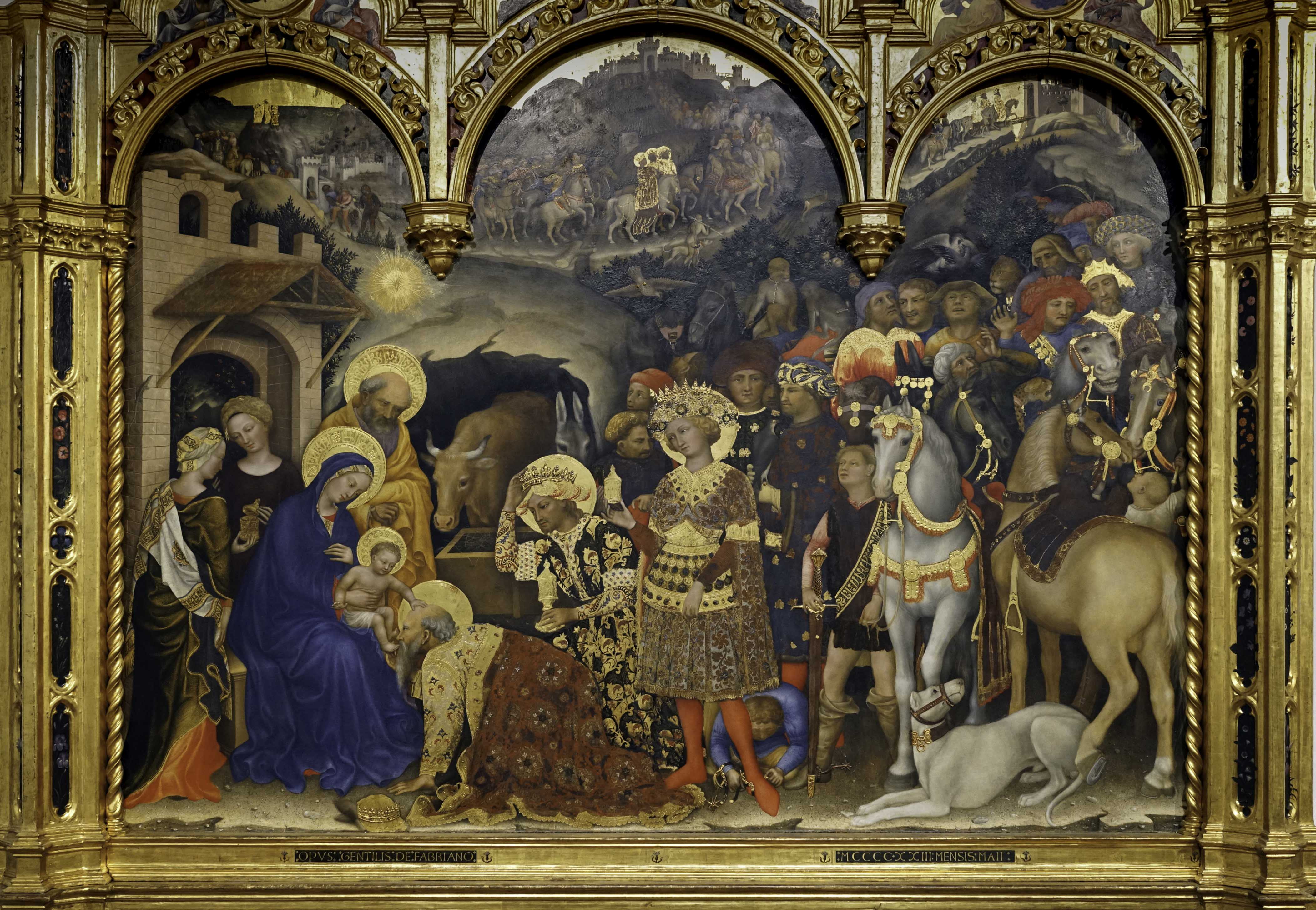
- less Gothic in comparison to Monaco’s
- huge shift in the way the arts deal with visual culture, architecture makes more sense
Donatello - Renaissance Sculpture
Pazzi Madonna, 1425
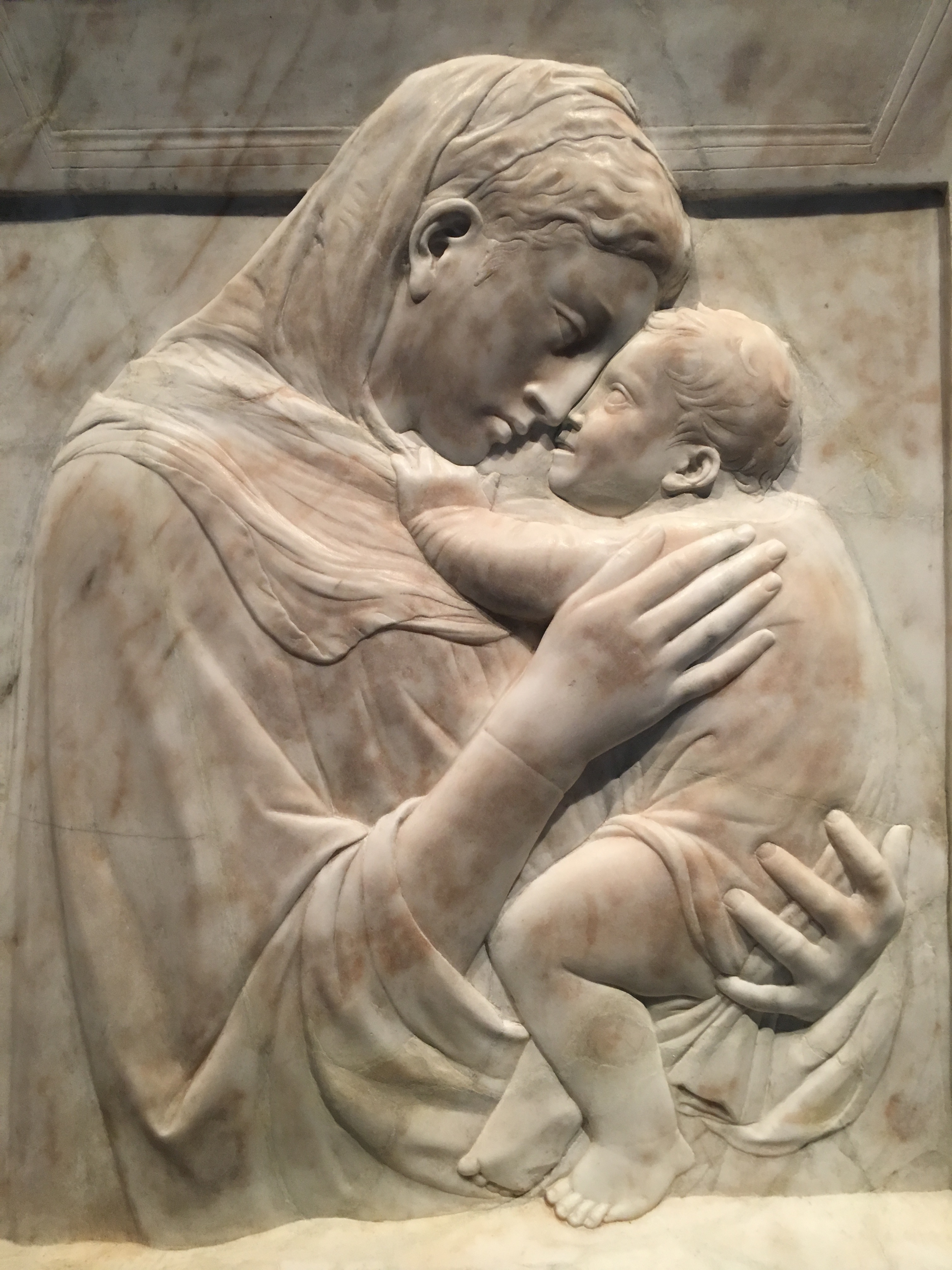
- relief sculpture, tender moment between a mother and child
- naturalism in the emotional element
- ==stiacciato== - extremely subtle type of flat sculpture
St. George, 1415
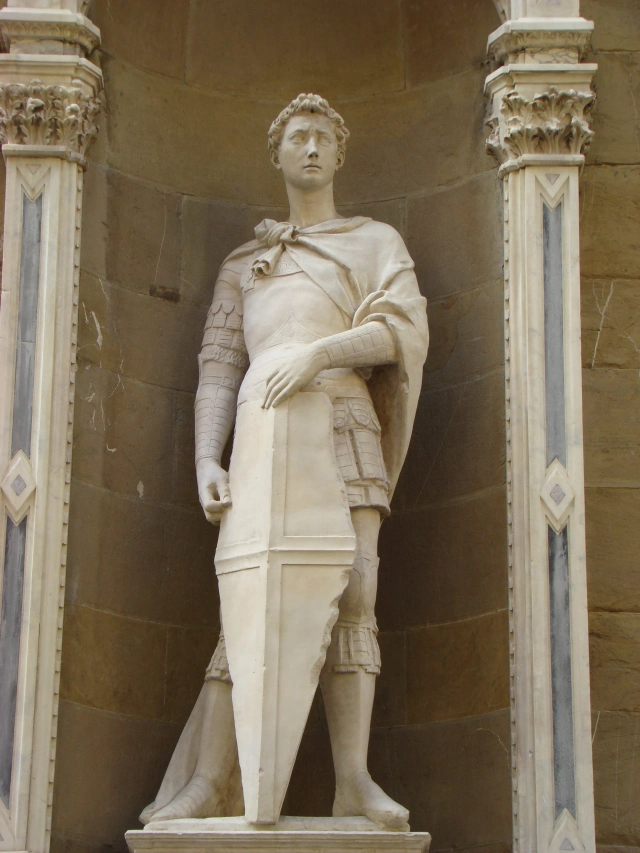
Gothic sculpture, elongated figure
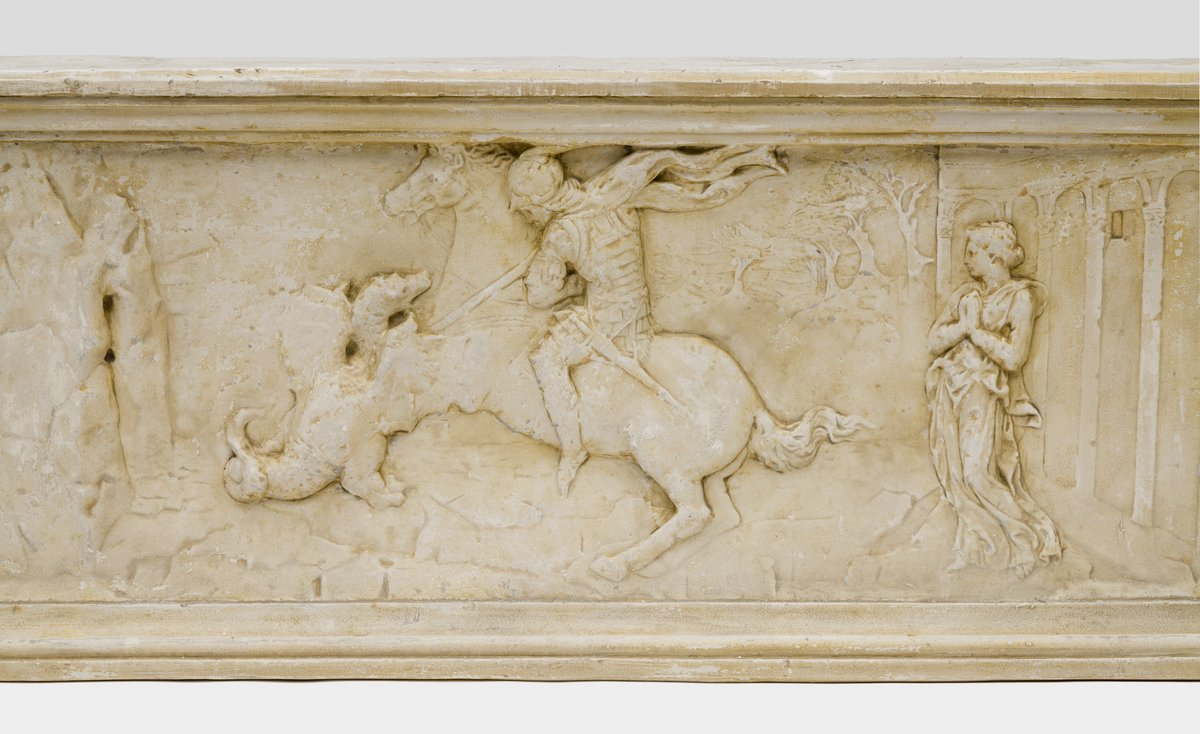
Renaissance stiacciato underneath the Gothic sculpture
shows a shift, even just in one sculpture, from Gothic to Renaissance/classical
David, 1408
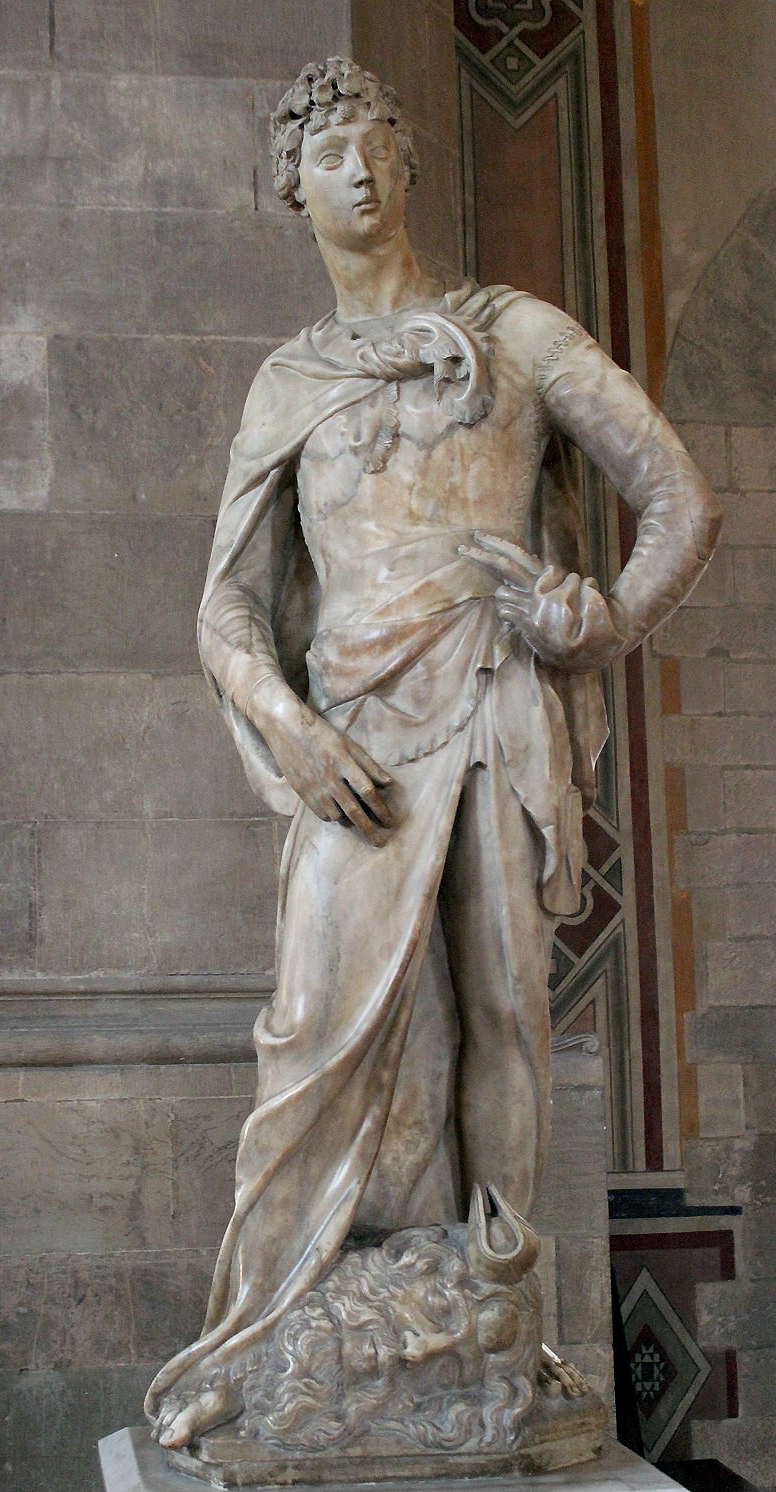
- a sculpture of David standing over the head of Goliath
- stiff, youthful, victorious in his posing
- Florence unofficially adopts David as the symbol of their city (Italy is not unified in this time period), as they see themselves as the David in their own story (small city-state in comparison to other superpowers like Genoa)
The Prophet Habakkuk, 1423
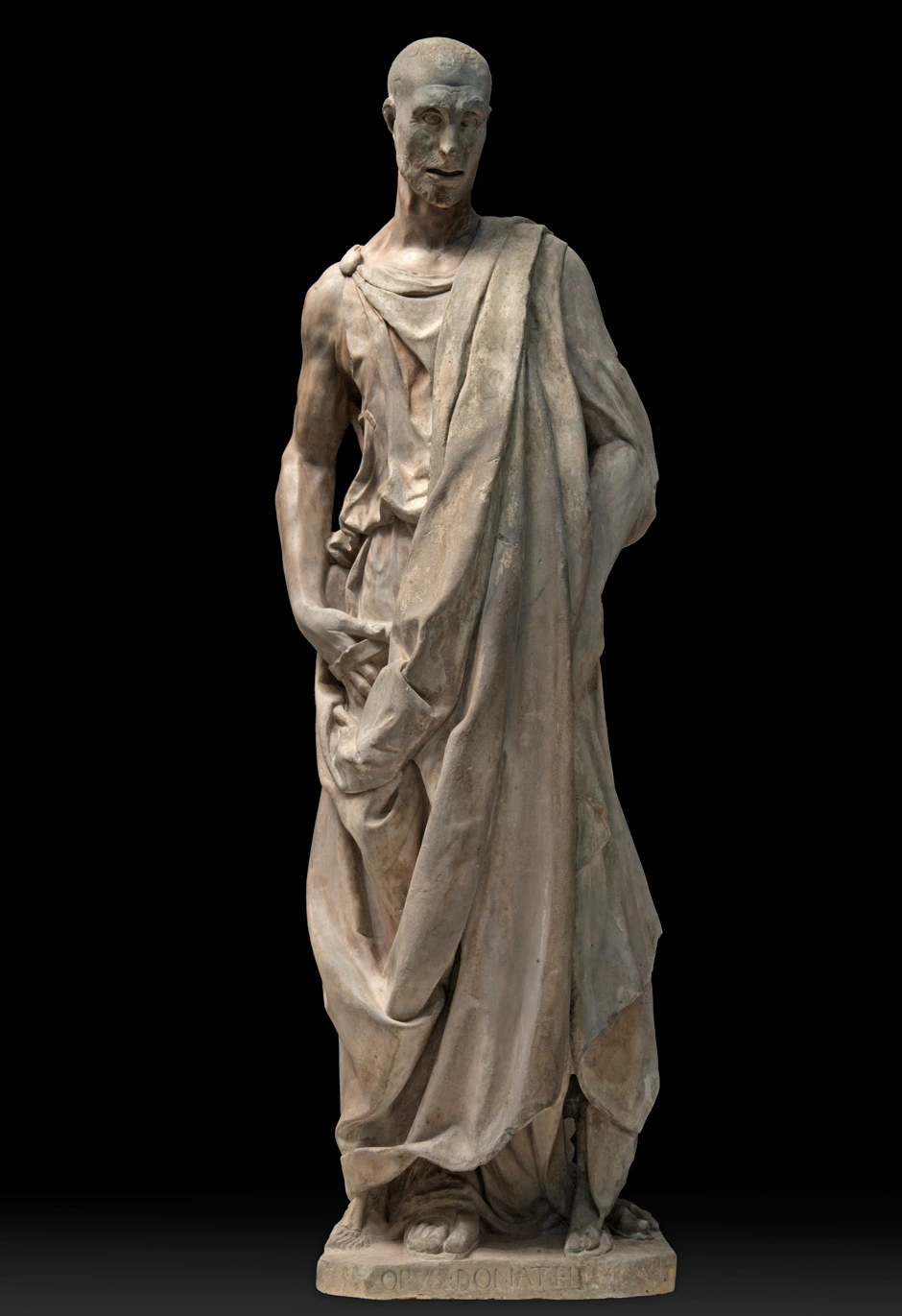
- placed up high, viewers had to look up at it to view it
- Donatello thought about the viewer’s POV
- ==di sotto in su== - “from the ground looking up”
- fabric is deeply carved, not delicate, very exaggerated
- understood that the perspective called for excessive detailing/exaggeration
- head size is disproportionate, drapes are sculpted in an exaggerated manner, etc.
Feast of Herod, 1425. Baptistery Siena. Donatello
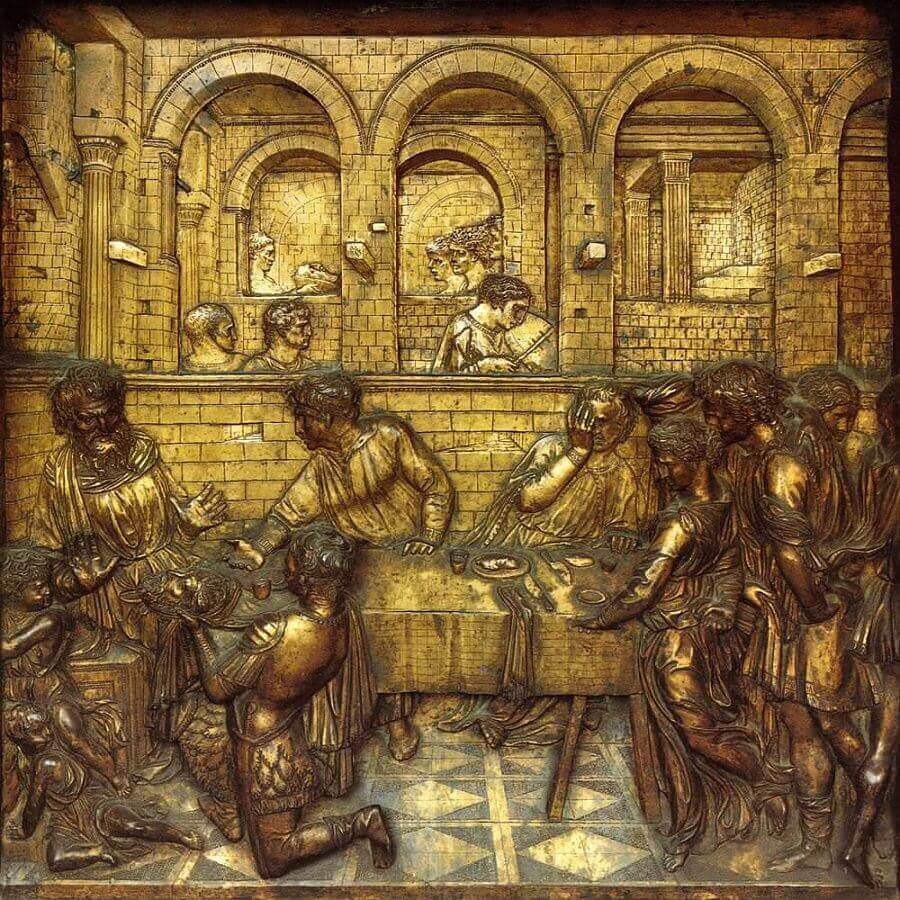
- bronze, first bronze sculpture since Roman antiquity (technique was lost)
- linear perspective in the lines moving back and towards the middle of the piece, getting smaller as it gets closer to the center
- atmospheric perspective in the background, three rooms behind, less detailed
- theme: Christian theme, King Herod brings in the head of Saint John during a feast after his niece requests it
David, 1445. Donatello, Florence
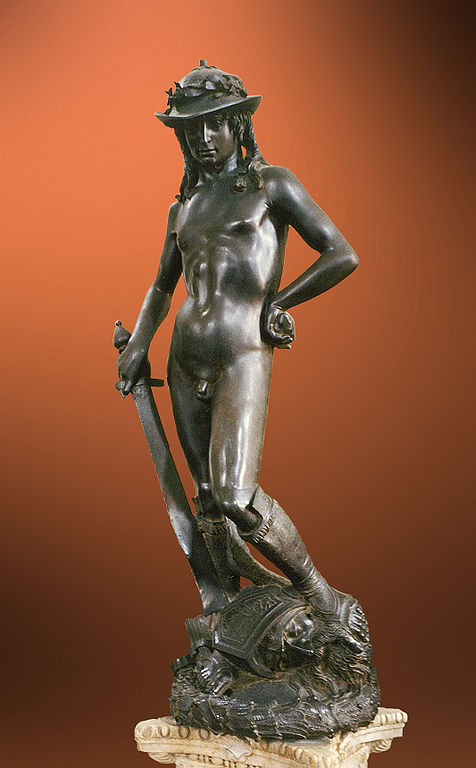
- bronze, 5 or 6 feet
- more dynamic, lithe, soft, languid in his body shape (not a powerful figure, young adult), in the nude (borderline sensual), usage of the contrapposto (Doryphoros), uses classical themes
- these are new ideas, shifting ideas
- Florence is no longer a Gothic, Christian city, fused with classical antiquity
- Pagan art is beginning to resurface (wreath on his head represents victory), depiction of a Biblical figure
- paid for by the Medici family, made for private decoration, placed in their private home
- naked sculpture, almost sexual in nature, wearing boots, a hat, and nothing else
Andrea Del Verrochio - David - 1465
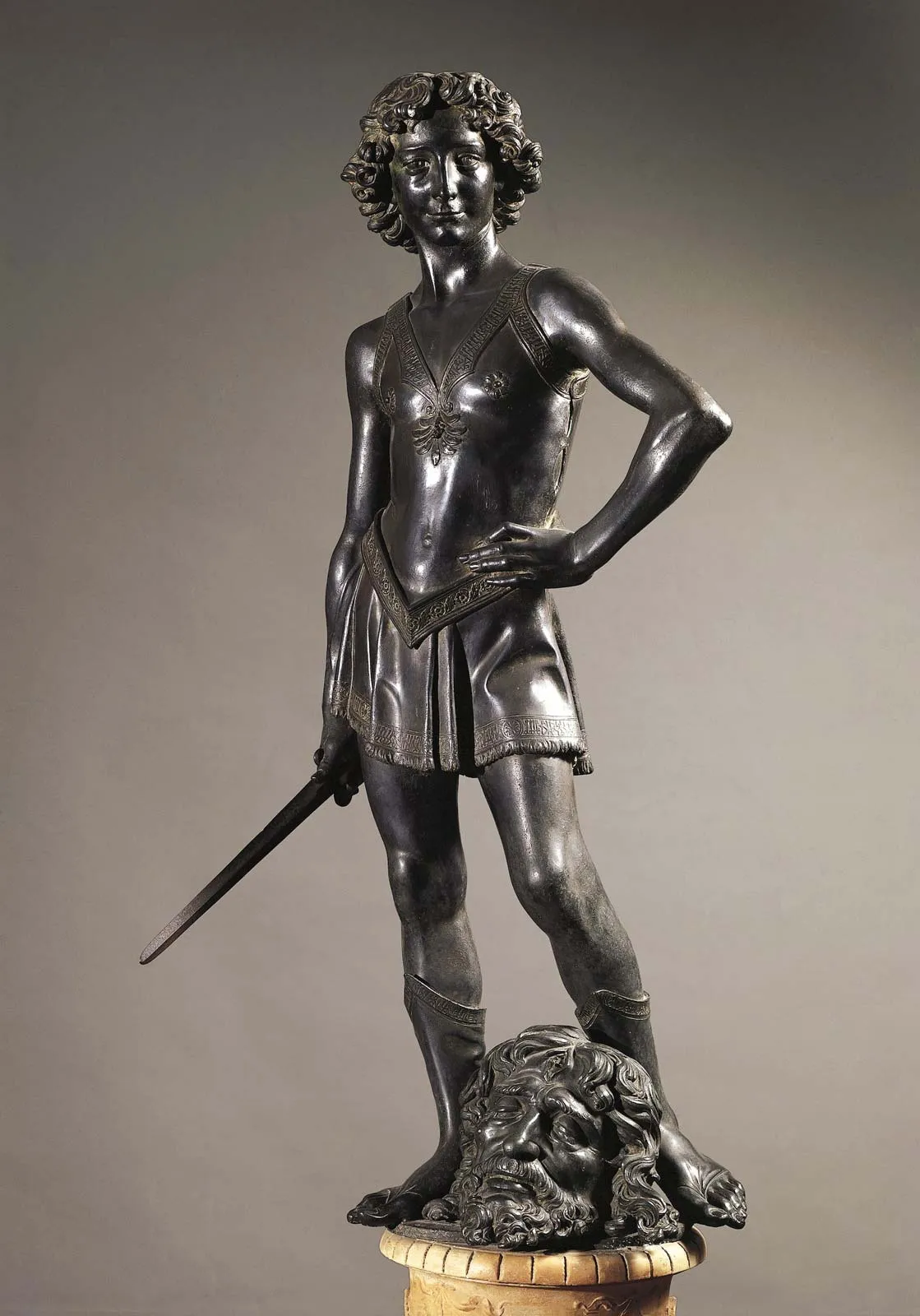
- not completely naked, covered up in comparison to Donatello’s David
- is clothed but barely, armor doesn’t look like it’s meant to protect, very fitting, underlines anatomy
David, Michelangelo 1501 (Florence)
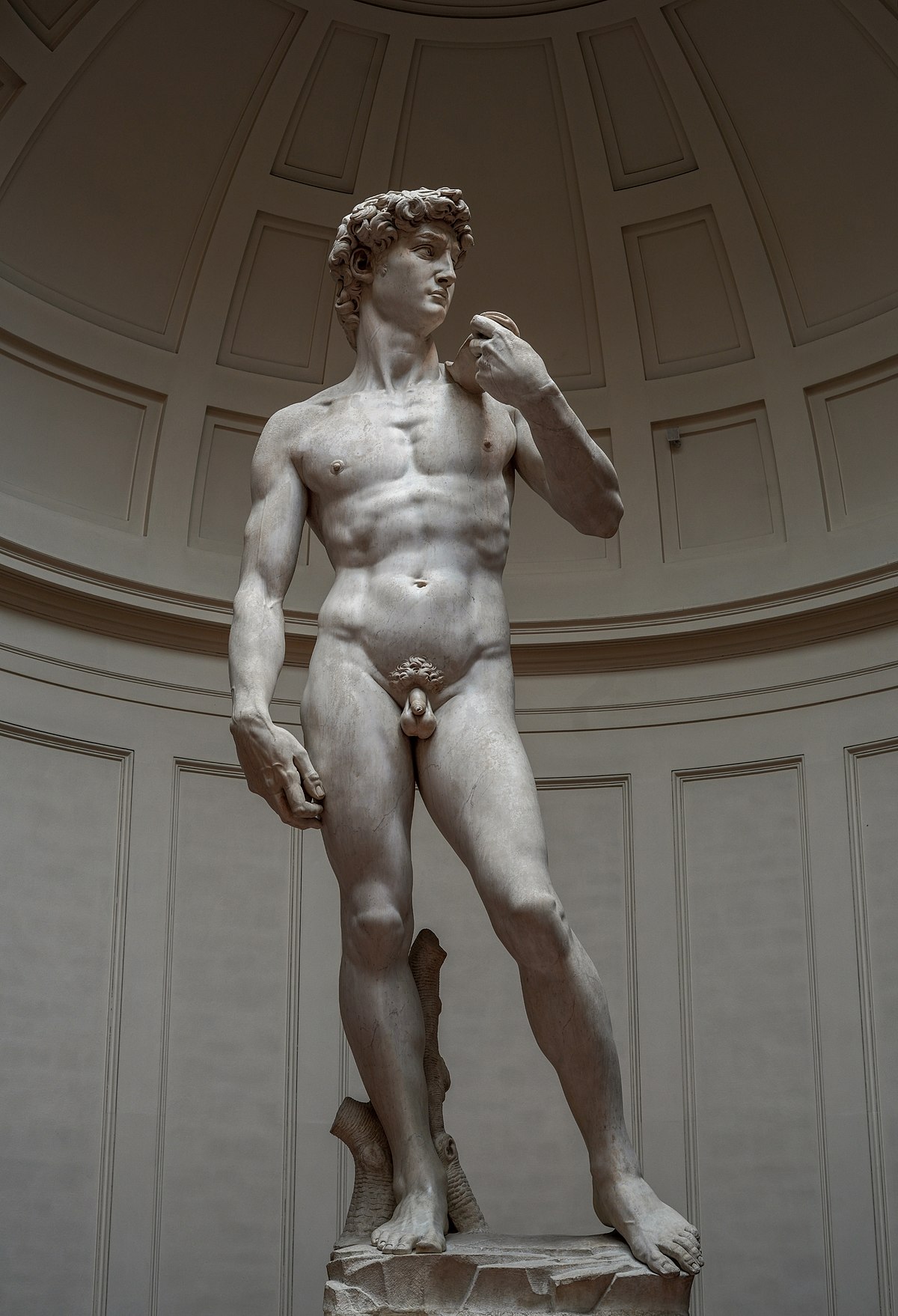
- marble carved by hand
- shows before the action of beheading Goliath had occurred
- David has his slingshot over his shoulder, rock half-hidden in his right hand
- creating anticipation, something Michelangelo does often in his artwork
- David looking out towards the “future”, creates an emotional level of pathos
- looks much older than other renditions of David
- contrapposto pose (Doryphoros)
- biblical figure shown as a pagan sculpture
- paid for by the city of Florence
- civic sculpture
- for the cathedral, the center of power in the city, however it gets placed instead
- nude sculpture, idea of purity, having nothing to hide, not intended to be sexual or erotic
Gattamellata, Donatello 1443. Padova
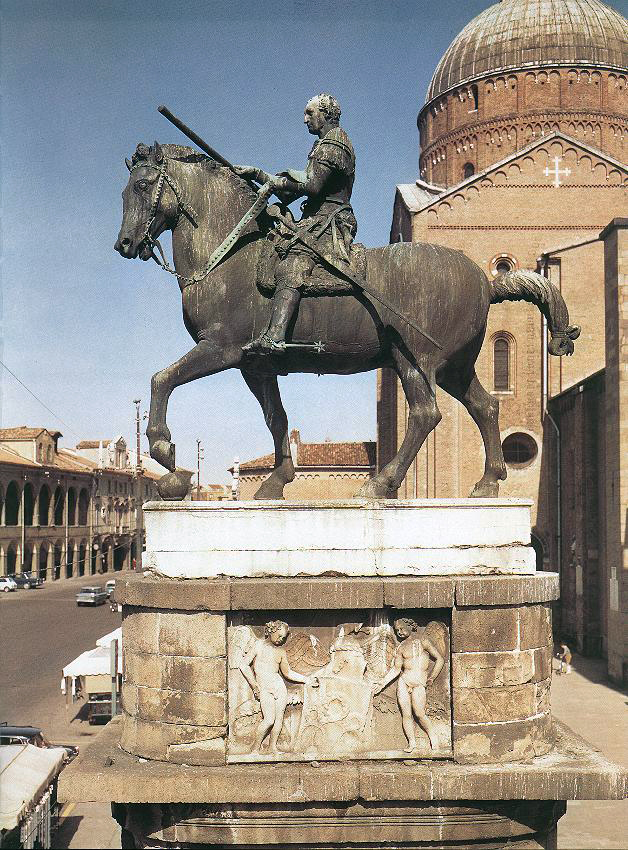
- the first bronze equestrian since classical antiquity
- military leader (Gattamellata) on a horse
- looks leisure, unassuming, simple, classical
Colleoni, Andrea del Verrochio. 1475, Venice
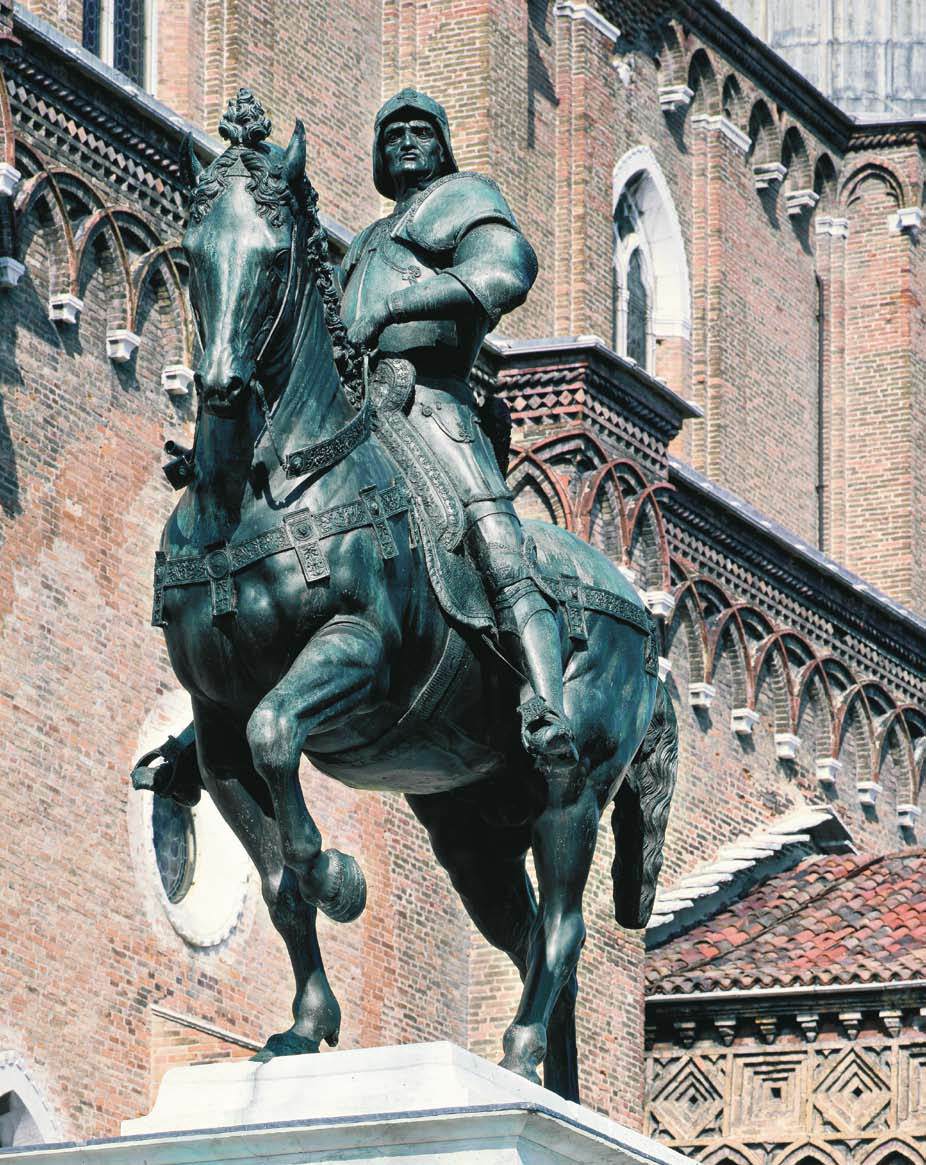
- makes sculptures that are similar, but just different enough that it doesn’t look like it’s trying to be a Greek or Roman sculpture
- intimidating, more dynamic than Donatello’s Gattamellata
Brunelleschi - Architecture
Filippo Brunelleschi (1377 - 1446), Florentine.
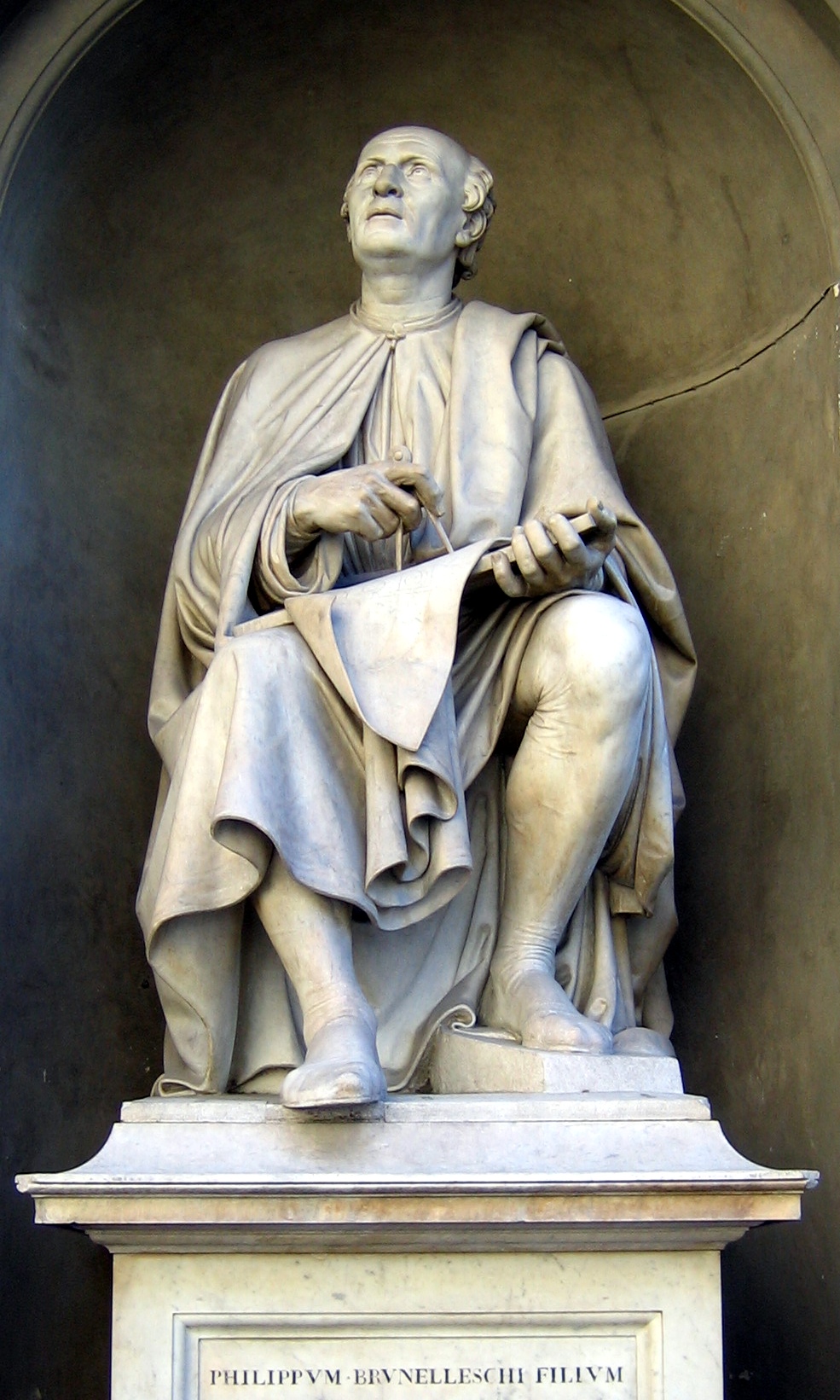
Spedale Degli Innocenti, Florence, 1419
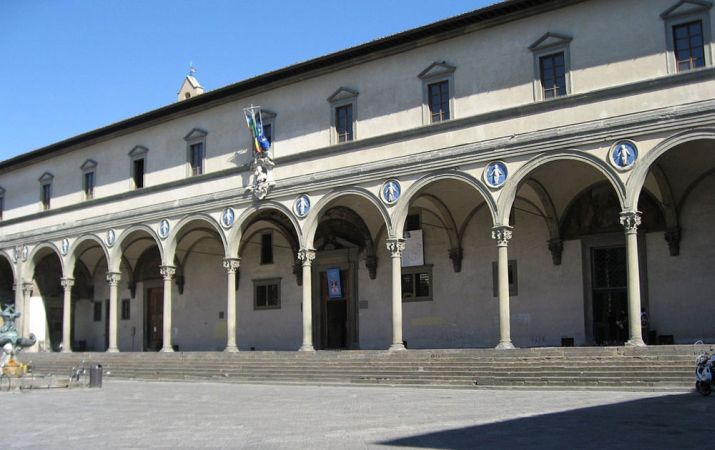
- first renaissance building ever
- foundling hospital
- parents would leave their children here for others to care for them
- order, symmetry, simplicity
Quattrocento
- 15th Century Florence, The “400s”
- Florence: ==Disegno== - drawing
- line and drawing is very important to Florentines
San Sebastiano, 1474. Sandro Botticelli
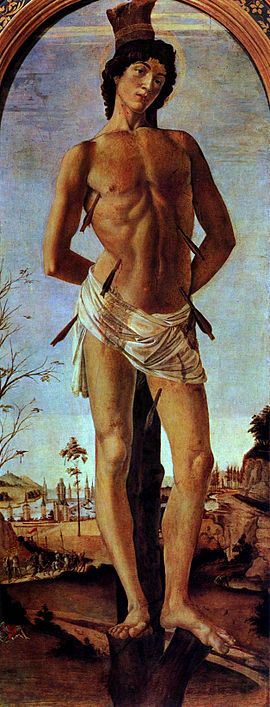
- from the fresco tradition, not a fresco painting
- plaster mixed with pigment
- dries fast, can cover a large area of canvas, dulls the color (not as vibrant as oil)
- Botticelli, looking at classical sculptures, drawing them and drawing from them (taking inspiration)
Adoration of the Magi, 1476. Botticelli
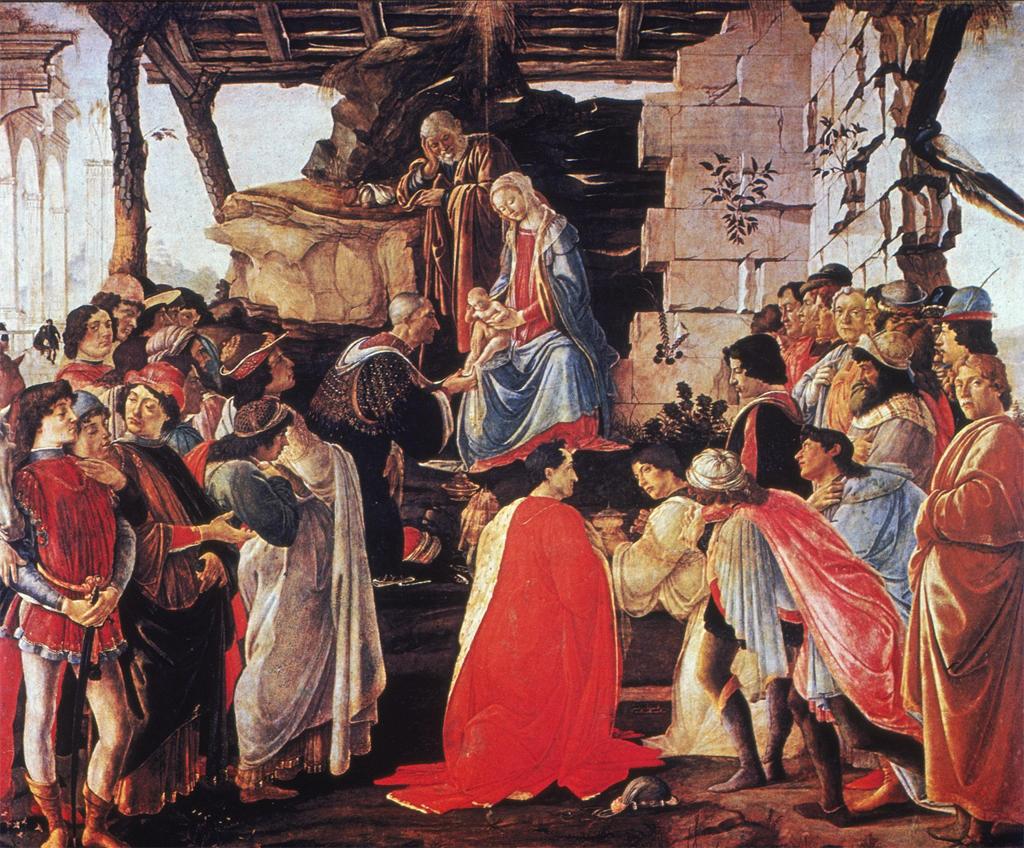
- Christian themes
- self-portrait, Botticelli directly looking at the audience
- putting himself into the same space as these people, wants to get the recognition as an artist, not a “craftsman” that does paintings
- taking important figures and depicting them in a biblical scene
- patrons
Primavera, 1470’s. Botticelli
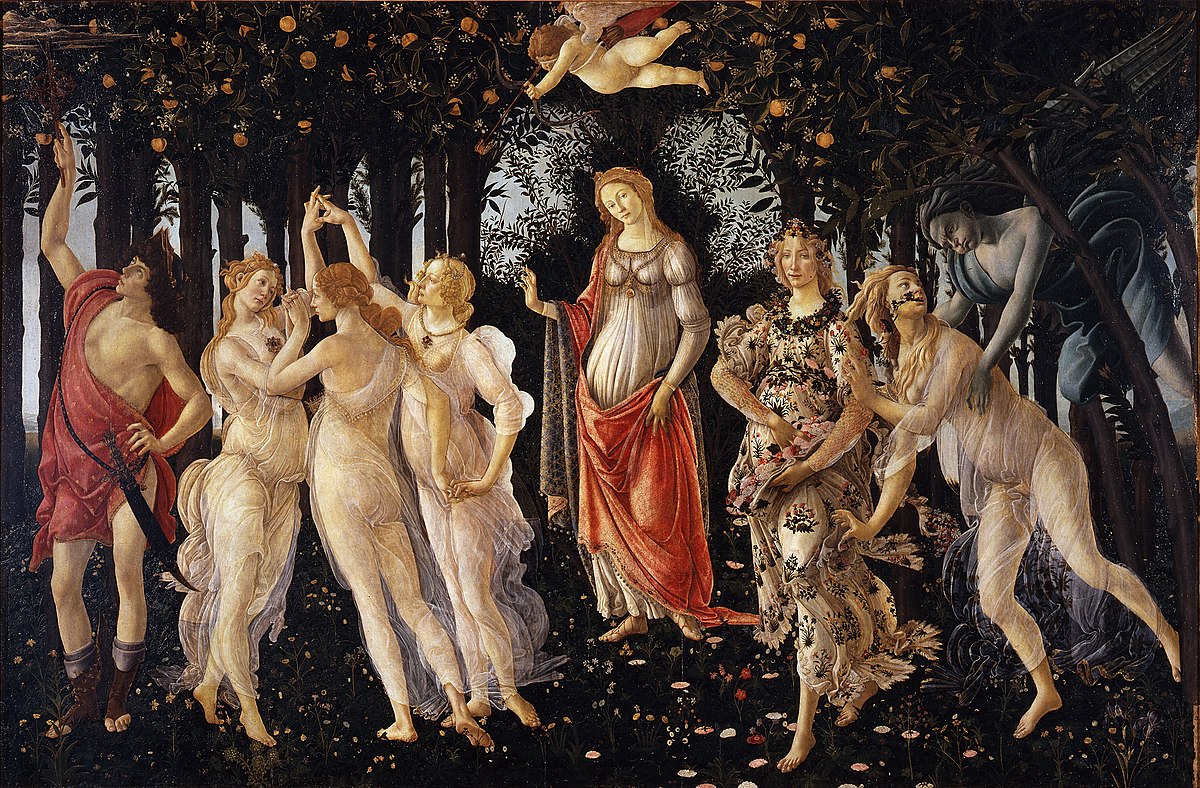
- entirely devoid of Christian symbolism
- completely pagan, pagan Gods; Aphrodite, Zephyr and Chloris, Hermes, Eros (Cupid), Flora, The Three Graces, Venus
- Christianity is incredibly important in Italy, yet there is this thoroughly pagan painting
- painted for the Medici family, orange was a symbol of the Medici family
- takes place in a forest with trees bearing oranges
- private painting
- connected to literature
- inspired by a poem written by a Florentine
- Primavera - allegory of the spring, connected to an idea of fertility (Venus)
The Birth of Venus, 1480’s. Botticelli
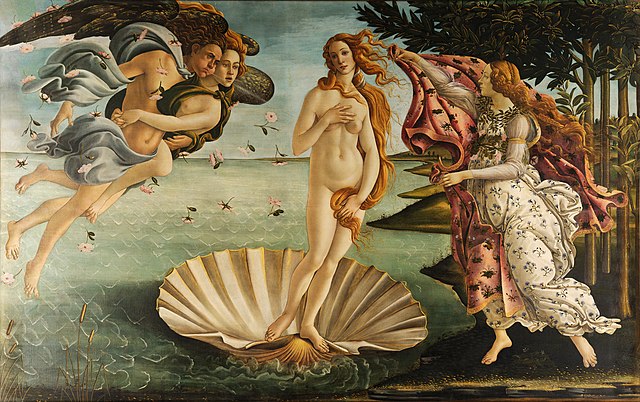
- also pagan; Flora, Venus standing on the seashell, Zephyr and Chloris blowing her to shore
- naked, she’s aware that she has no clothes, attempting to cover herself
- drawing
- painting was clearly drawn first, there’s line in the chin, the eyes, line that is then filled in
- doesn’t describe water in a natural way
- separates artists like Botticelli from Michelangelo who was more focused on life
Venus and Mars, 1480’s. Botticelli
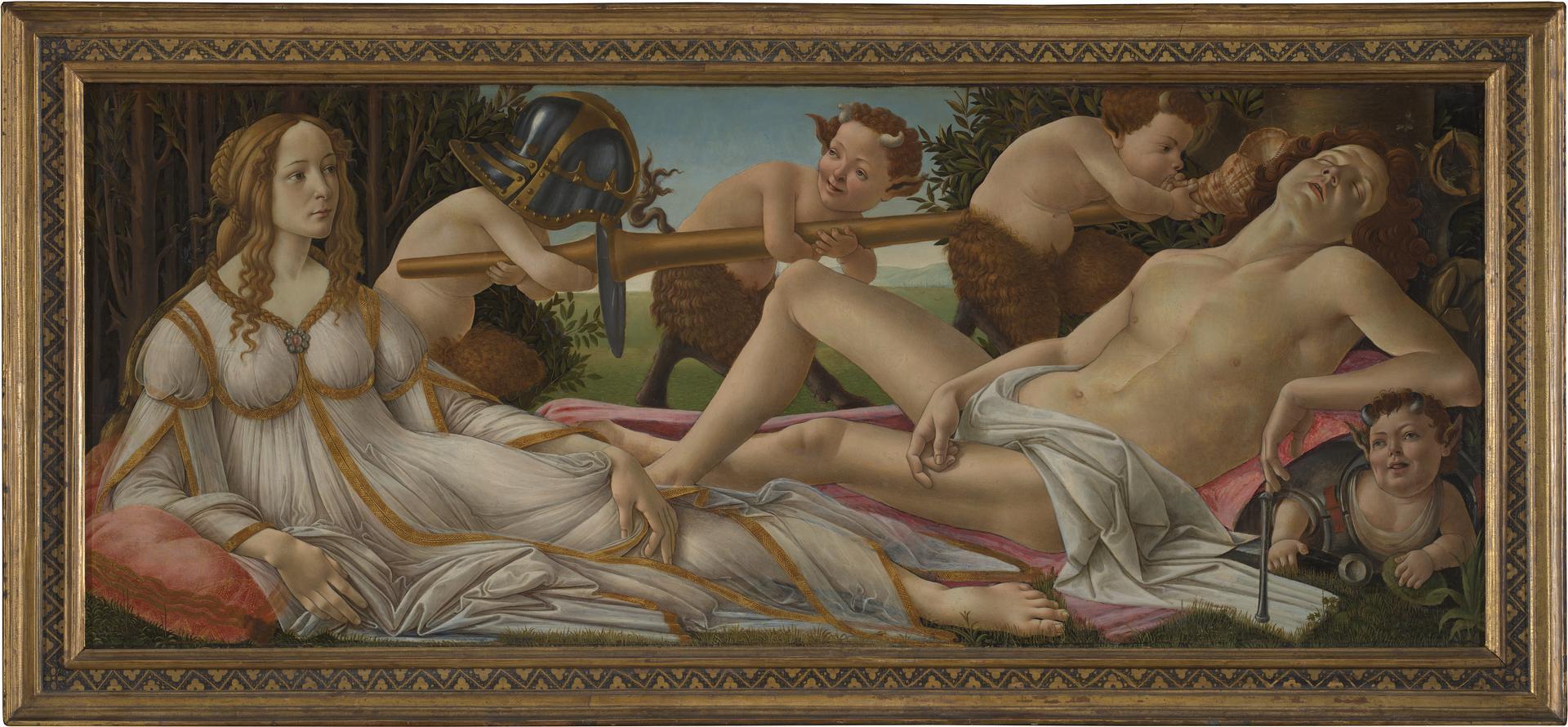
- love pacifies war
- satyrs, trying to wake up Mars (war)
- Mars is painted differently
- there is no line in his chin, rather it’s separated by tone
Annunciation, 1473. Leonardo
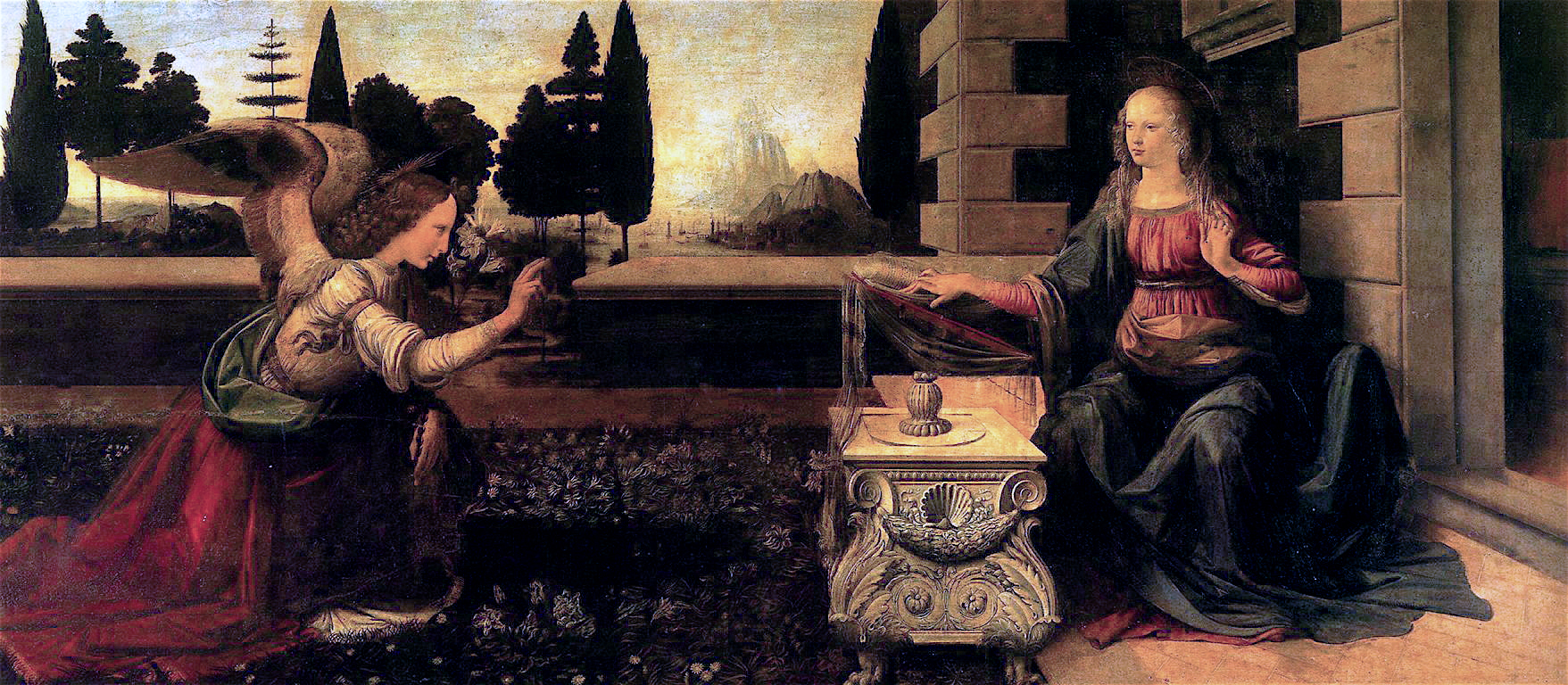
- painted more realistically
- more care for shadows and light, where the light touches and how that affects the area around it
- more care for how the fabric drapes
- atmospheric perspective, foreground clearly distinct from the background
- use of color to describe dimension
- ==sfumato== - no harsh outlines, no hard lines, “smoky”
- Mary and Joseph
St. Jerome in his Study, 1480. Ghirlandaio
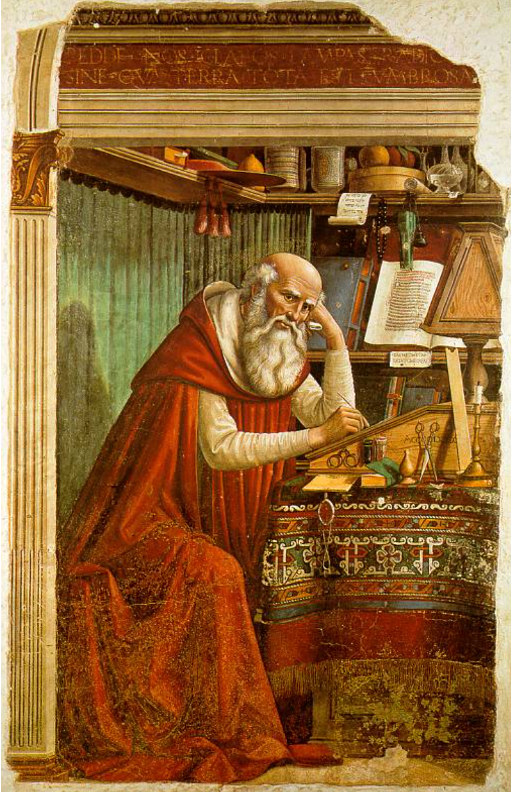
- fresco
- depicts a doctor of the Church (theologist, writer)
- more about his surroundings, everything around him is in serious detail, his setting speaks for him (tells the viewer who he is)
St. Augustine in his Study, 1480. Botticelli
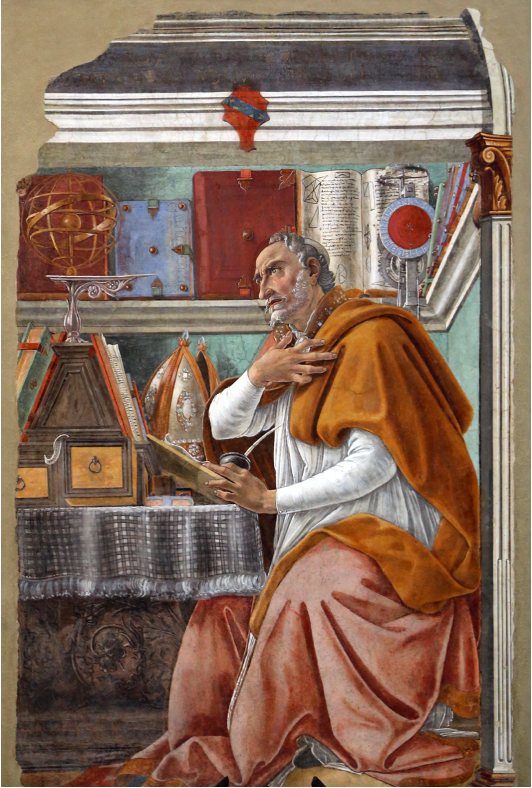
- fresco
- depicts a doctor of the Church (theologist, writer)
- more about St. Augustine, less details in his surroundings, more focus on his process as a writer
Portrait of an Old Man and his Grandson, 1490. Ghirlandaio (fresco)
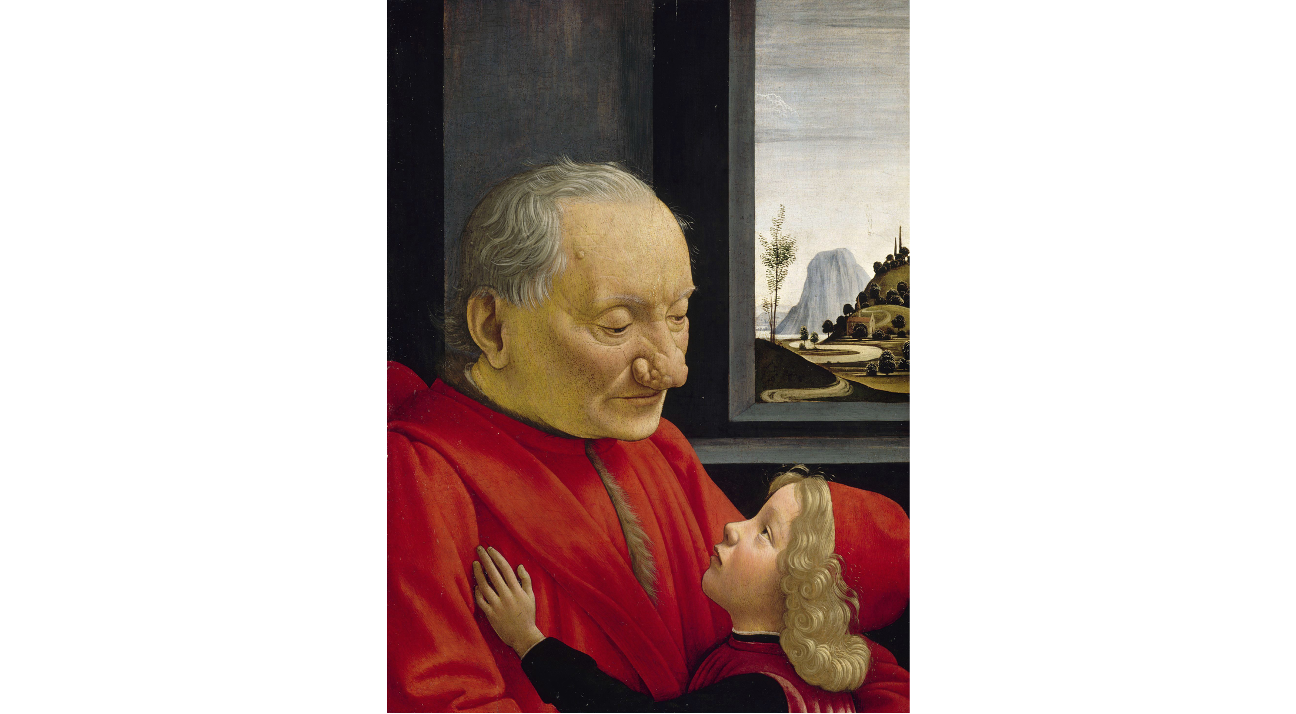
- ==genre scene== - paintings depicting regular people
- background, direct separation of the outside and the inside world (private separate from the public)
- shows importance of family, private and personal but universal
- most viewers can relate to having someone to look up to
- art has purpose other than war, projection of power, etc.
Portrait of Giovanna Tournabuoni , 1488. Ghirlandaio
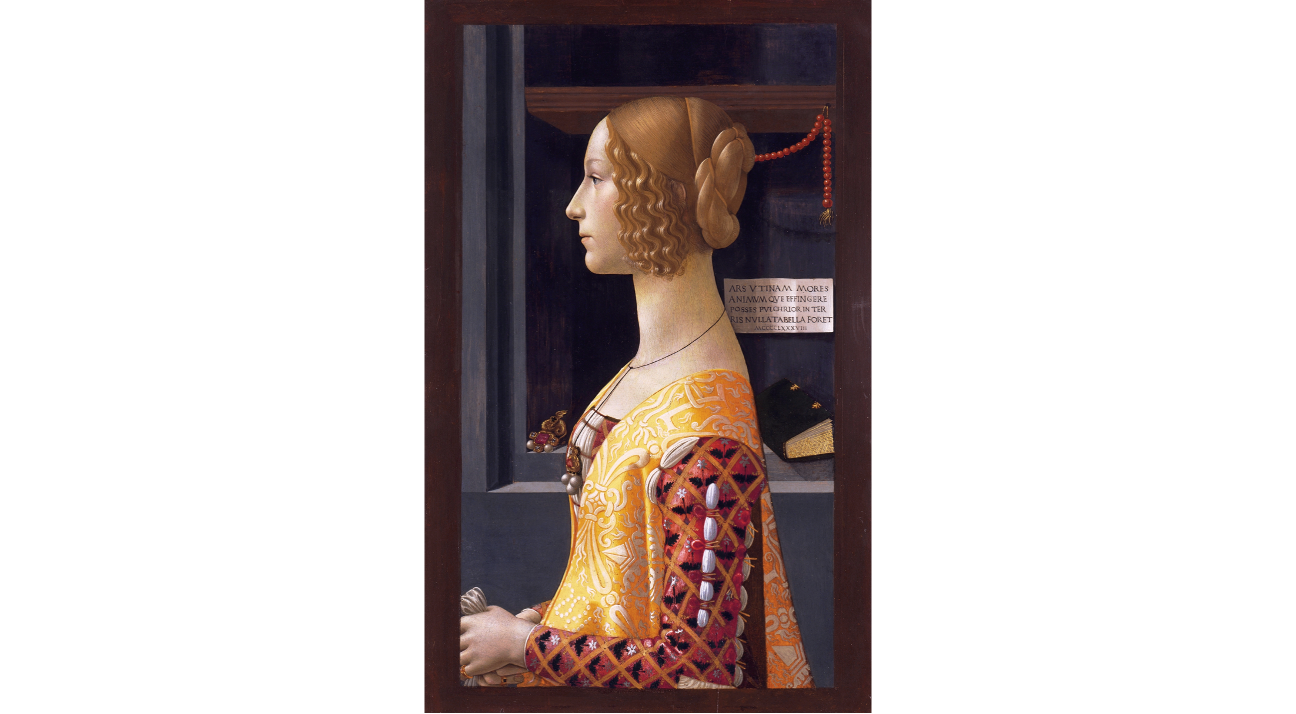
- done after her death
- well-known, aristocratic and wealthy woman
- hair and clothes purposely picked to show wealth, style
- L in her clothes meant to represent her husband, Lorenzo
- necklace was a real possession of hers
- poem in the background - “nothing is more beautiful than you, not even this portrait”
- genre scene
Ginevra de Benci, 1478. Leonardo
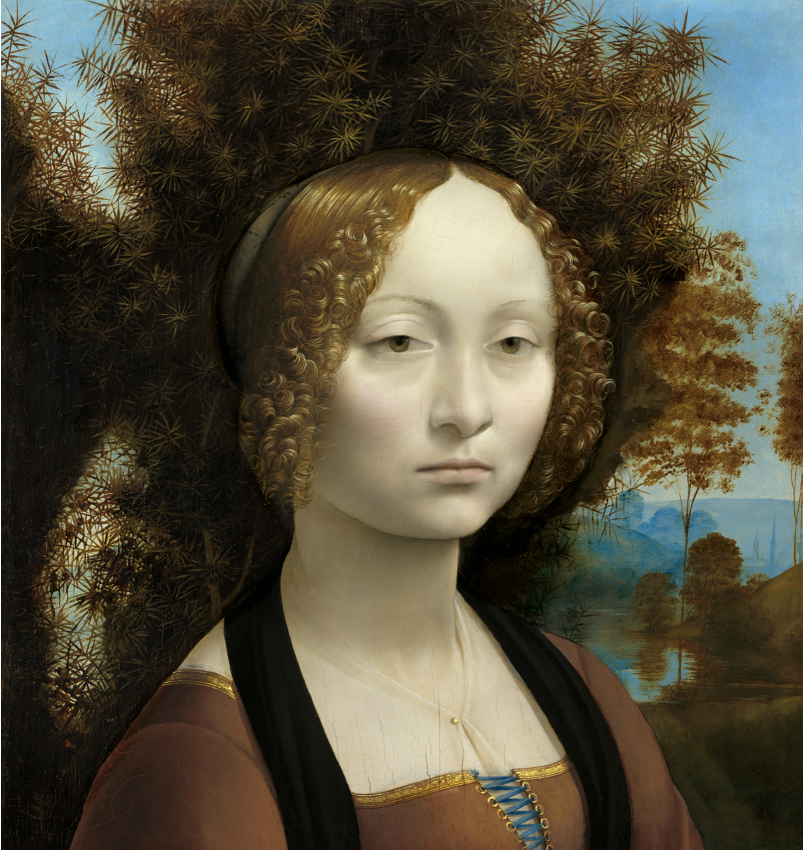
The Birth of Mary, Florence. 1485. Ghirlandaio
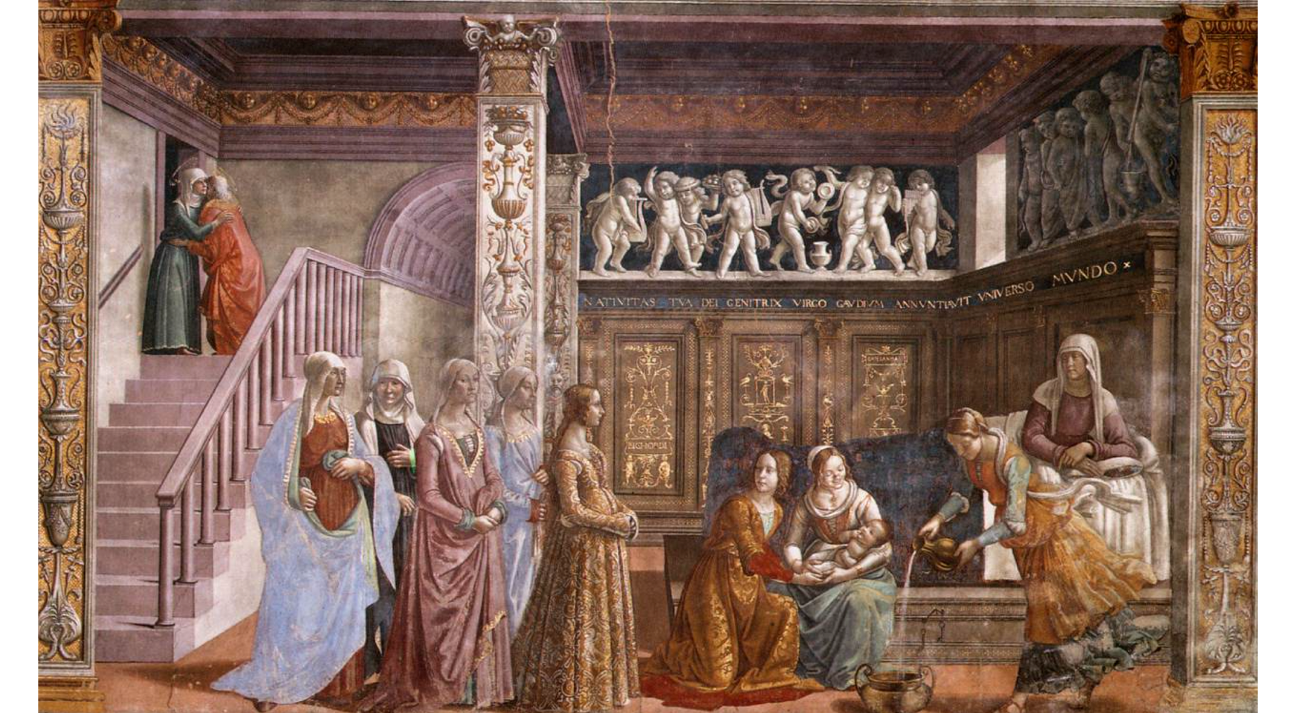
- more interest in beautiful interior spaces
- Florentine
- taking the idea of the birth of Mary and updating it
- placing biblical figures in contemporary interiors
- creates a connection between modern contemporary Florence and Florentines and biblical individuals
- sculptures in the frieze are not monotheistic, almost look like the ones on the sides of Greek temples
The Last Supper, 1486. S. Marco. Ghirlandaio
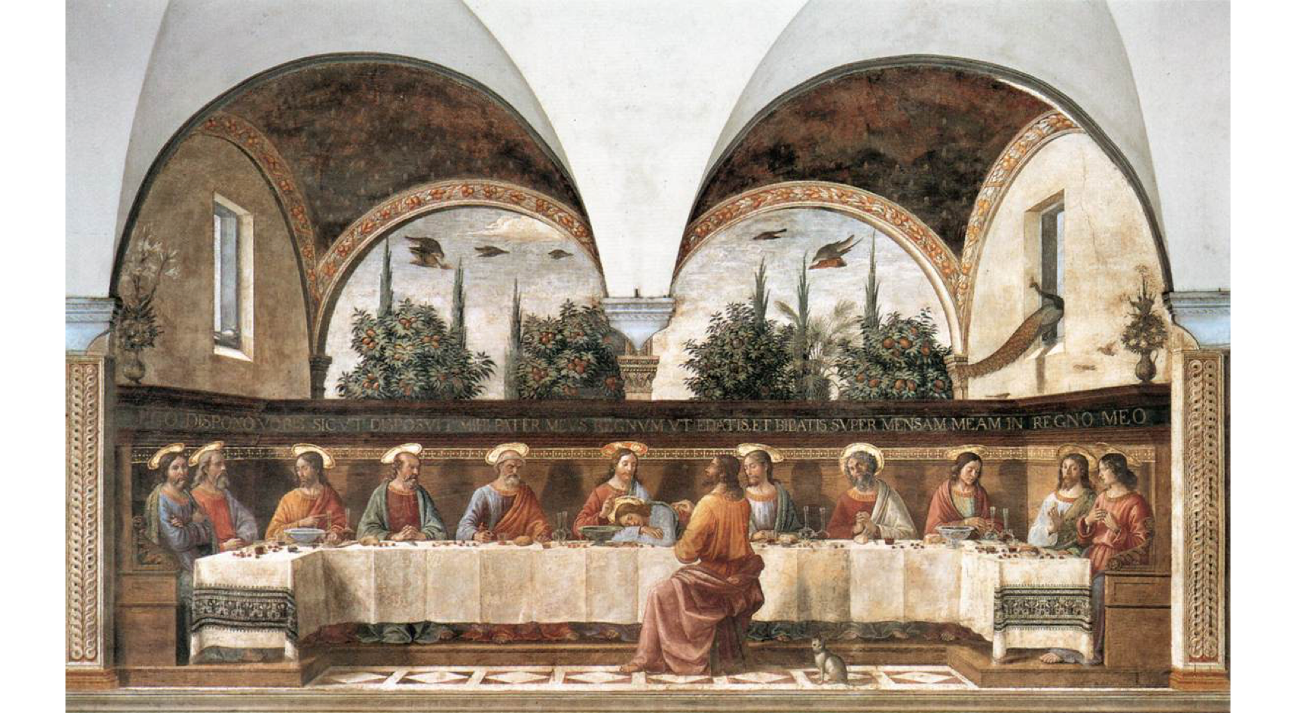
- taking biblical themes and updating it
- Judas in the center beside Jesus on the opposite side of the table
- has a cat beside him, seen as negative in this cultural context
- the only one without a halo above his head, seen as “unholy”
- peacock, symbol of rebirth
- orange tree, symbol of Medici family
- linear perspective, chiaroscuro (not so much atmospheric perspective)
- interest in attempting to create space to trick the eye into believing there’s something 3-Dimensional in the background
Il Cenacolo (The Last Supper), 1495. Leonardo
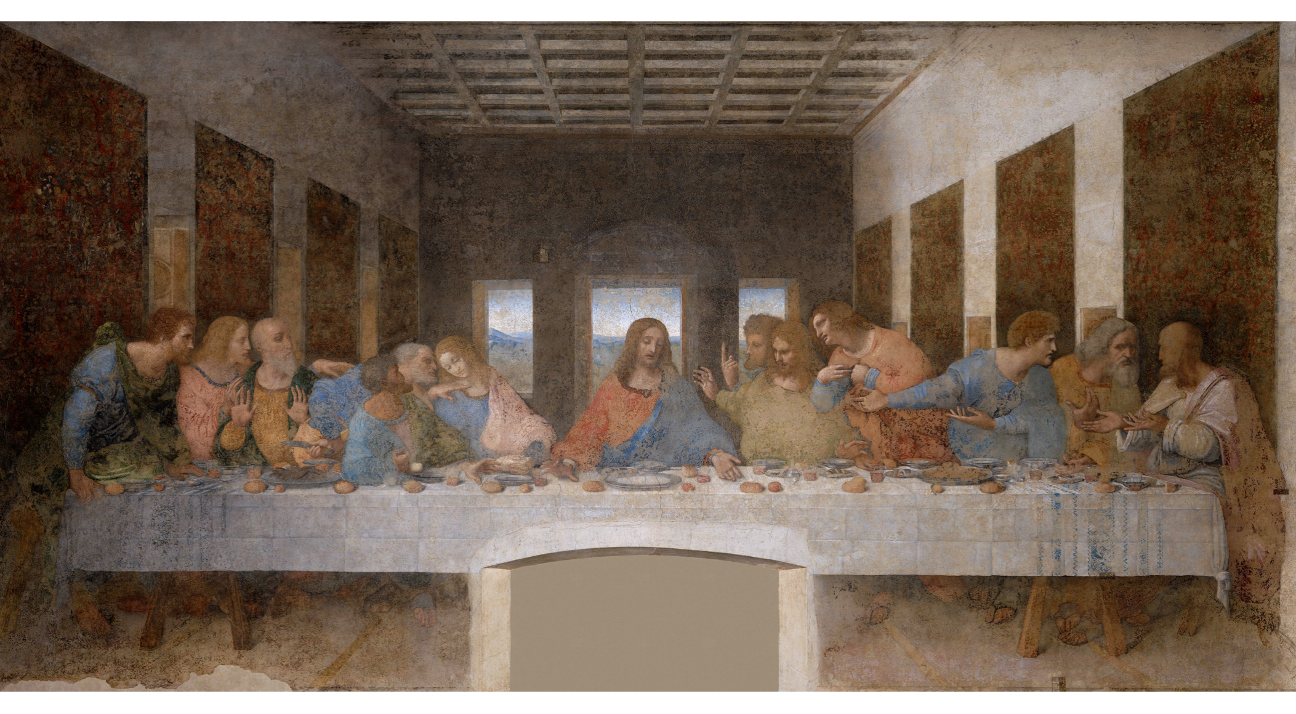
more realistic organization
- creation of tension through interaction
- creating atmosphere in space
no obvious signs of who is meant to represent Judas in the painting
- unliked Ghirlandaio, Judas is not on the other side of the table, no one has a halo, there’s no cat as imagery, etc.
symmetrical (Florentine in that sense)
- Christ is directly in the middle
simple interior, coffered ceiling, symmetrical color blocks on the walls
three windows (three is important in Christianity, Holy Trinity)
Ghirlandaio teaches Leonardo fresco, though he didn’t see the importance in it and instead did oil (believed it was the only medium that made sense)
- tried to make a new medium of oil and fresco, and that’s how he painted his
- as a result, the painting deteriorates, hard to see the bag of money in Judas’ hand
Christ and Judas are reaching their hands out towards the same thing
- meant to create tension
renaissance painting is very elitist
- if someone doesn’t understand or didn’t have intimate knowledge on history or language, they wouldn’t understand the paintings
Madonna of the Rocks, 1491-1508. Leonardo
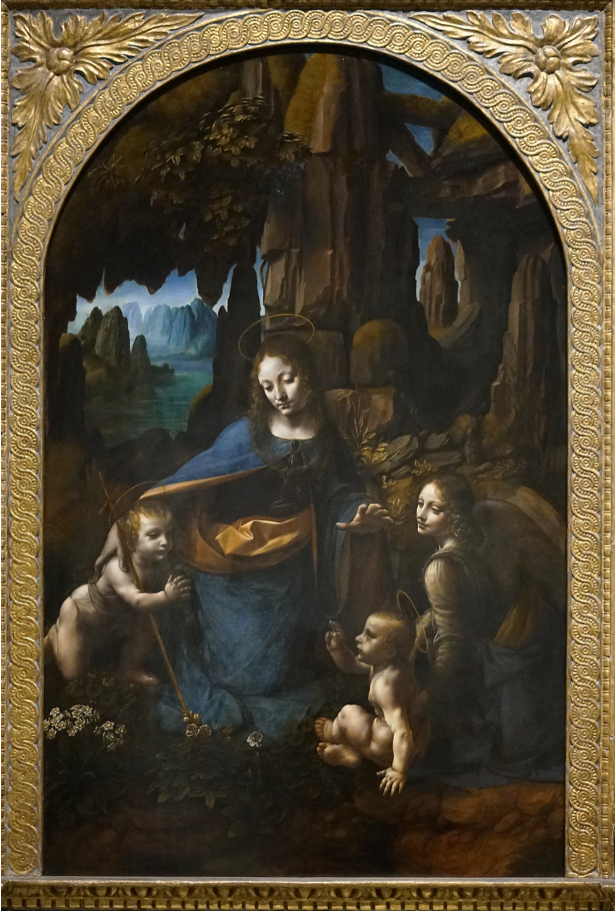
- triangular composition
- Mary, angel, Christ, St. John the Baptist
- Christ blessing St. John the Baptist
- using sfumato to make volume in the figures
- uses real life to create his paintings (using science and observation to dissect reality and recreate it on a canvas)
- oil on canvas
Madonna and Child, 1465. Fra Filippo Lippi
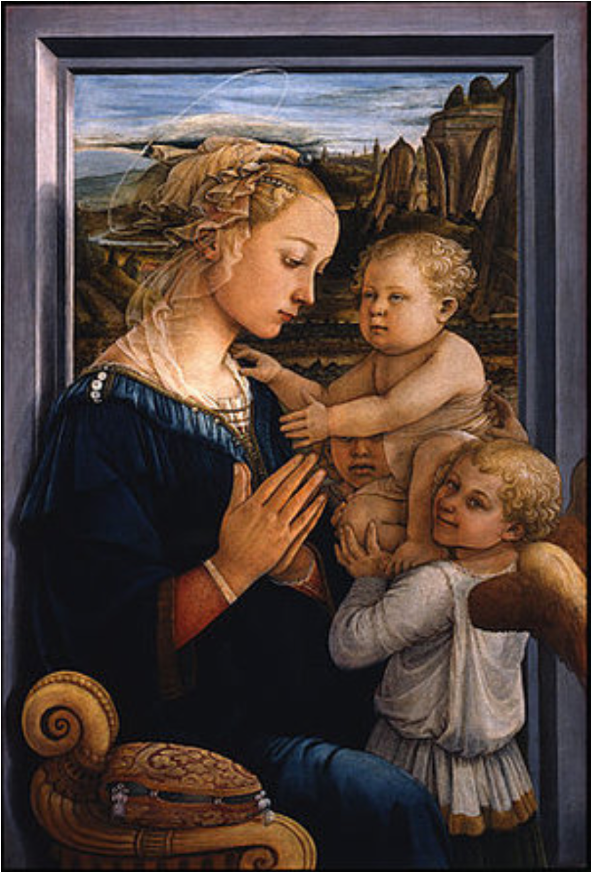
- Botticelli’s teacher
- hard lines (unlike Leonardo)
La Gioconda (Mona Lisa), 1503. Leonardo
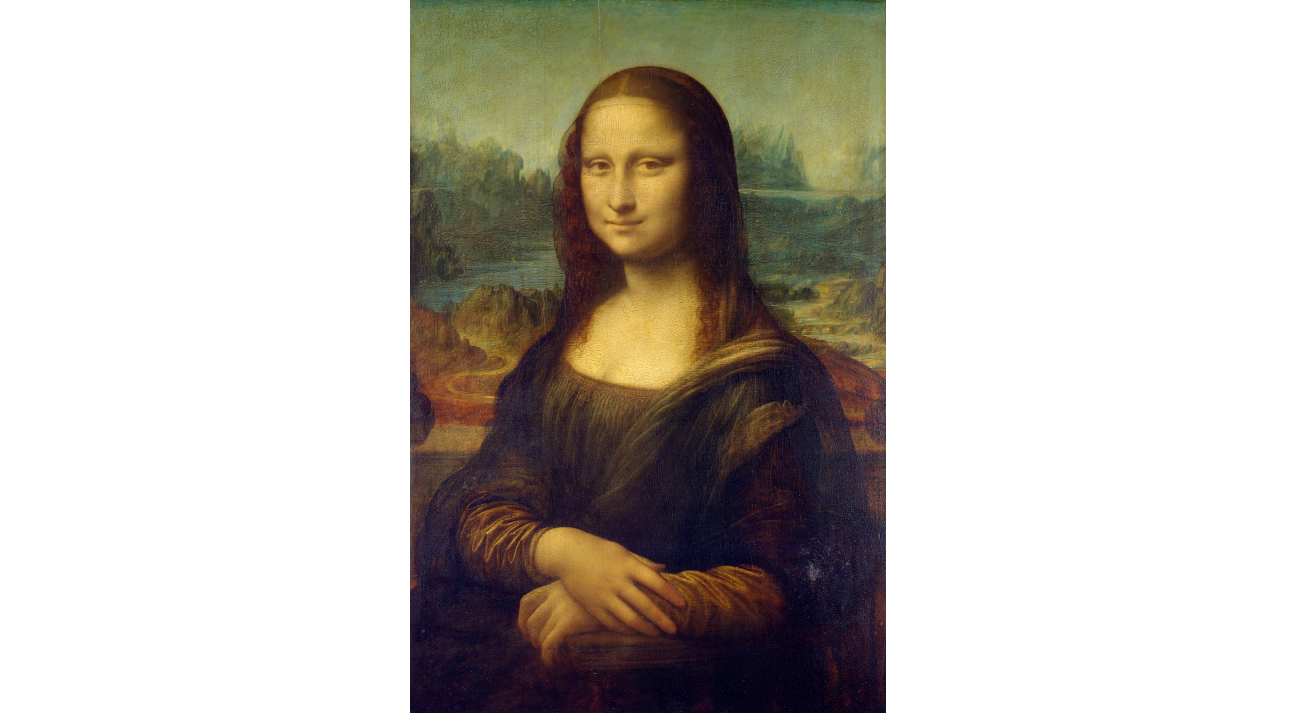
- banker Gioconda’s wife seated on a chair in front of a landscape
- took the payment but never gave the banker the painting
- carried it with him from Florence to Milan to France until his death in France
- might’ve had some kind of emotional connection to the person or painting
- finished it but kept adding to it and changing it
- interpretation: this is Gaia (Mother Earth)
St. Sebastian, 1456. Andrea Mantegna
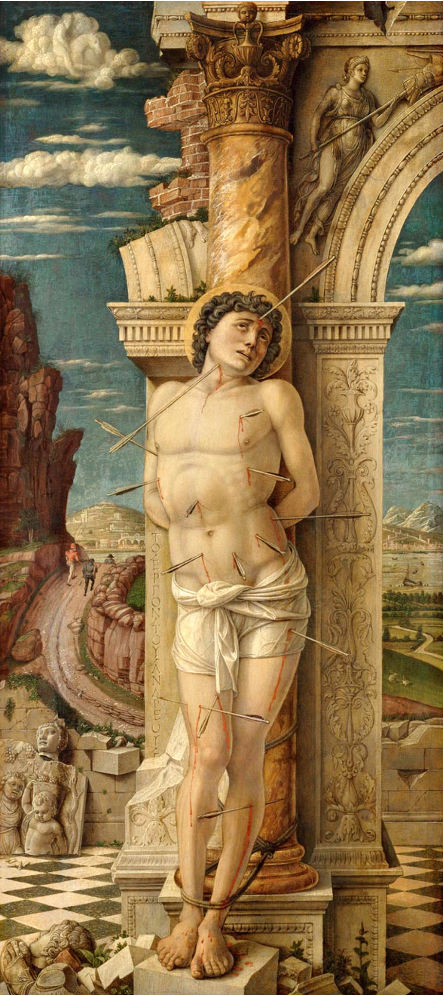
- court-painter, works directly for the crown
- less freedom, underlining propaganda
- St. Sebastian tied to Roman architecture with arrows protruding from his body
- very violent, not attempting to create a lovely painting of a Saint
- influence of pagan antiquity
- obviously a Christian painting but with an interest in classical architecture
- serious attention to detail in the background and the architecture
St. James led to his Execution, 1451. Andrea Mantegna
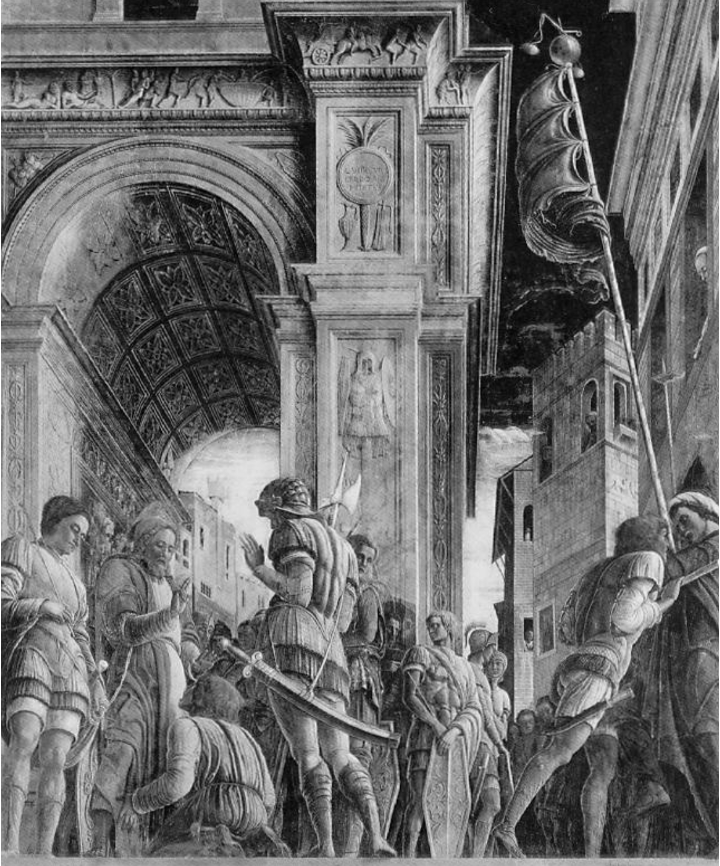
- destroyed during the second WW
- worm’s eye view
- ==di sotto in su== - from below looking up
- painting placed above a pre-existing painting, attempting to make it look like the viewer is looking up at something happening
- main theme for Mantegna is perspective
Saint Sebastian, 1480. Andrea Mantegna
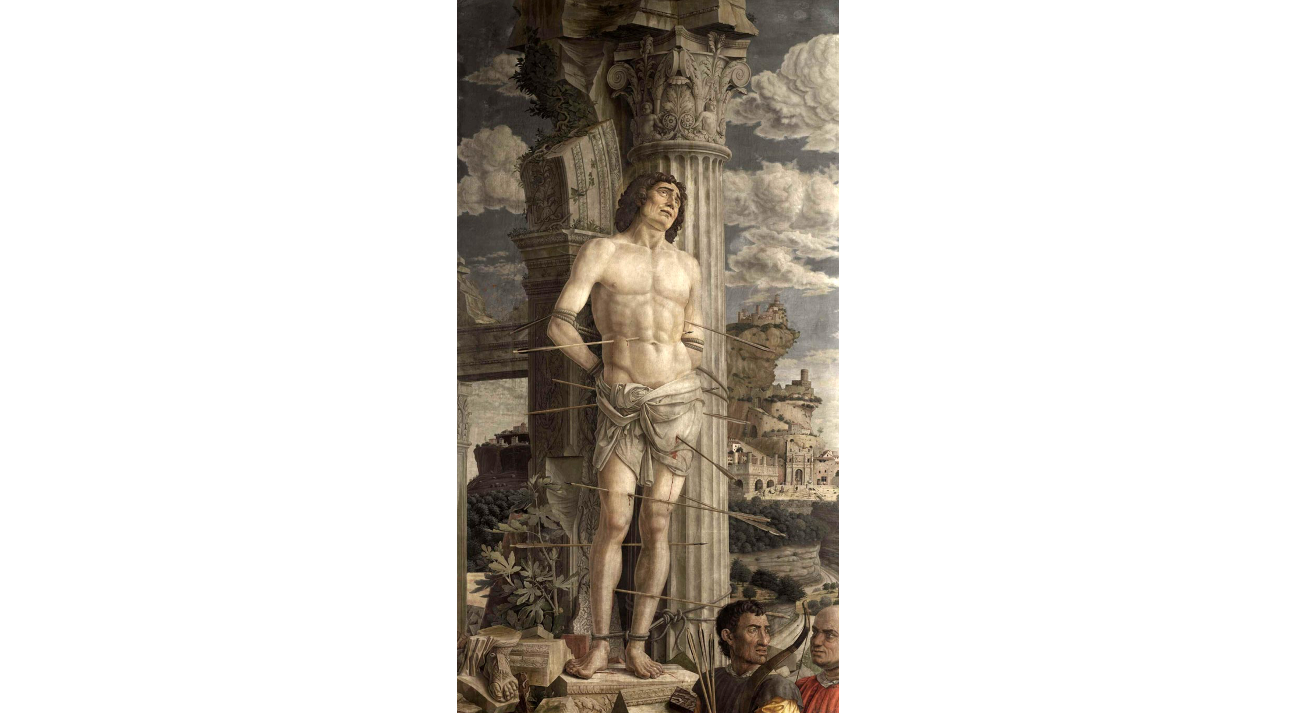
- moving towards high renaissance style influenced by Florentines yet finding his own way
- adding violence, adding influence of classical antiquity and architecture
- two Romans at the bottom unbothered by Saint Sebastian
- underlines the violence of the Romans, careless behavior towards torture and loss of life
The Lamentation Over the Dead Christ, 1501. Andrea Mantegna
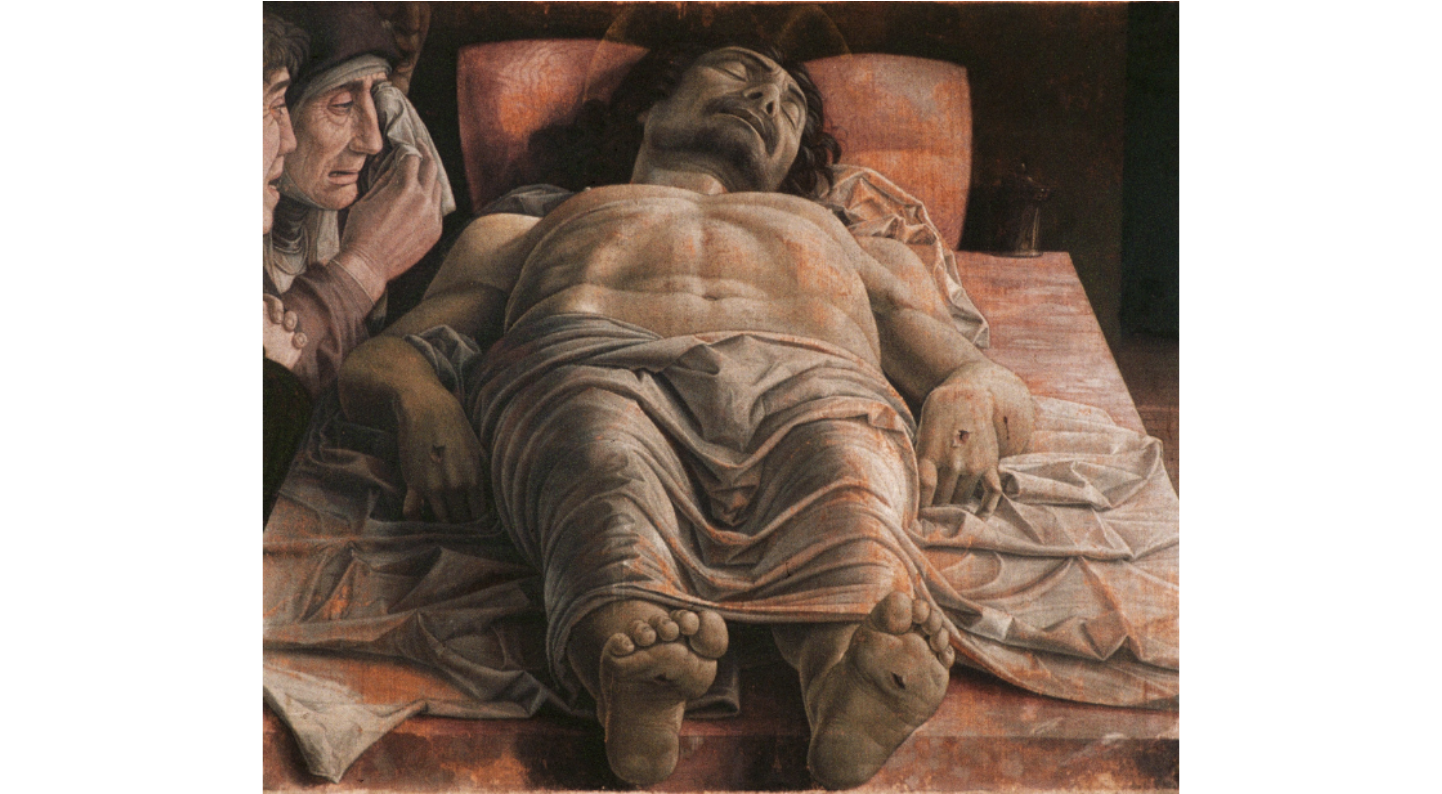
- not an idealized version of Biblical events
- can see the holes where Christ was placed on the cross with nails placed in his hands and feet
- can see inside the wound and the way the skin folds over the wounds
- sheets are soaked and stained with blood
- color palette is very muted and monochromatic
- viewer’s perspective placed at the foot of the bed
- forces the viewer to deal with the art directly, no separation from the events
- Mantegna uses perspective to force viewers to have an intense discussion with the art
- Mary portrayed as an incredibly old, wrinkled woman
Camera Degli Sposi, 1465-1475. Andrea Mantegna
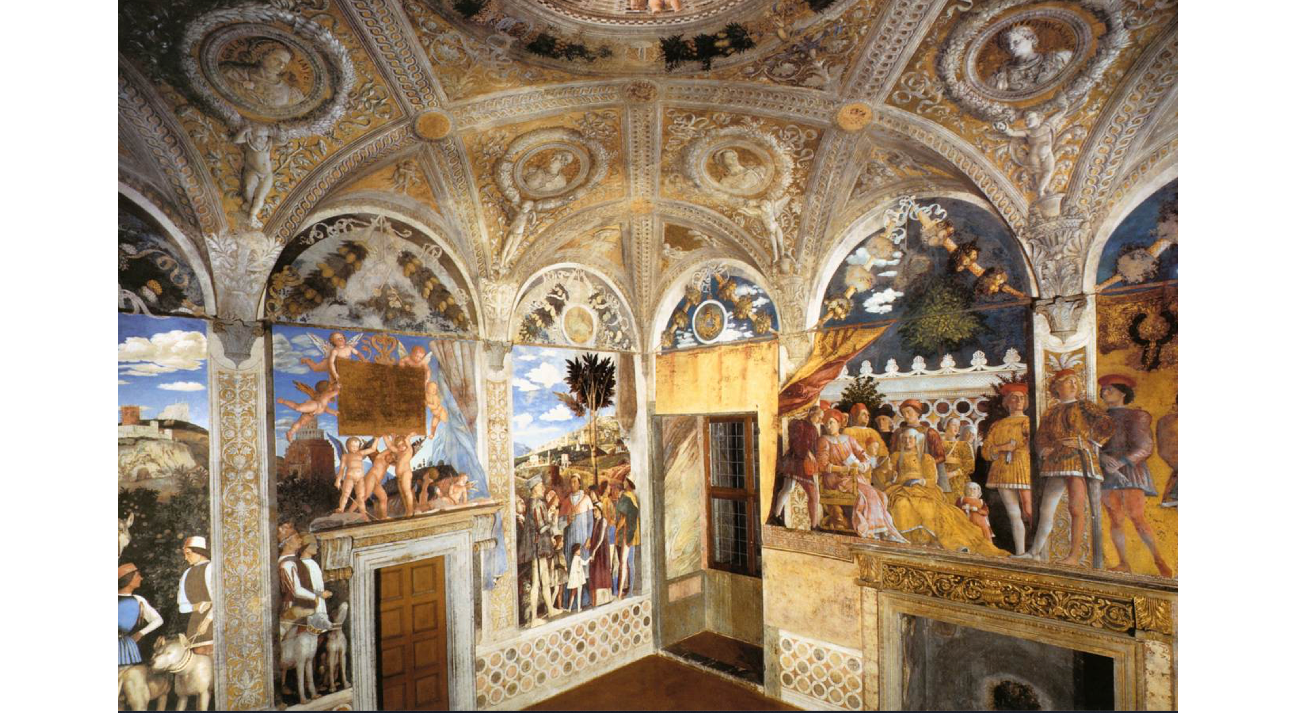
painting on the interior of a villa, room of the newlyweds
everything painted by Mantegna except windows, doors, and the the little arcs
==tromp l’oeil== - to trick the eye
- like an optical illusion
- meant to look immersive inside architecture, to look like there is space when there obviously isn’t
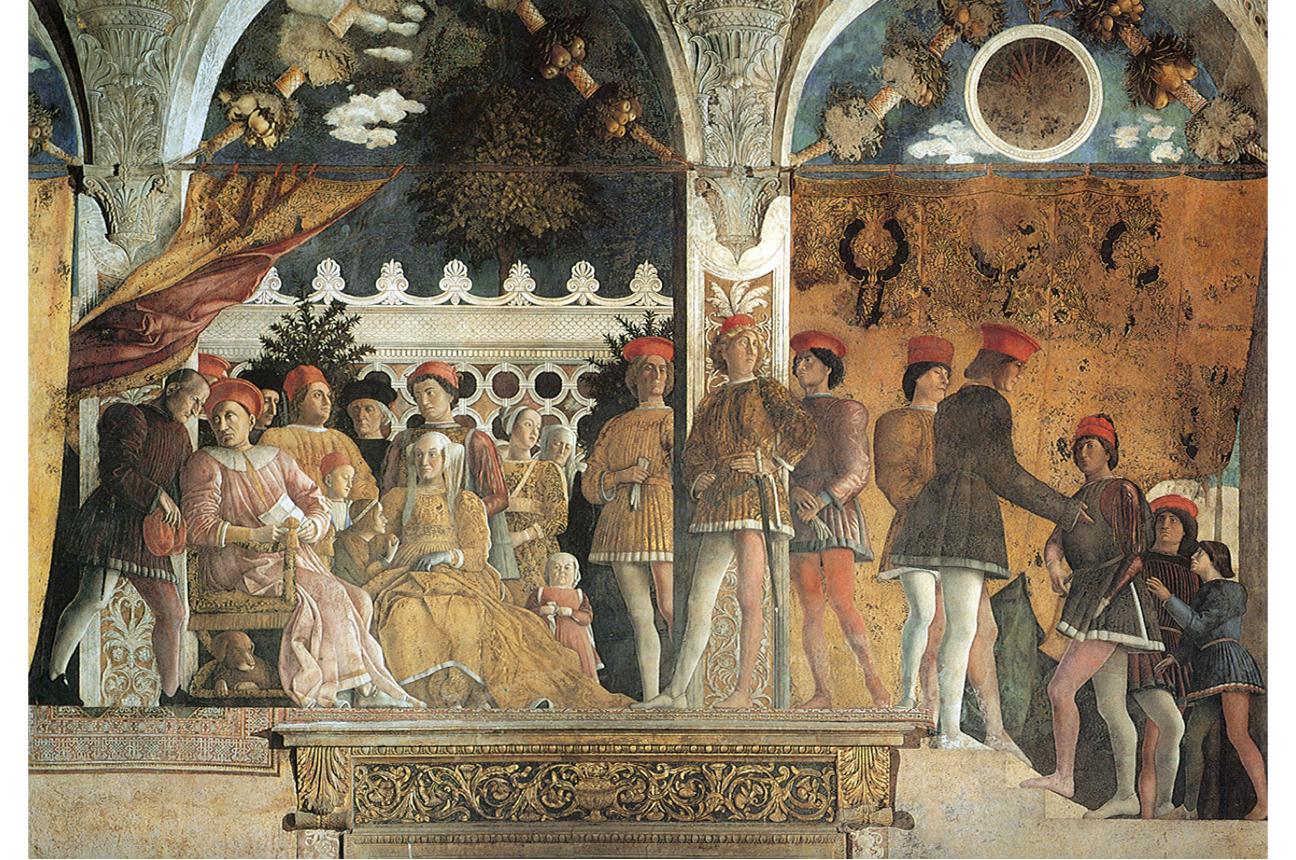
painting for a court, not for private patrons
- direct painting of everyday life of the Gonzaga Court
- the patriarch (head of the house), his counselor, a dog (symbol of loyalty), patriarch’s wife sitting beside him
- a different family on the right stepping up to the patriarch
- propaganda, he sits in wait, and people have to come and walk up to his level
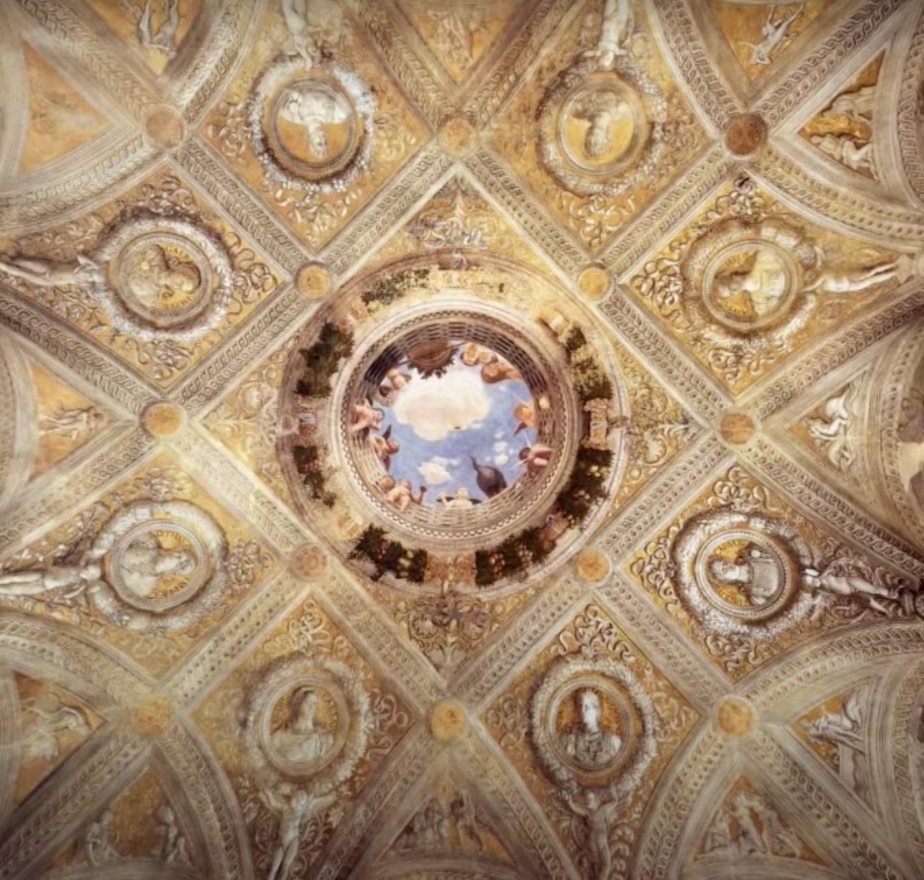
==oculus== - the hole at the top of a pantheon
the first 3 emperors of the Roman Empire
- propaganda
- Florence sees themselves and their heritage as a continuation of Rome (Roman republic)
creates an idea of legitimacy
- display of Roman monarchs shows that they are a continuation of them, have the same God-given power in their city-state
- satisfies their political beliefs
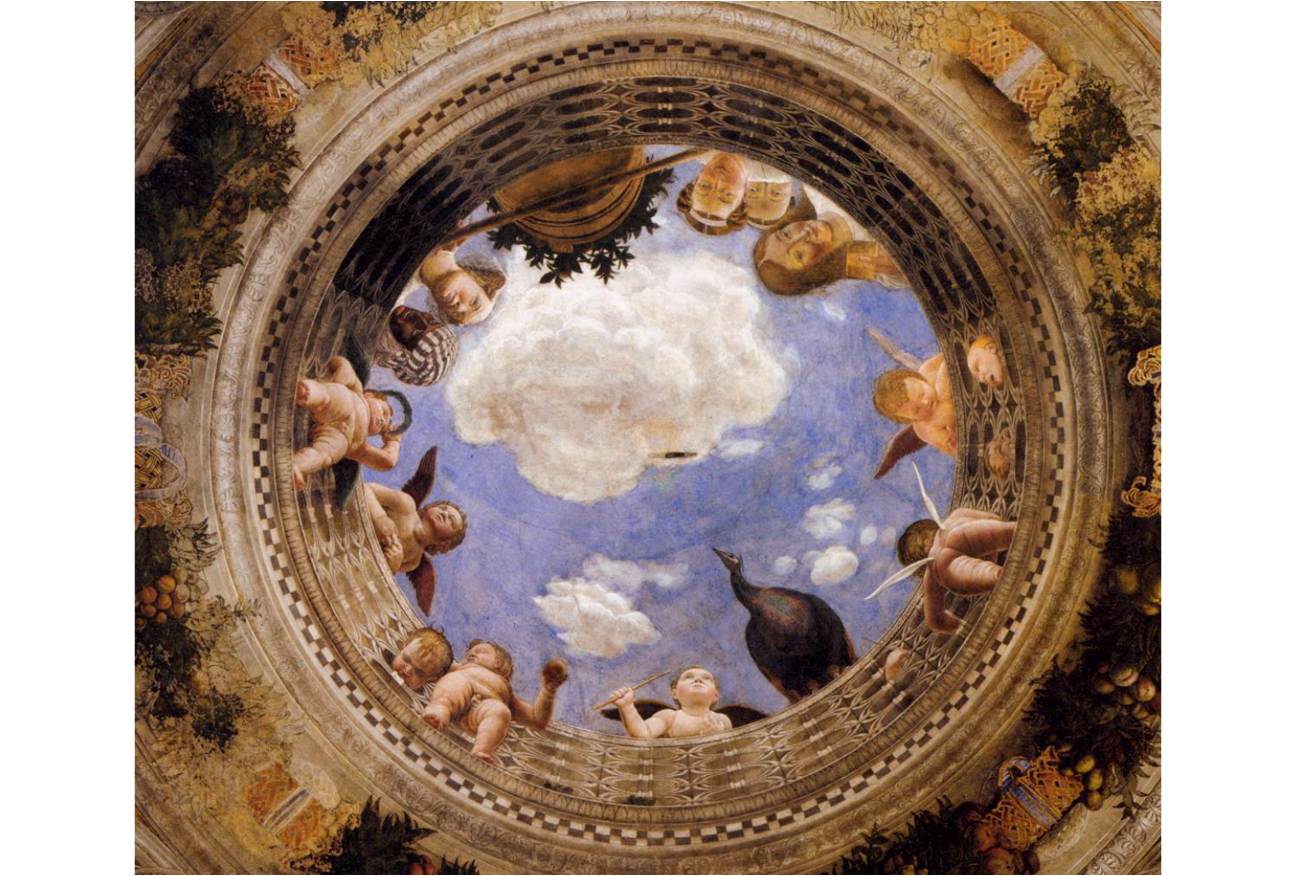
di sotto in su, trompe l’oeil
- made to look like theres an oculus on the ceiling when there isn’t
religious and playful themes
- many different figures, both religious and court ladies, little angel with its head stuck in the holes of the rail, peacock as a sign of rebirth, a plant resting on a rod that if moved would topple over, etc.
Venice and the Cinquecento
==Disegno di Colore== - line v. color
- Venice being independent from Italy, a different world
- was interested in recreating Byzantine architecture and Islamic architecture
- Venice more interested in color, Florence more interested in line
Oil painting, glazing
- 16th century, oil painting is in full swing
- glazing - taking a color, diluting it with oil, painting something, waiting, and paint the same color on top to create a glaze, creates deeper and more profound rich colors
- oil cannot paint on walls
- only on canvas meaning it cannot be done on a huge scale unless a giant canvas is made
- the humid air of Venice does not allow fresco to survive
Self Portrait (?), 1430. Antonello da Messina
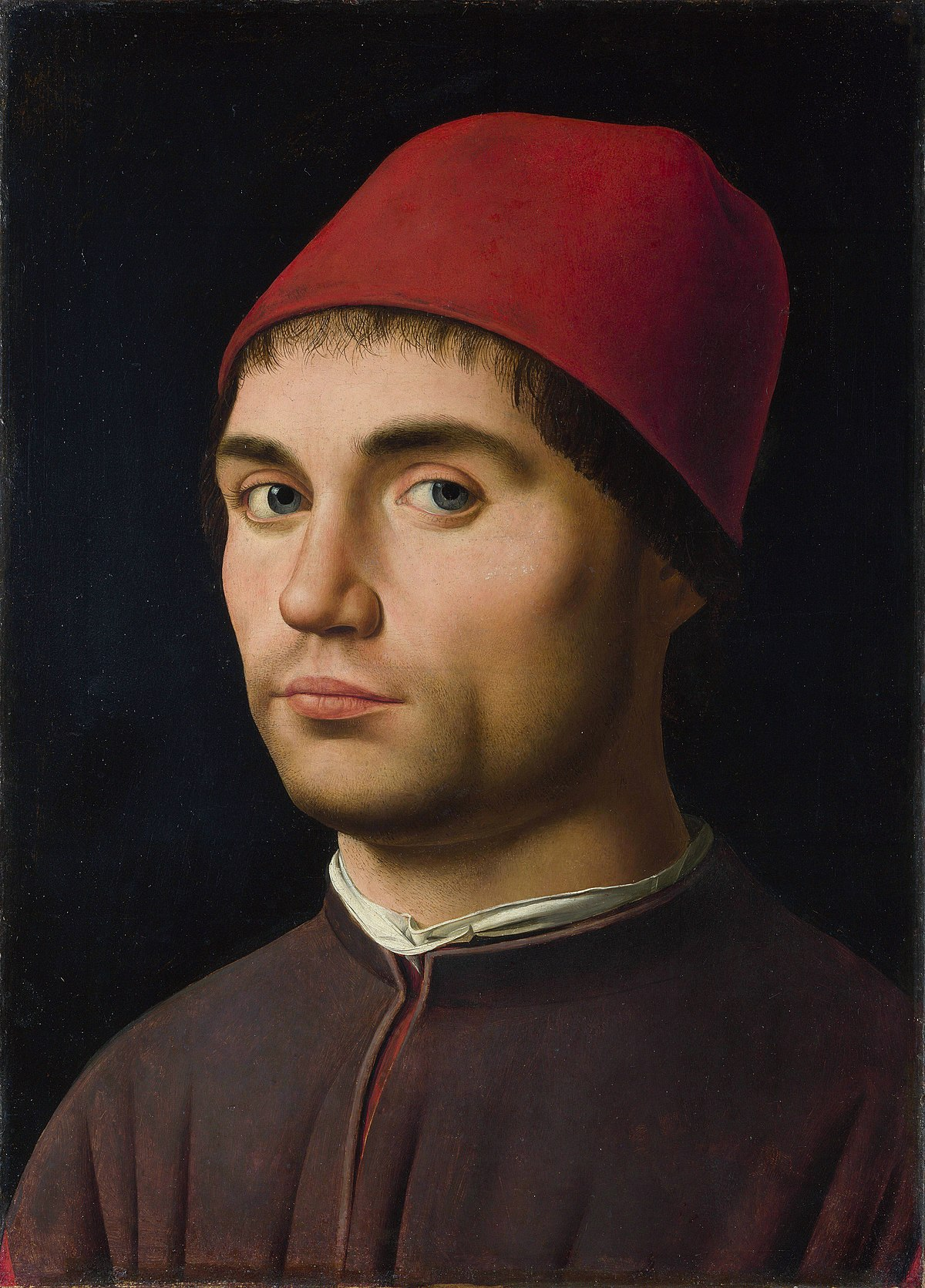
- oil painting
- large tonal range, more detail, deeper colors
Gentile Bellini and the Bellini Family
Portrait of Sultan Mehmed II (Mehmed the Conquerer), 1480. Gentile Bellini
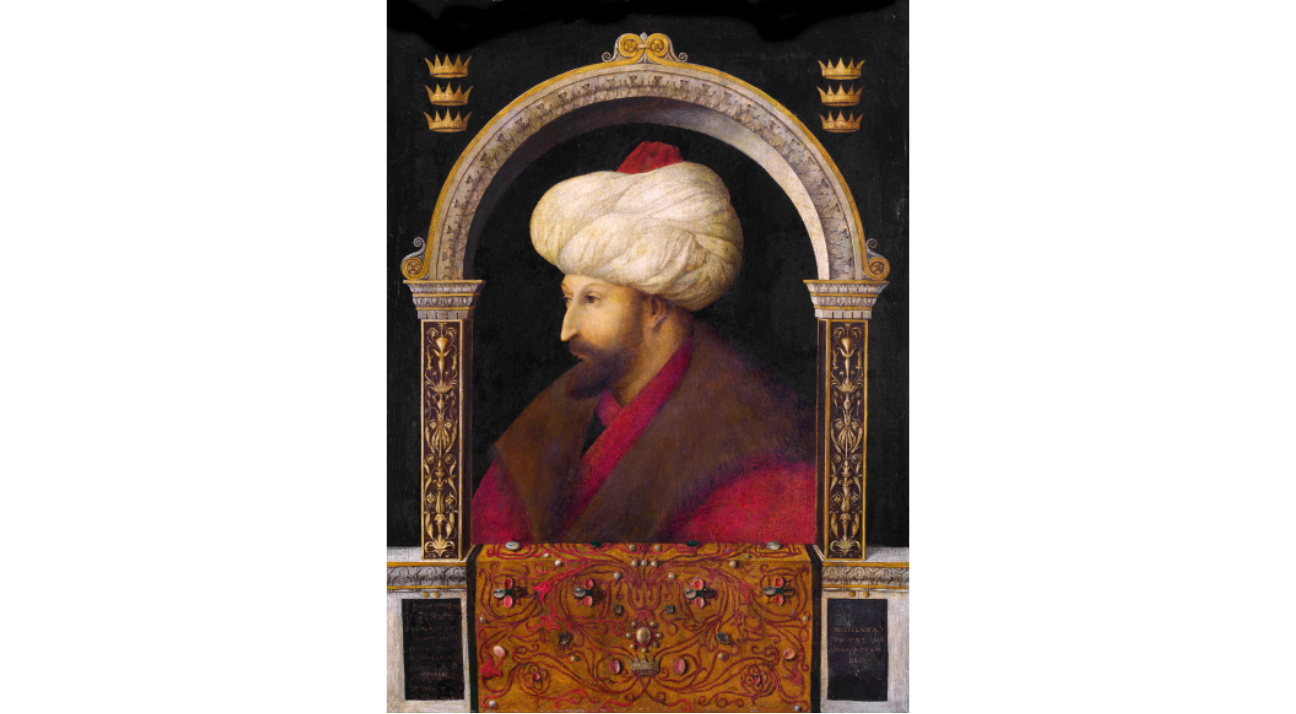
- connection between Venice and Ottoman-Turks existed
- Gentile Bellini becomes influenced by artwork from when he was away and place that influence into his art as seen in the portrait
- space between us and the sitter in the framed border
Portrait of Doge Loredam, 1501. Giovanni Bellini
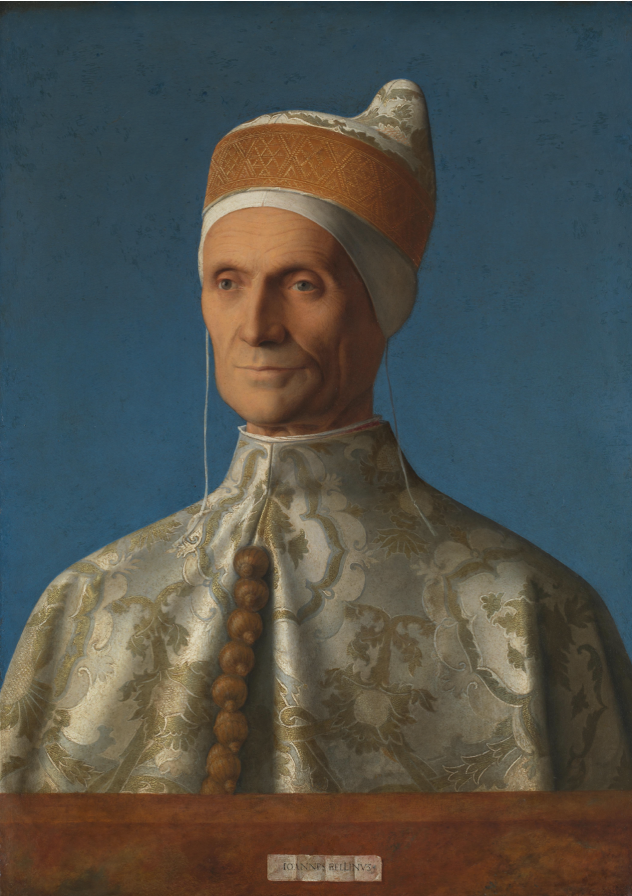
- pseudo-Islamic art, not real Islamic art
- co-opting the style for a specific purpose
- Venetian painters will paint, almost always, in oils
- Venice more interested in vibrant colors and is a lagoon, extremely humid, fresco painting doesn’t manage to survive in Venice as it does in Rome
Madonna and Child Enthroned, early 1500s. Gentile Bellini
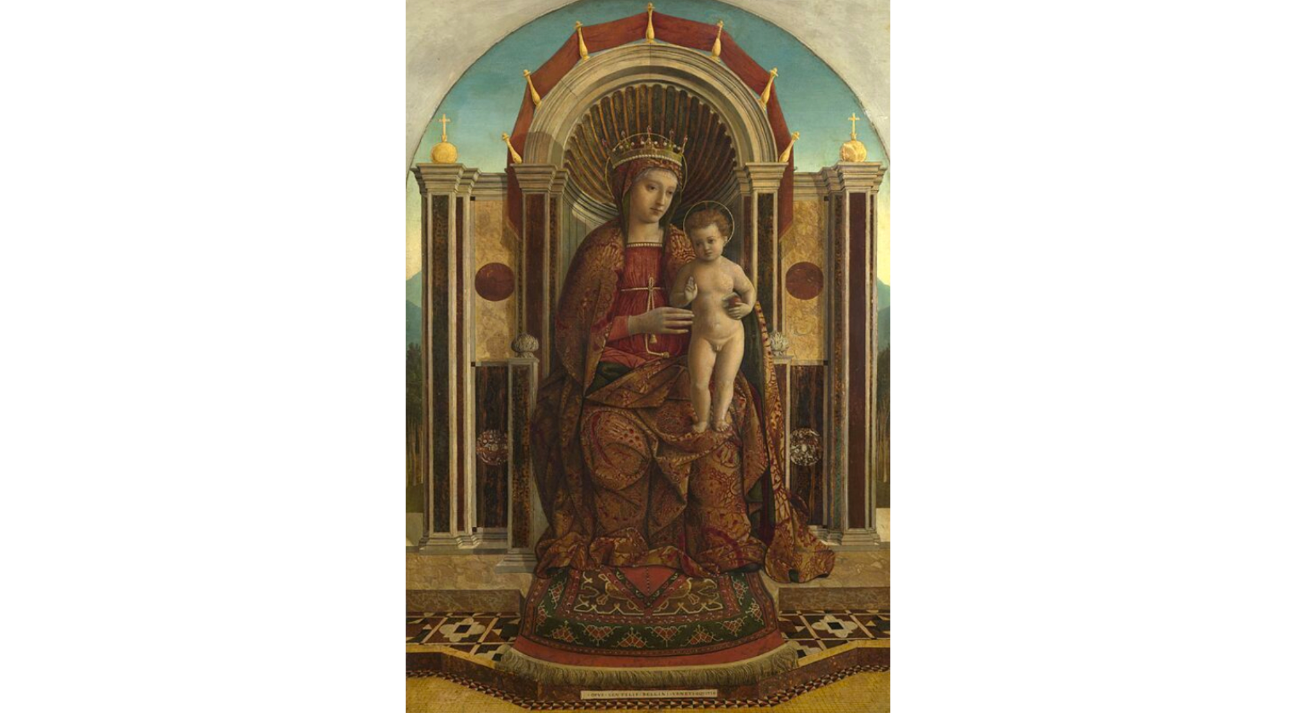
- connection between Venetian painters and Ottoman-Turkish art style
- fabric and architecture eludes to something eastern
- wasn’t attempting to recreate Rome, attempting to recreate fantastical Islamic Ottoman-Turkish architecture
- using these two styles as an influence
St. Francis in Ecstasy, 1480. Giovanni Bellini
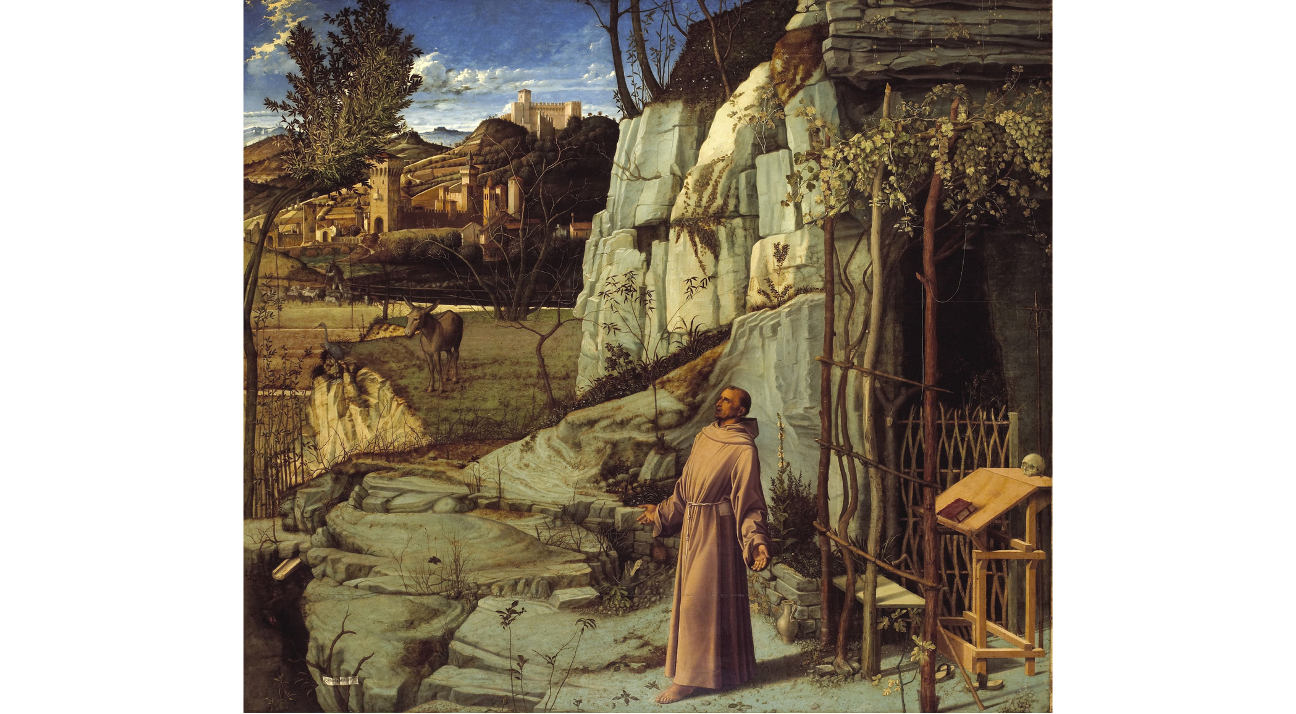
- Venetian painters using color in a different way
- separation of foreground and background using color
- foreground uses cool color, background using warmth
- donkey, symbol of working, hard work, monks pray and work
- donkey as an attribute of monks
- skull, reminder of death, momento mori
Giorgione and Titian
Sleeping Venus, 1510. Giorgione
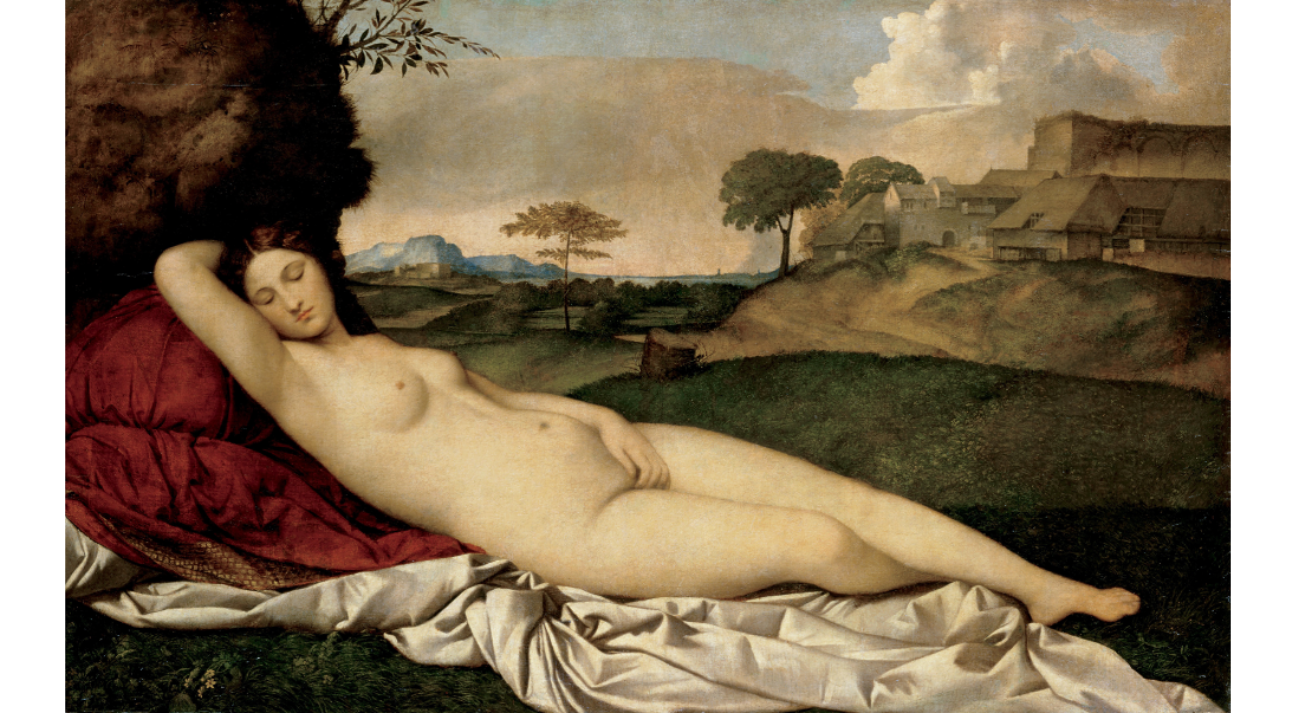
- taught by Bellini
- beginning of reclining female nude trope
- deities in the foreground, rolling hills, romantic vision of the countryside in the background
- harkening back to pre-Roman classical antiquity
- going back to Greece, underlines the fact that they aren’t as interested in Rome as the Florentines
- interest in landscape
- becomes more important than just an after thought
- landscape is fanatical, not an image or rendition of a real place
- composition
- diagonal, dynamic, asymmetrical composition in Venice
<<Venus of Urbino, 1532. Titian<<
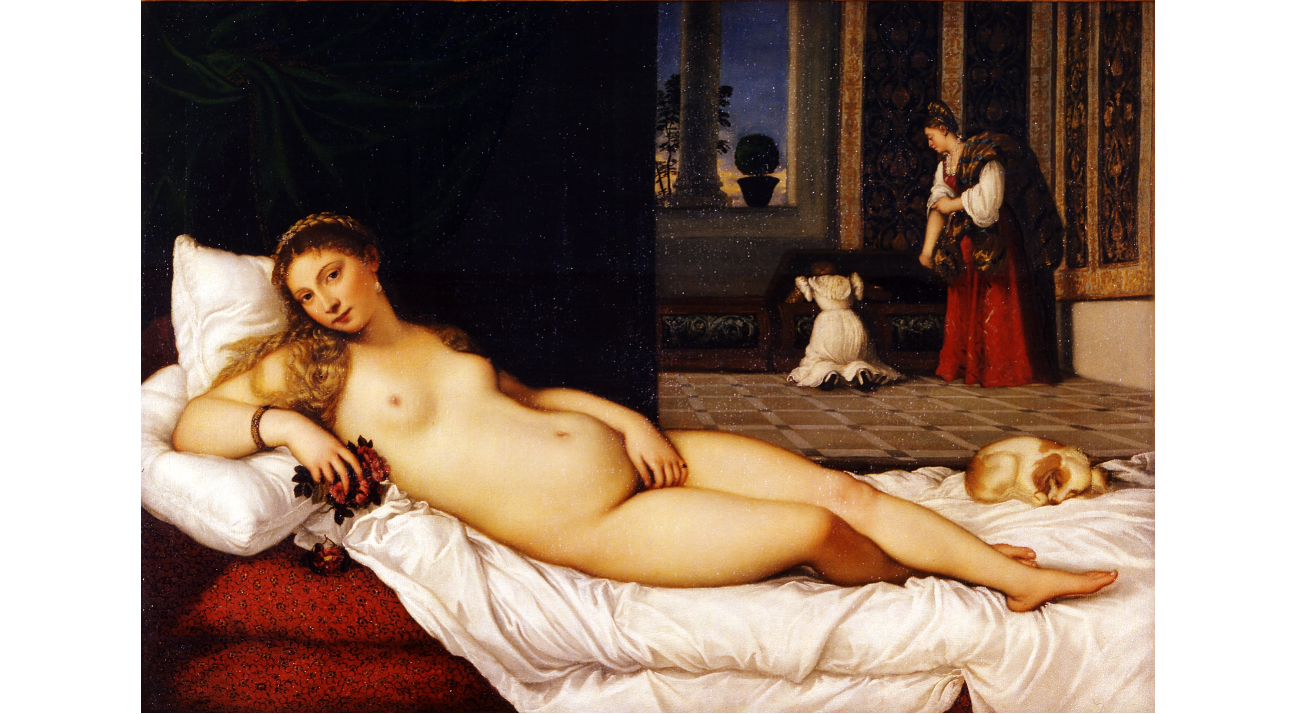
- this style is what becomes known as Venetian
- interior rather than landscape
- eyes directly engaging with the viewer
- people in the back theoretically can’t see her, pagan deities are only visible to the viewer and not to the people in the painting
- Venus is naked, wearing a bracelet and an earring
- implied sensuality, when something else is being worn, it shows that the person is naked rather than nude
- eluding to marital love
- dog, loyalty, Venus, love
- background, chest being prepared for the bride to take her belongings to her husband’s home
The Tempest, 1508. Giorgione
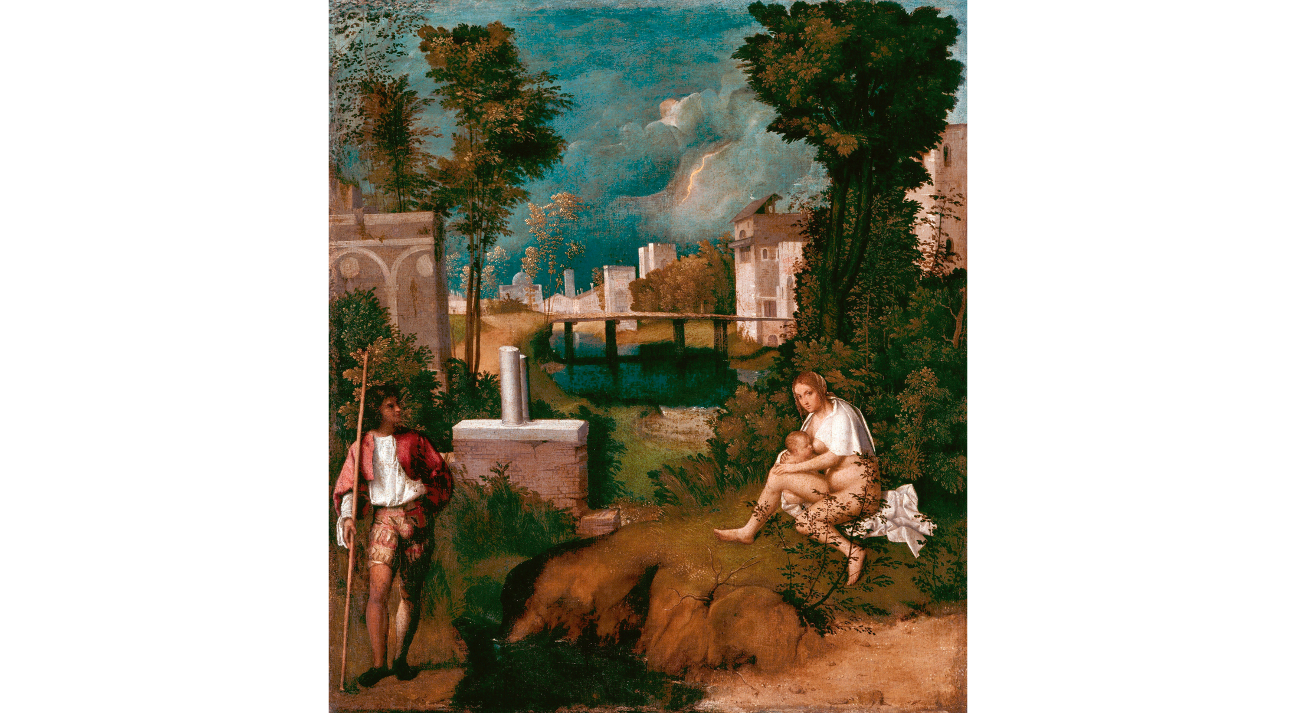
- painting of unknown meaning
- tempest, storm brewing in the background, could be an omen of something to happen
- women almost fully naked, man fully clothed
- early idea of the importance of landscape
- almost like the figures were painted after the background
Pastoral Concert, 1509. Giorgione
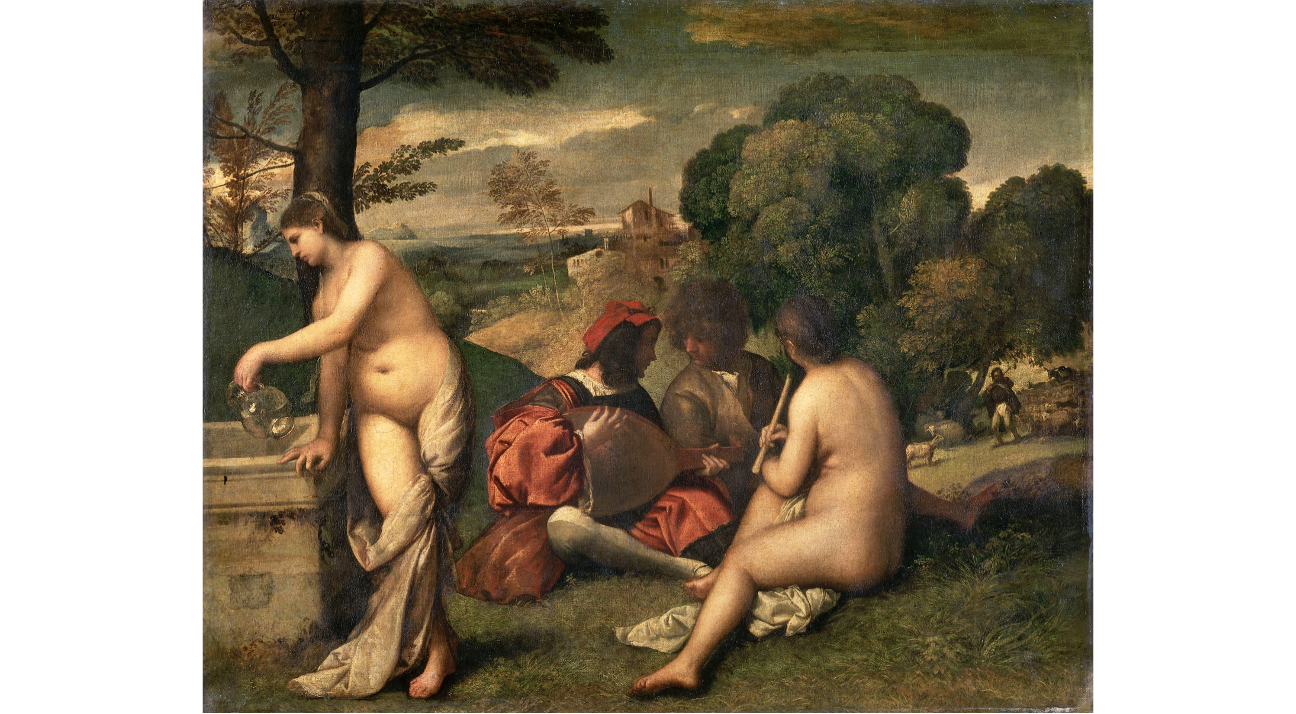
- separation of pagan deities from regular people
- the two men aren’t aware of the other figures in the painting
- two muses helping musicians find inspiration
- romanticization of the countryside
- Venetians wearing contemporary clothing, deities in the nude/naked
- muse collecting water, water important to music
Sacred and Profane Love, 1515. Titian
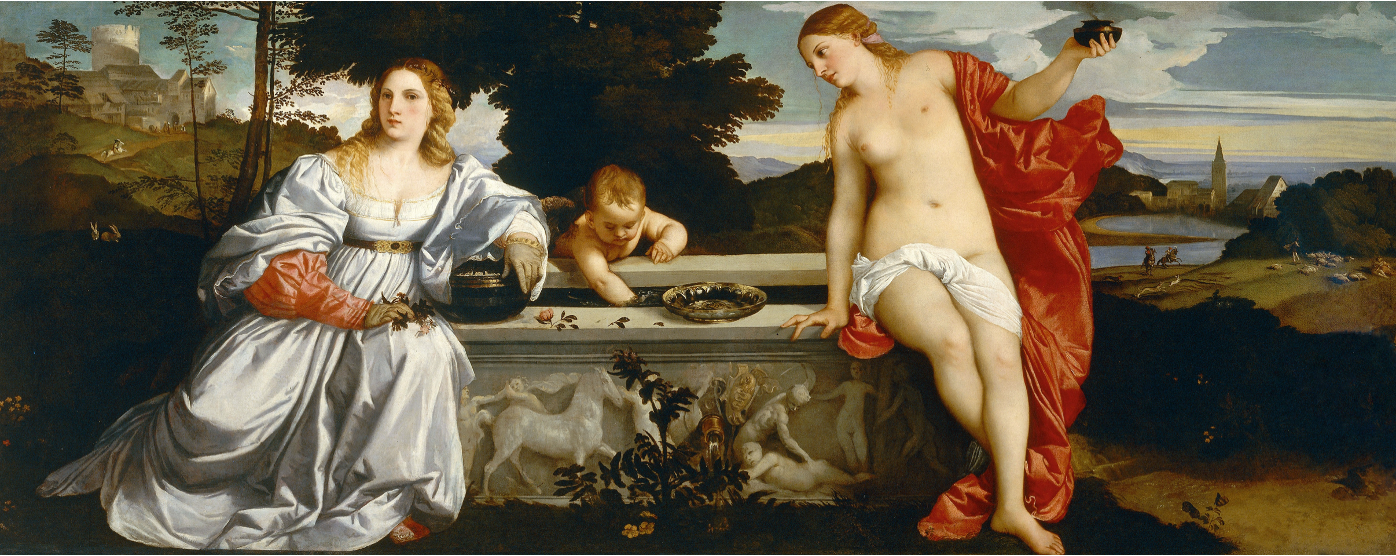
- to the left, Venus as sacred love wearing a wedding dress, marriage (marital love), the right, profane love
- red, the color of passion
- sacred love has very little red, profane has a large drape of red
- meant to represent all relationships with both sacred (monotheistic) and profane (pagan) love, opposing sides existing together in renaissance art
- Cupid, figure of mischief and love, represents a child changing the way a marriage is
Portrait of a Man with a Quilted Sleeve, 1510. Titian
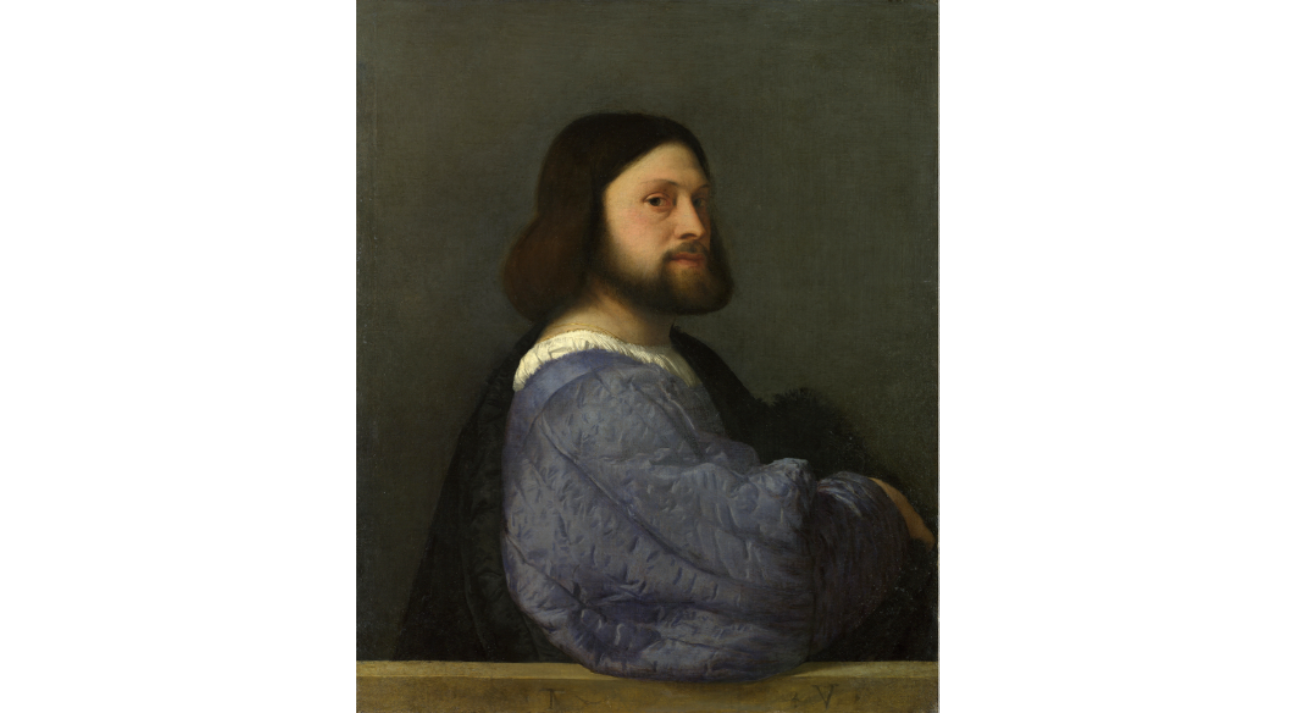
- psychological portrait
- complete blank and flat background, forces the viewer to look at the man’s stare head on
- side-eye, gaze attempts to demean, condescending
- armrest creates a separation of the viewer and the figure
Bacchus and Ariadne, 1522. Titian
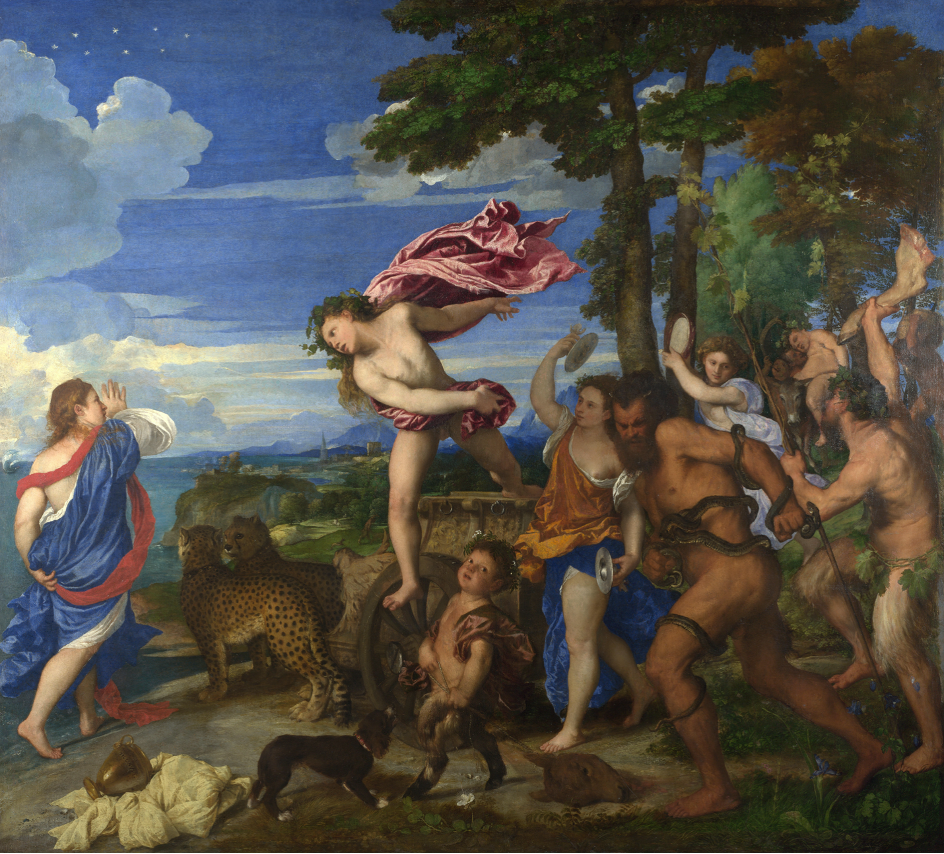
- expensive and vibrant colors
- vibrant blues, lapis lazuli
- Ariadne’s first encounter with Bacchus, who she eventually falls in love with
- the constellation Bacchus made for her above her
- brightness of Ariadne and Bacchus puts them in the spotlight
- composition is asymmetrical
<<Mars, Venus and Cupid, 1530. Titian<<
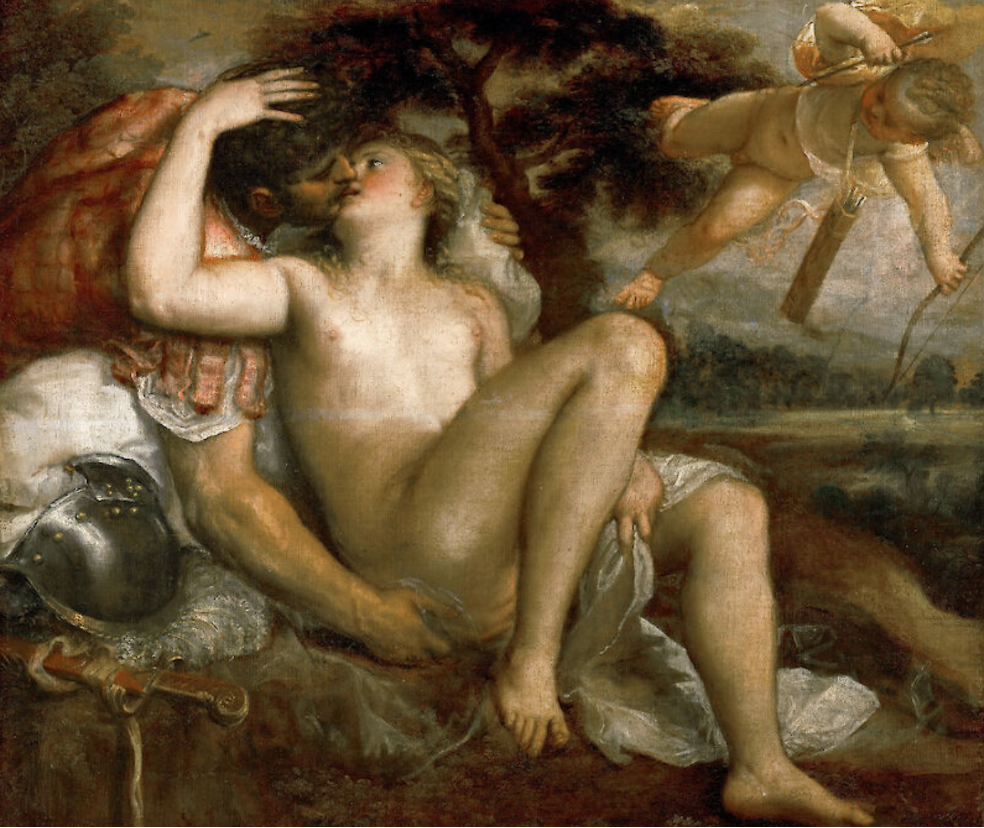
- background, no need to create a distinct separation between the foreground and the background
- leaves and trees, brush is more muddled, every leaf and branch is not drawn out
- diagonal composition, more dynamic organization
- Venus takes up the entire painting, pose is far more complicated
- something Michelangelo also did, Titian influenced by Michelangelo
- Titian begins to create more romantic and dynamic paintings by contorting and exaggerating the poses and the bodies of the figures in his paintings
<<The Rape of Europa, 1560. Titian<<
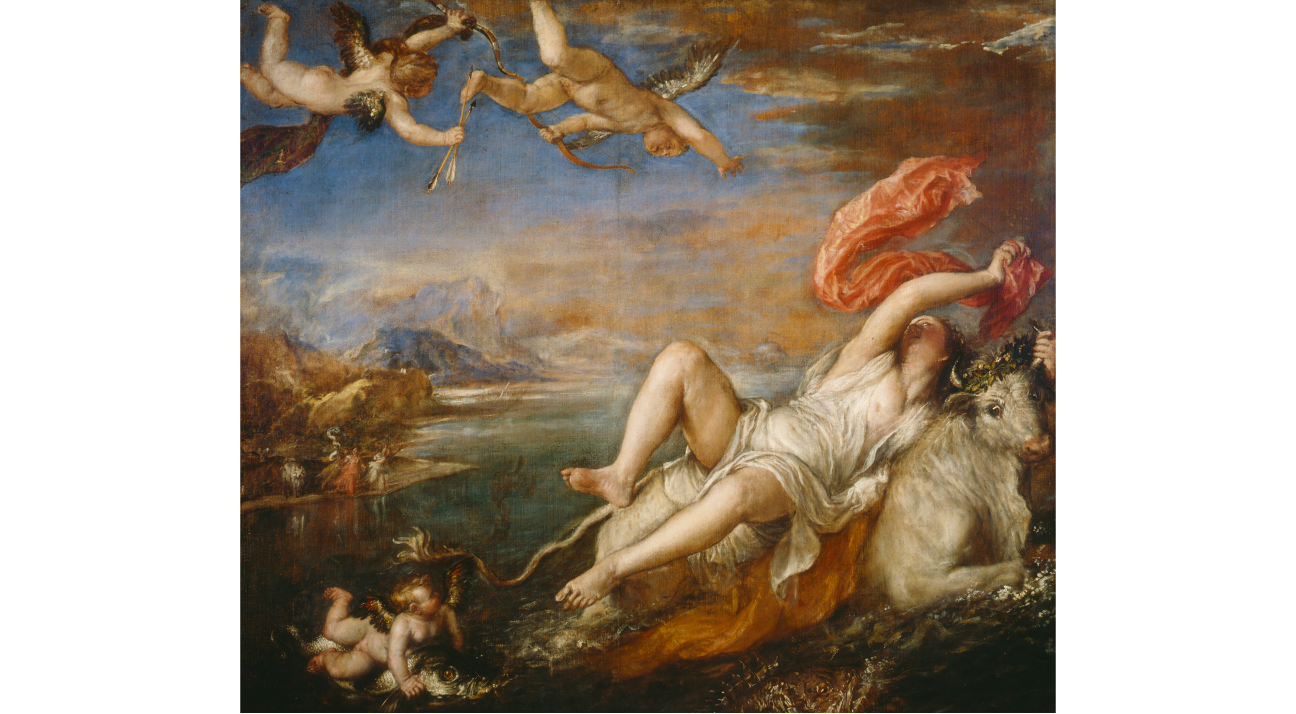
- dynamic angels (putti, mythological rather than religious), feels like they’re actually flying
- asymmetrical (Venetian), action on the bottom right and top left, the center is action-less
- the sky, blue and orange, opposing complementary colors, stand out more next to one another
- Roman theme from a poem, Ovid’s Metamorphoses
- theme of mythical love, renaissance painters are very interested in it
- red cloth represents Zeus’ (the bull) unbridled passion
- narrative thoroughly pagan
Perseus and Andromeda, 1554. Titian
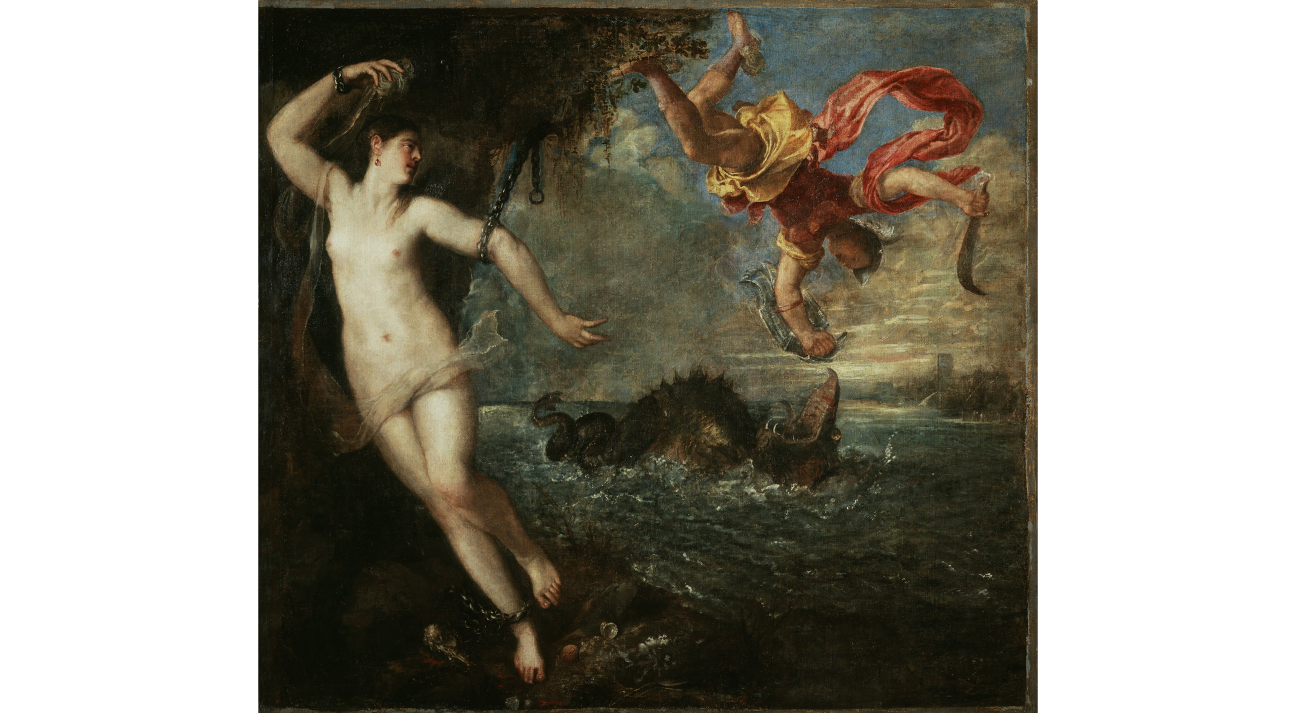
- Perseus saving Andromeda from the Kraken
- diagonal composition, vibrant colors, no sharp lines in the background
- simple brush strokes eluding to an image that the viewer finishes in their mind without it having to be distinctly painted
- Andromeda, dark background, light body, Perseus, light background, darker body and tones
<<Madonna di Ca’Pesaro, 1518. Titian<<
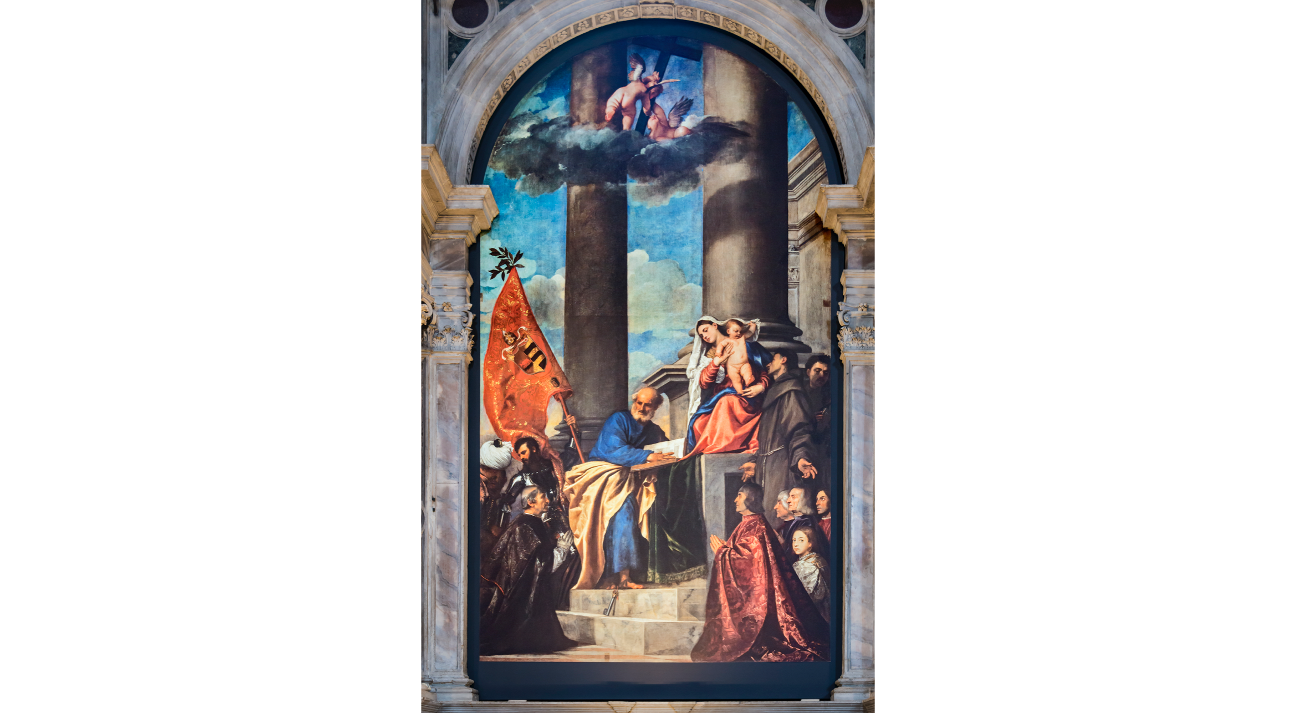
- three sections of the painting separated by two enormous columns
- angels above holding a cross
- Pesaro family, the family that paid for the painting, on the ground
- Saint Peter, Mary and child, other biblical themes positioned on the stairs above the ground
- portraiture, architecture, asymmetrical and diagonal composition - all Venetian
Michelangelo
Michelangelo
- Florentine
- tutored in the Medici home
- Medici were patrons of the arts
- Ghirlandaio taught Michelangelo how to paint, Giovanni teaches him sculpture
Triumph of Silenus, 1469. Bertoldo di Giovanni
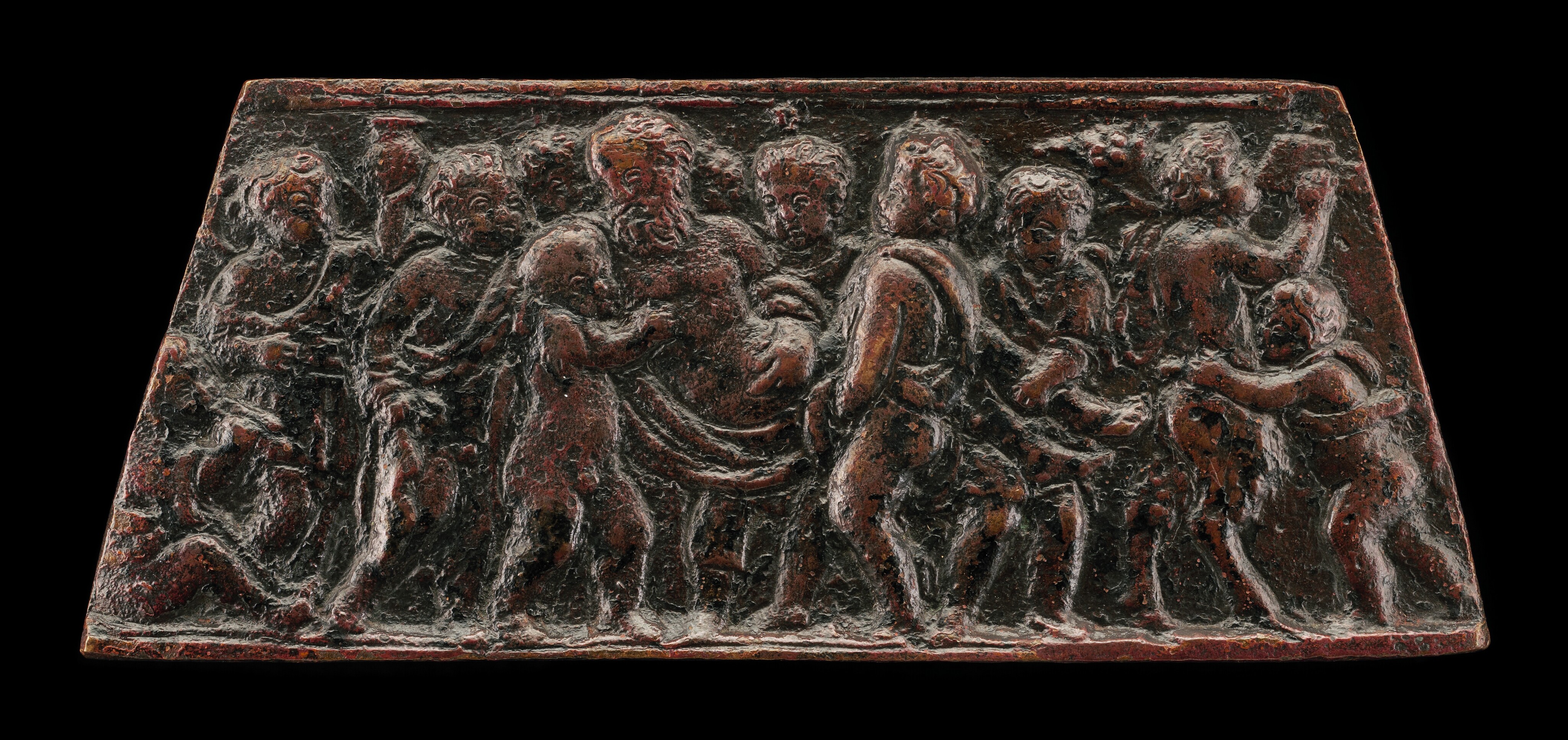
- classical in the way it was depicted
Hercules on Horseback, 1470. Bertoldo di Giovanni
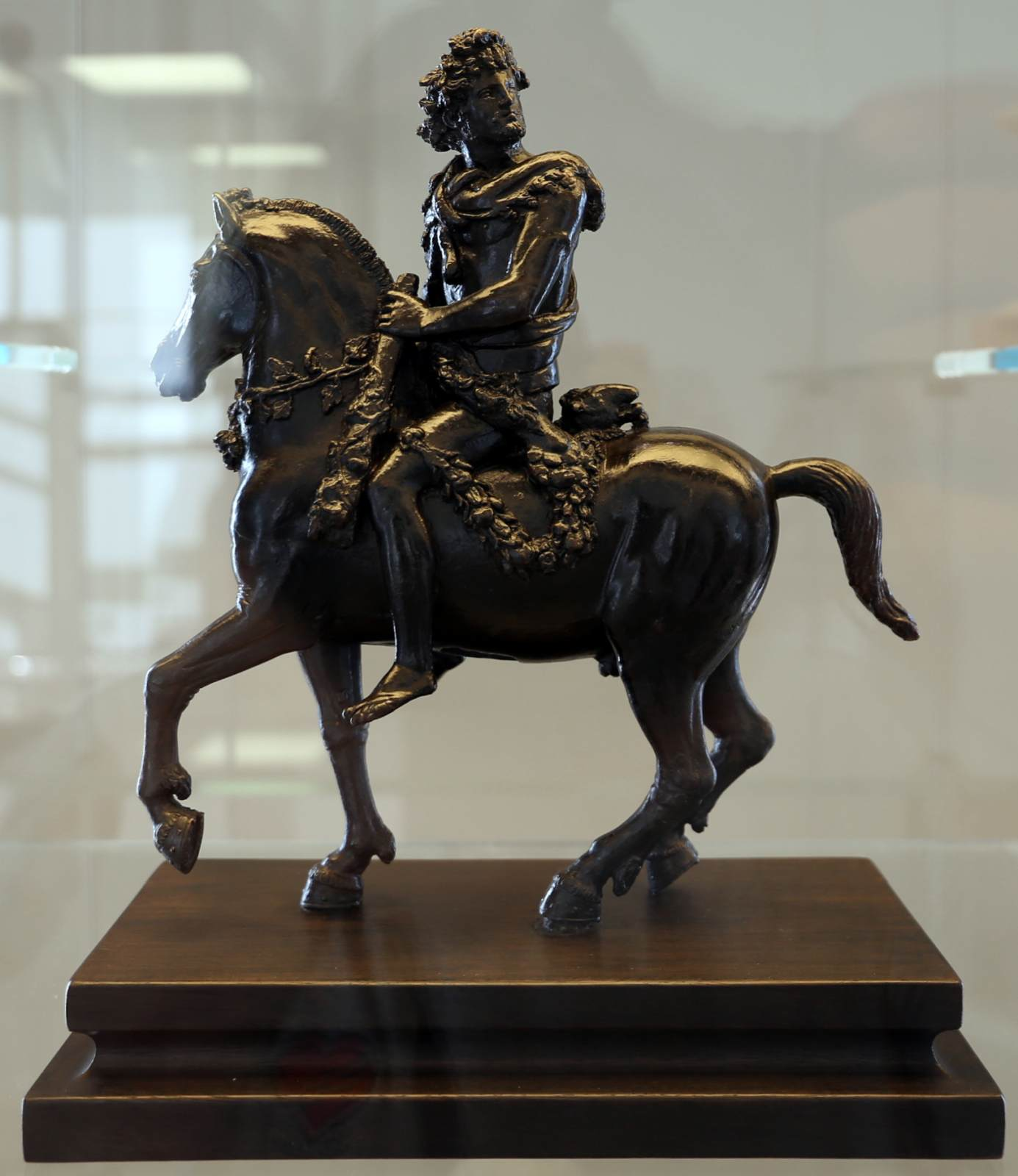
Madonna of the Steps, 1491. Michelangelo
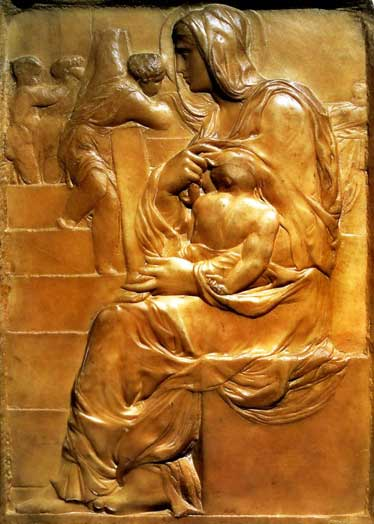
- protagonists are the biggest
- figures at the top of the steps are unknown, their purpose is unknown
- figure of Christ, his back is towards the viewer
- his arm looks uncomfortable in position
- Mary is not facing the viewer, face in profile
- Michelangelo makes complicated poses that seem unnecessary
Battle of Hercules with Centaurs, Michelangelo 1491
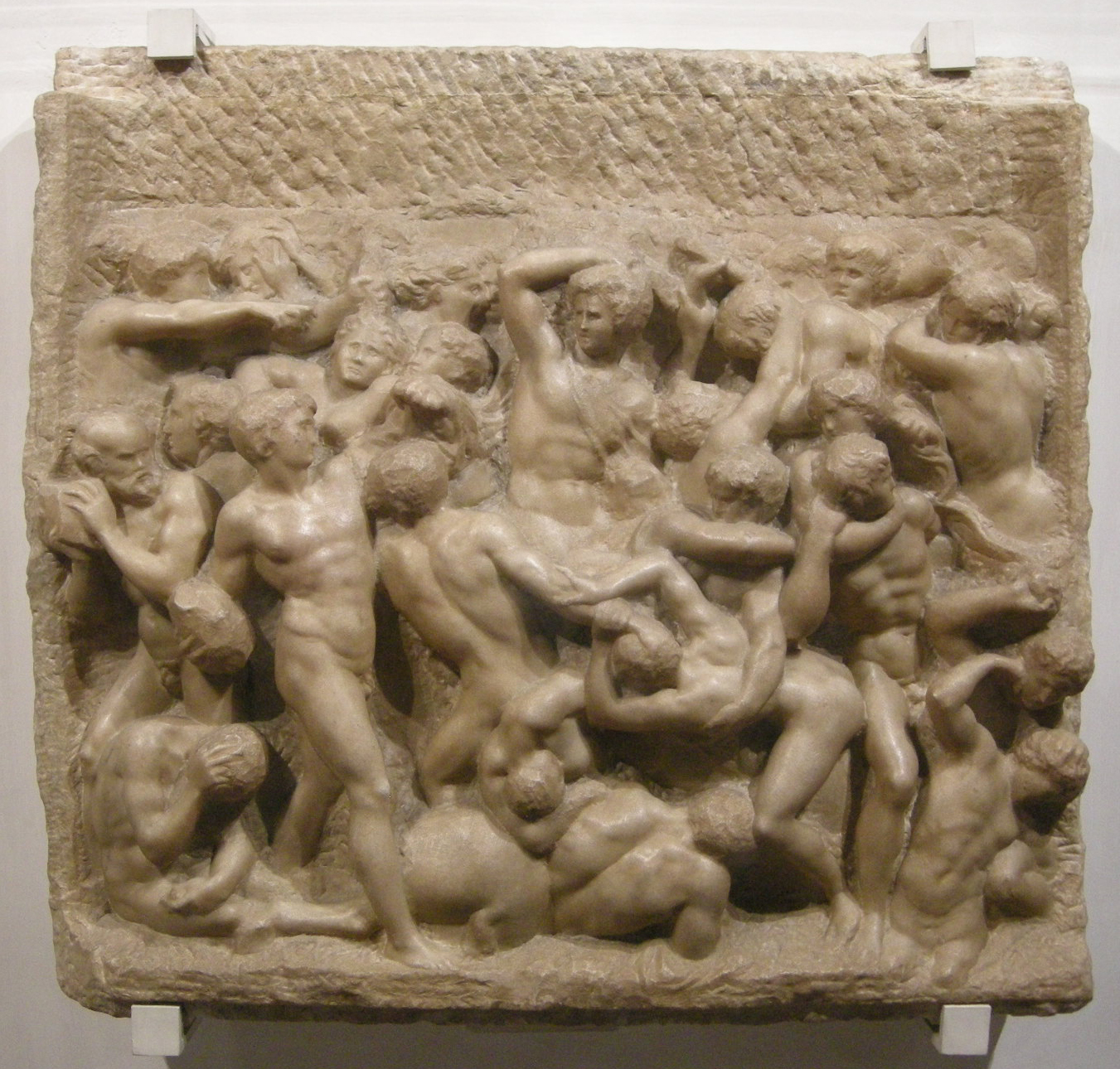
- complicated and muddled poses, can’t decipher how many figures there are exactly
<<Bacchus, Michelangelo. 1496<<
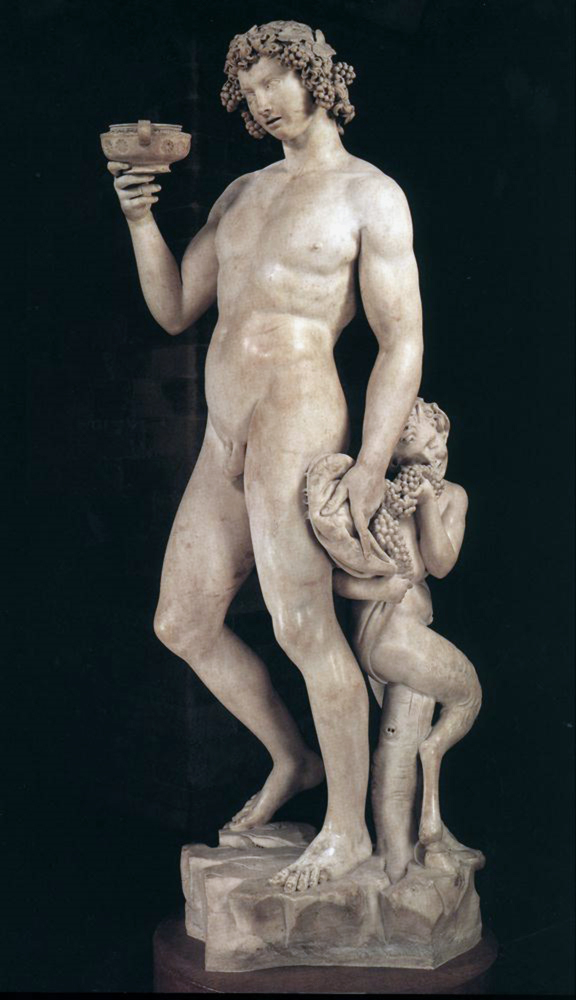
- Bacchus leaning to the left, drunken, and satyr being mischievous
- opposite use of the contrapposto pose to make Bacchus look and seem drunk
- Michelangelo places the satyr on the left to make the sculpture more stable
- satyr stabilizes Bacchus from falling over
The Torment of St. Anthony, Michelangelo. 1487
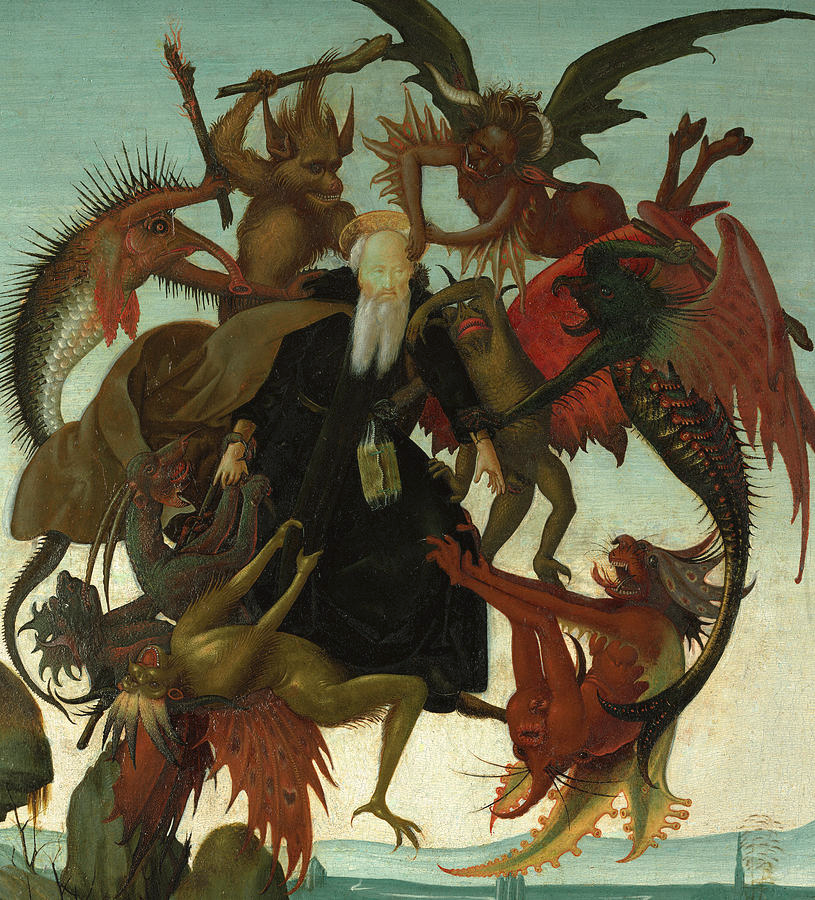
- small oil painting from a young Michelangelo
- pre-existing painting that Michelangelo recreated and copied
- looking and tutoring classical antiquity
<<Pietá, Michelangelo. 1498<<
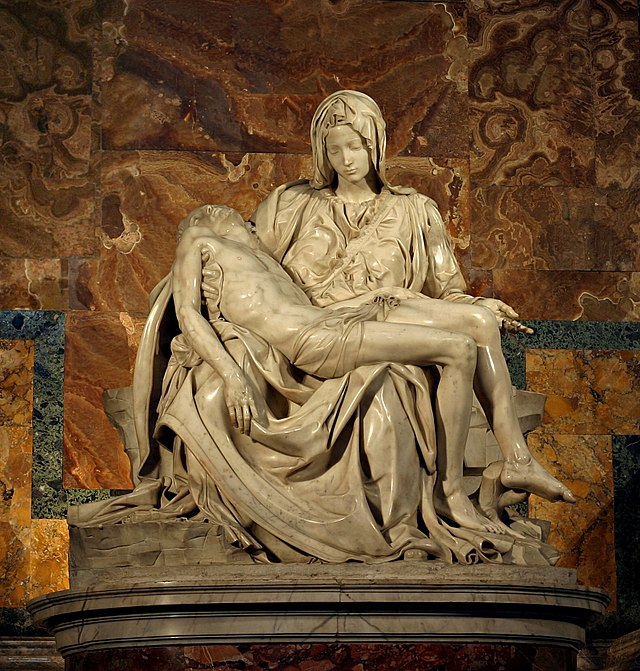
- gothic theme of Mary and corpse of Christ
- emaciated and long body of Christ
- exaggeration of Mary’s body to make sure Christ wouldn’t dwarf her as she would be much older and smaller than her 33 year old son
- her legs act as a base for Christ, longer to satisfy his composition
- pyramid, triangular composition
- Mary is very young despite having a 33 year old son
- Michelangelo says that Mary should always look youthful and chaste
- only work of art Michelangelo signed (on Mary’s sash)
- beginning of owning the work and marking it as theirs
Battle of Cascina, Michelangelo. 1504
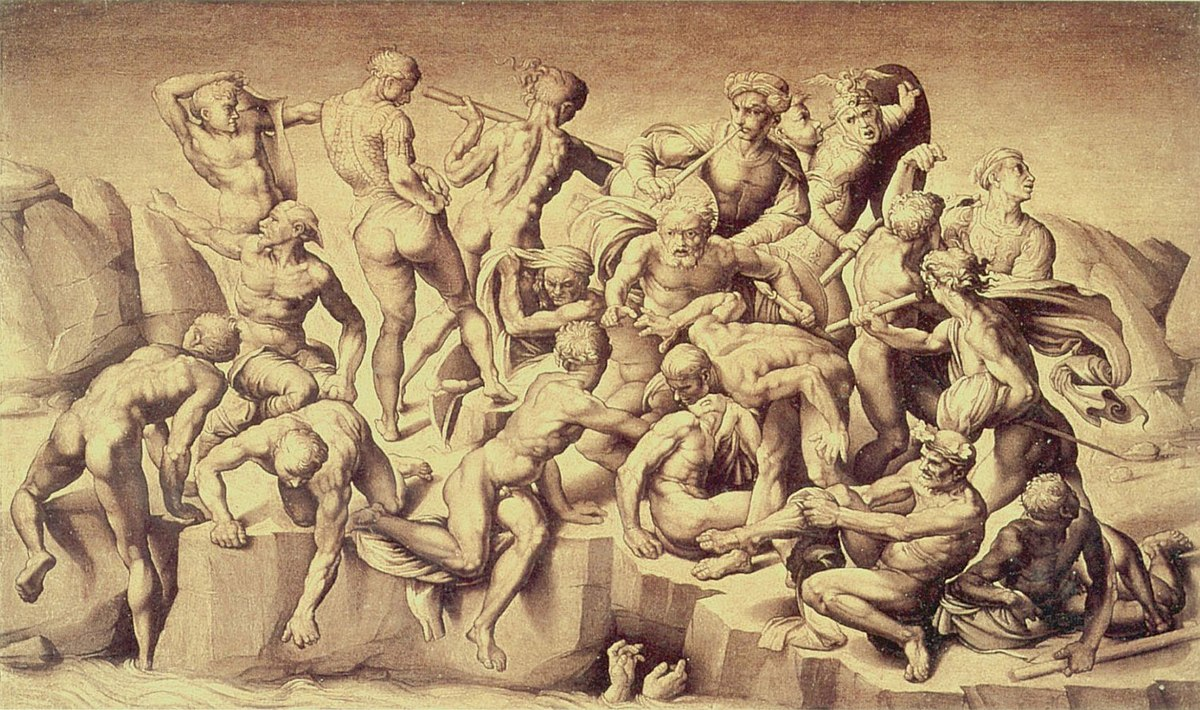
fresco painting, battle scene
Leonardo does another painting of a battle in the same room in Florence at the same time
this time, there is an actual fighting scene rather than the scene before the battle
paintings are missing despite being painted on walls, theoretically covered up and painted over to protect them
drawings done by neither Leonardo or Michelangelo, by artists who wanted to learn
twisted, contorted and complicated figures and poses
Michelangelo decides to paint the scene before the battle
- seen in his sculpture of David, sculpting the scene of David before he kills Goliath
- adds a sense of drama
Pope Julius II - High Renaissance
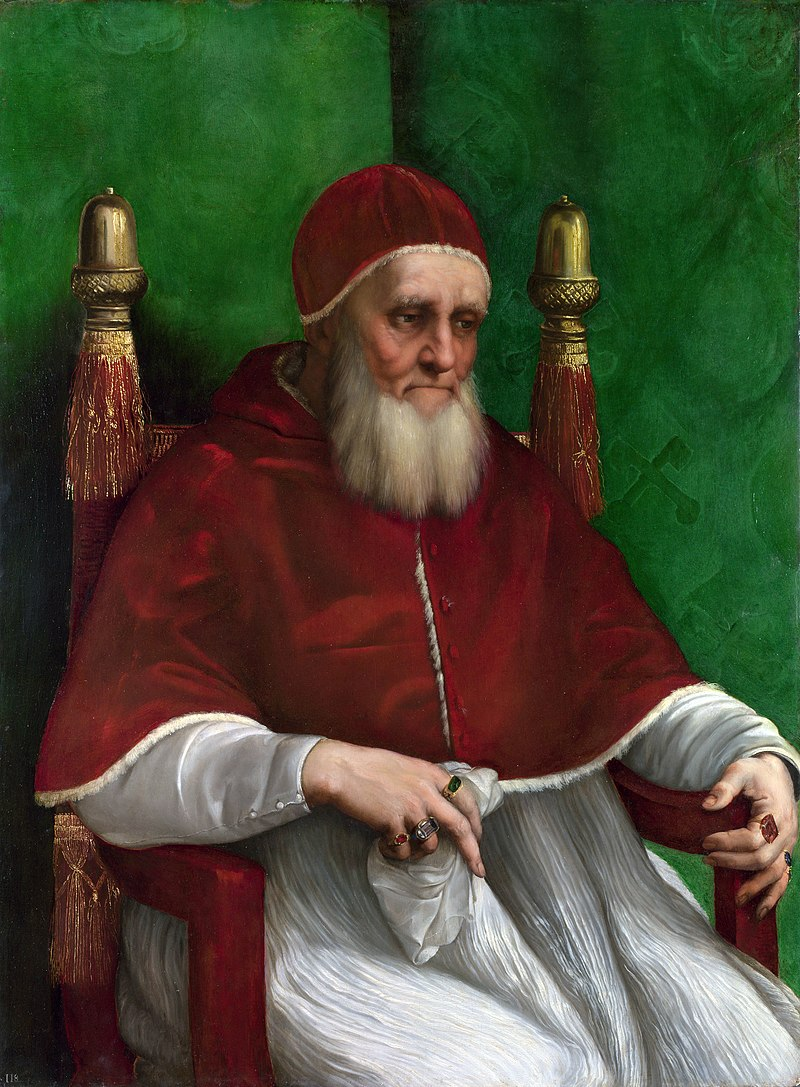
- invested a lot of money into the patronage of the arts
- forced Michelangelo to buy materials with his own money, never paid him back
Tomb of Pope Julius II, San Pietro in Vincoli (1505-1545). Michelangelo, Rome.
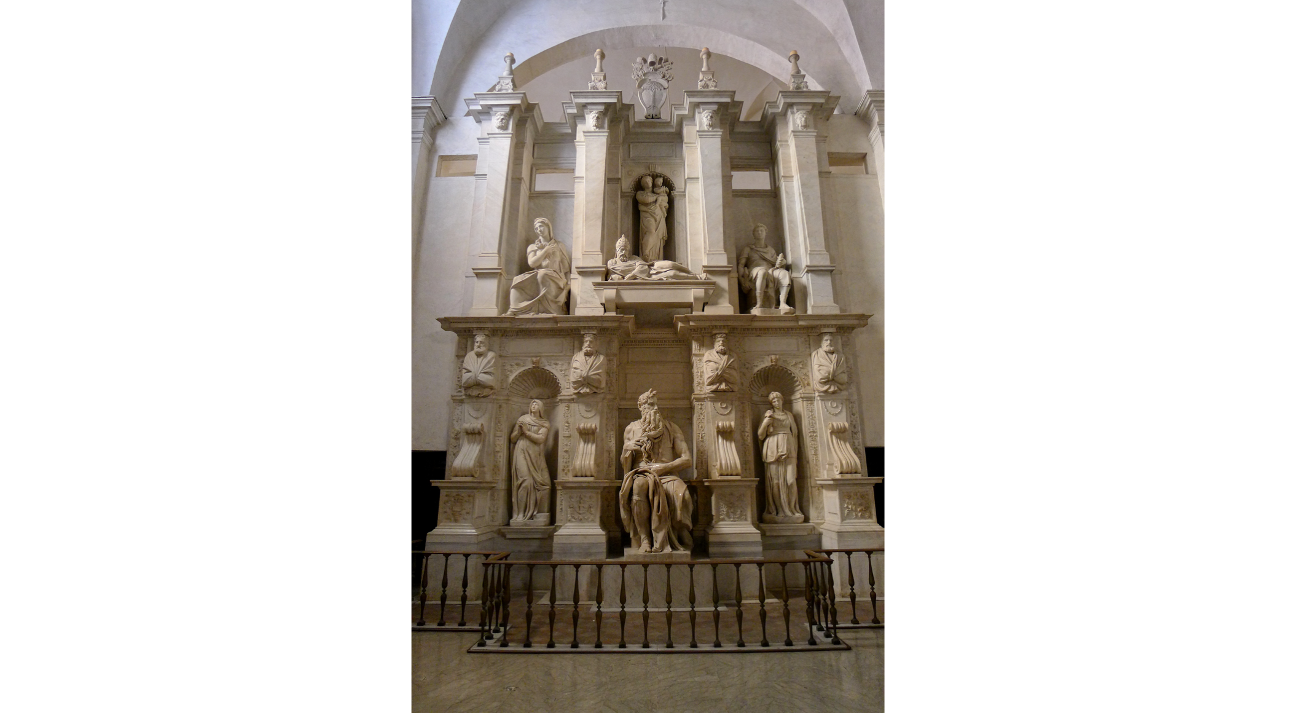
- Michelangelo put in charge of the construction of the entire front
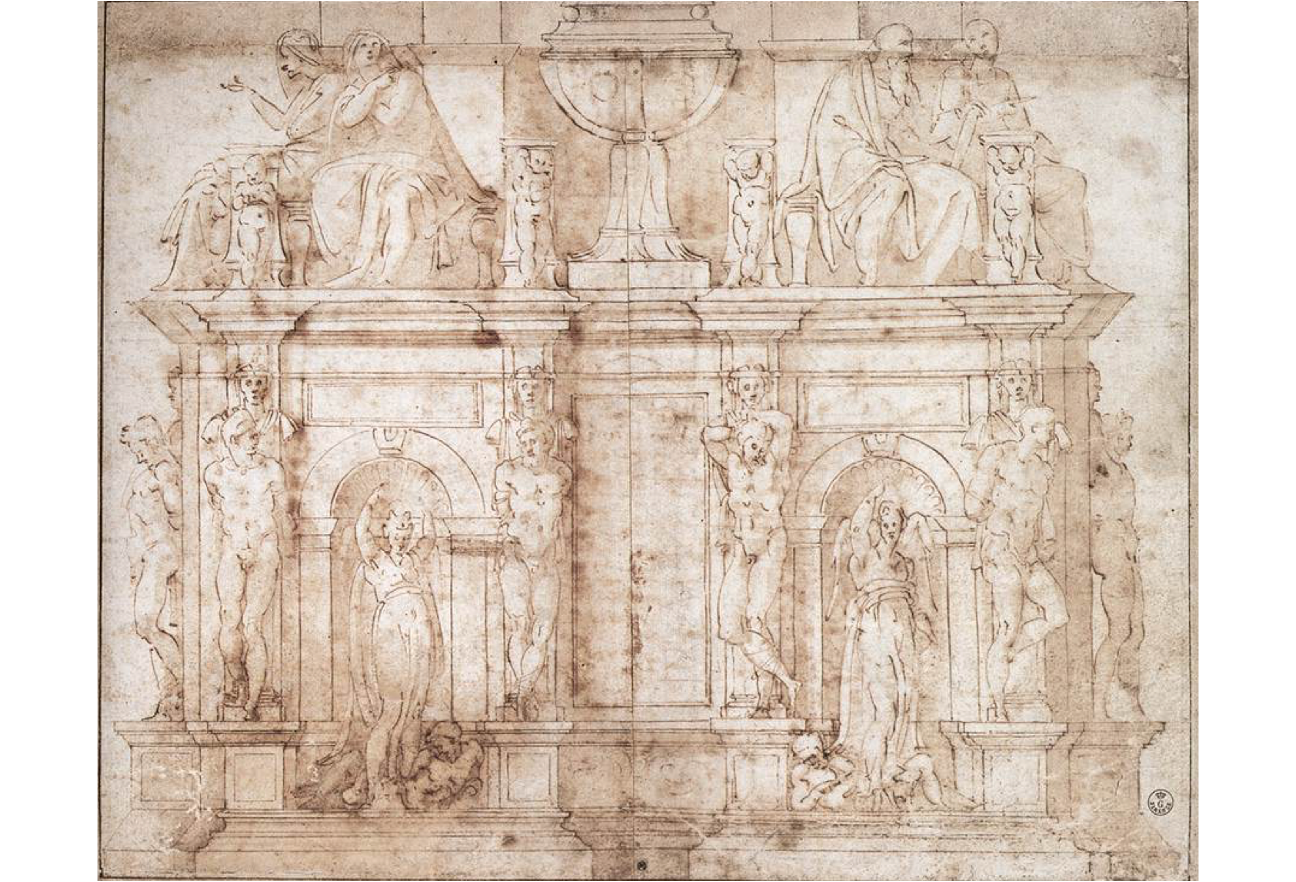
- the tomb plan, only one sculpture in the entire tomb was done by Michelangelo, “Moses 1513”
Moses, 1513
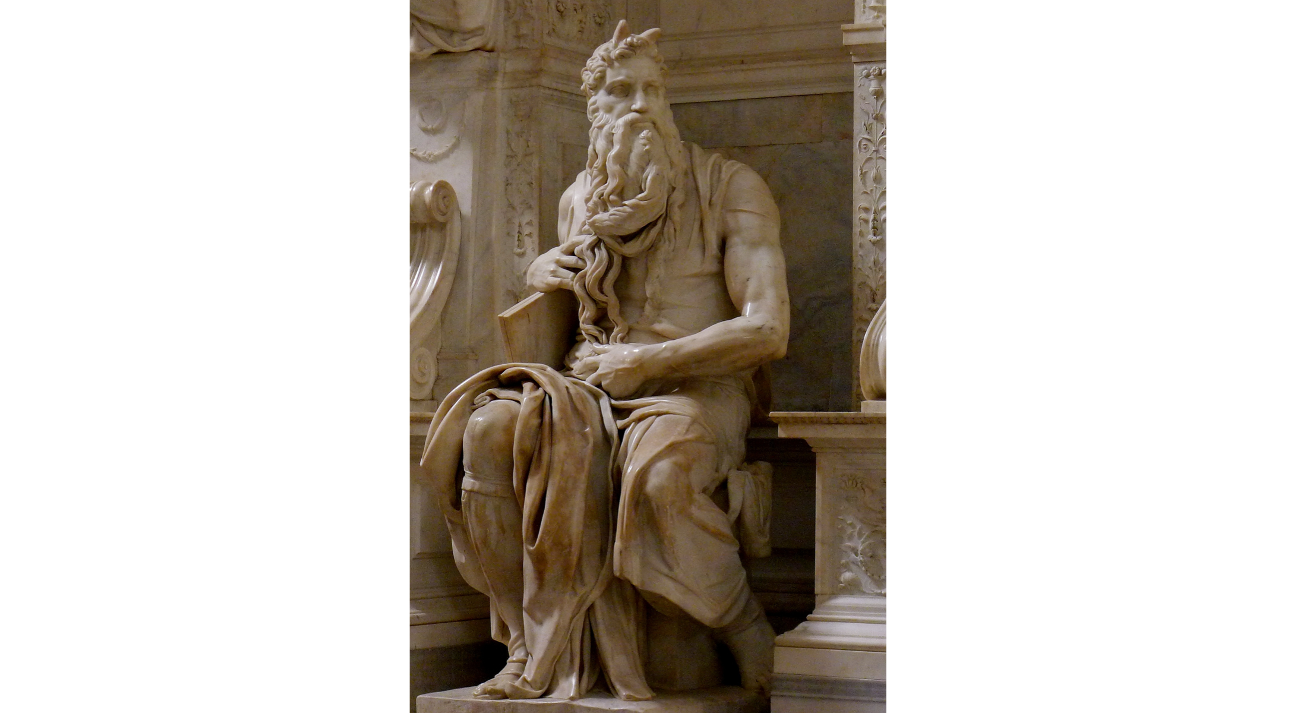
- powerful, athletic build for an older man
- Michelangelo isn’t interested in the veristic style (Rome, interested in the idea of age and wisdom)
- more interested in physical beauty, aesthetics
- tension, looks like he’s going to get up/stand
- Michelangelo and exaggerated features of the figures, long torso, makes his upper body seem more powerful
- mistranslation of the biblical text, Moses has horns
- meant to be light coming from his dead
- sculpture represents a physical representation of mistranslation in religious texts
Rebellious Slave
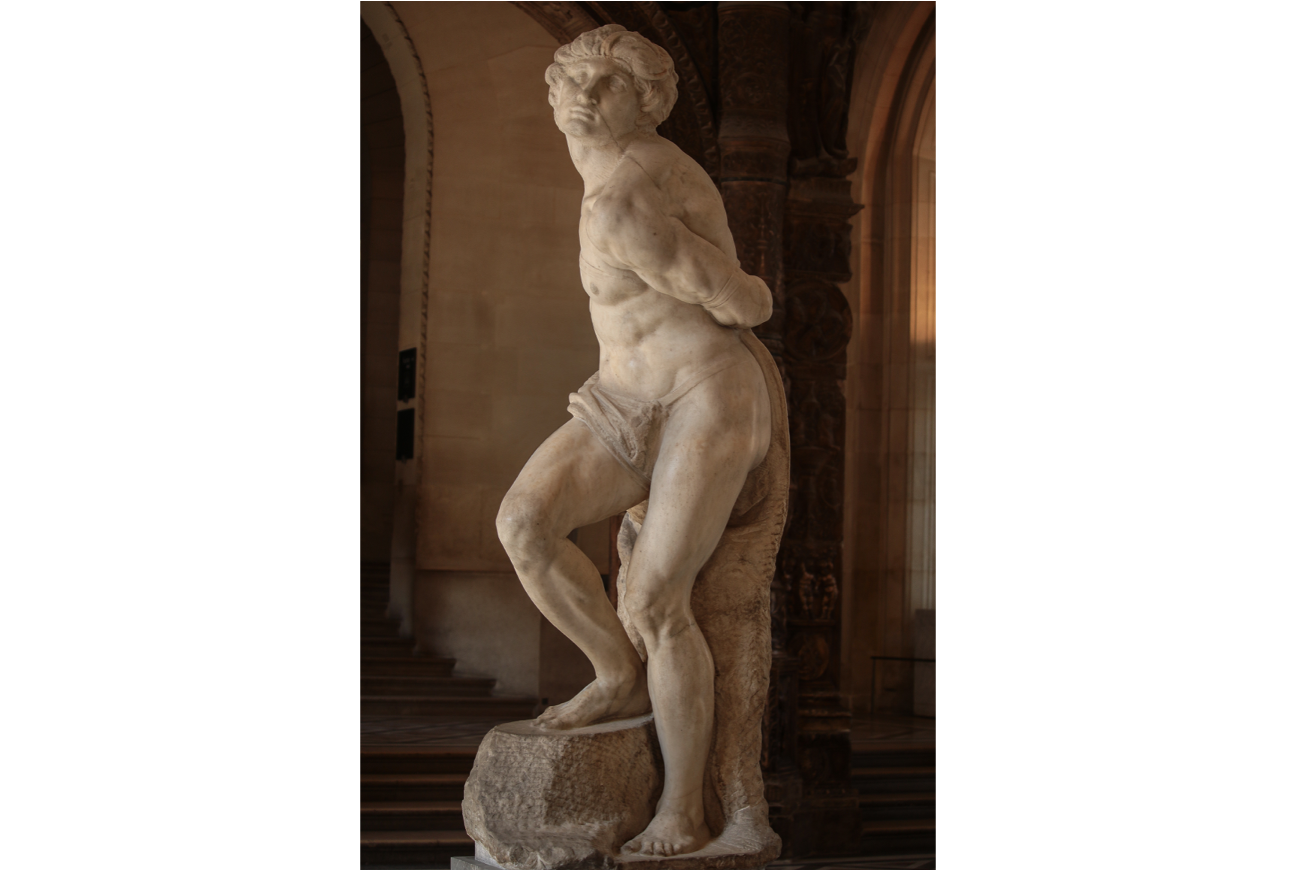
- group of sculptures Michelangelo had never finished, theoretically for the tomb of Julius II
- a way Michelangelo managed to discuss different facets of humanity
- helps in understanding how Michelangelo carves figures
- worked all around the stone, felt like he was liberating figures trapped in stones
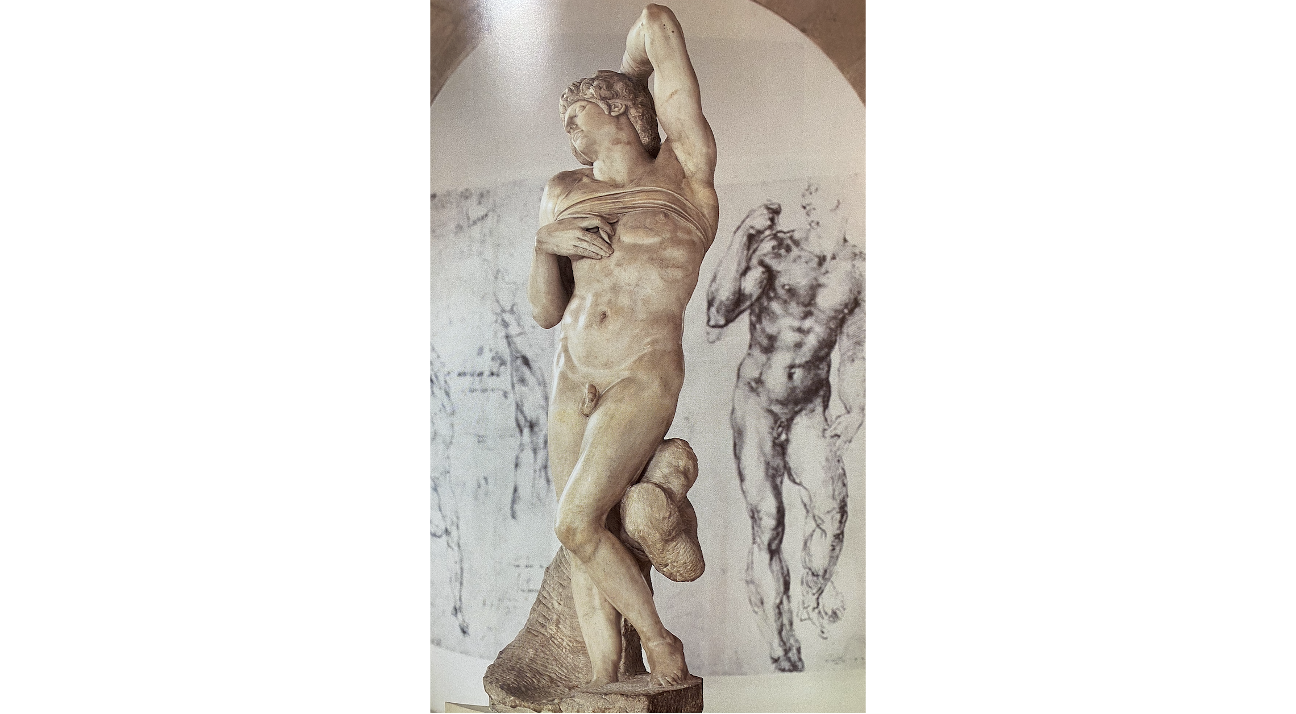
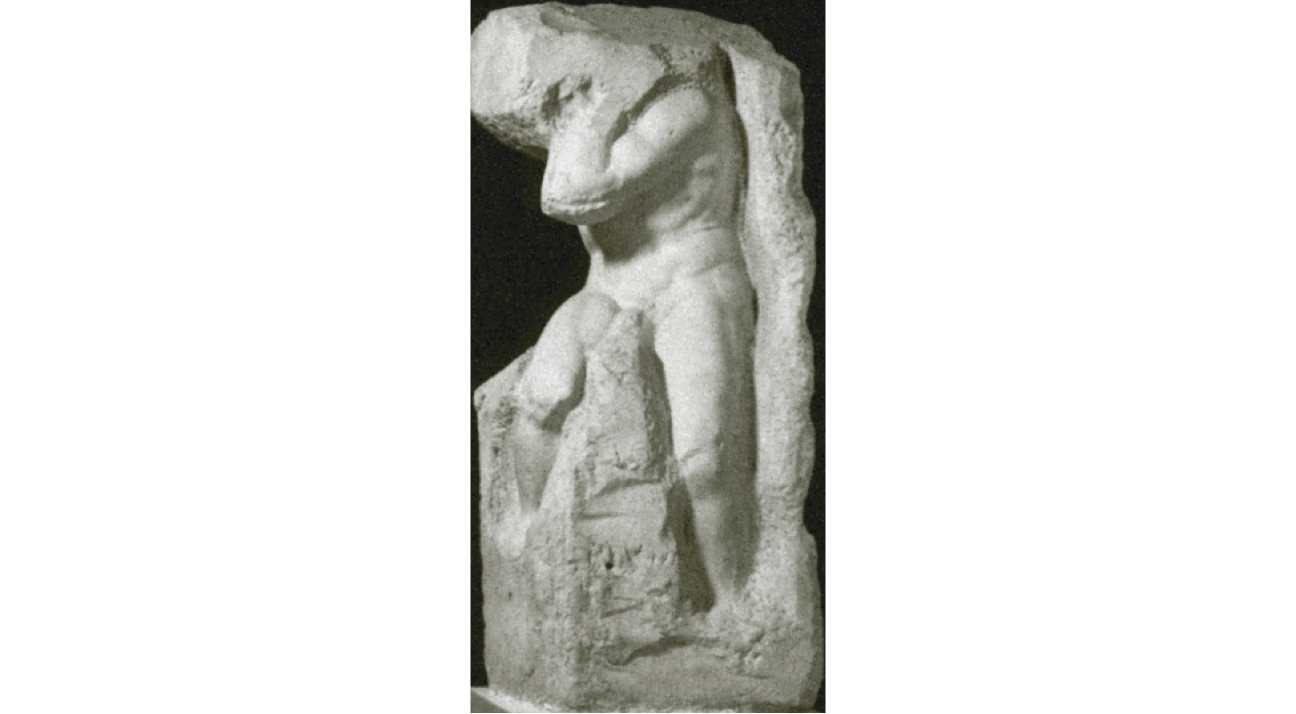
- elegant and sensual positions
- first time since classical antiquity that sculptures have pathos
- ==non finito== - unfinished
==figure serpentinate== - serpentine figures
- figures are contorted, turned, intertwined
- must have both figures to complete the idea
==Mannerism==
- younger artists looking at Michelangelo for inspiration, taking on the same ideas that he did
- born from the early exaggeration of the figures by Michelangelo
- multiple figures that are far more active rather than stationery (contrapposto)
- creates a more dynamic sculpture
- offshoot of the high renaissance
- paintings are confusing
- there is no indication of who or what the figures are, who they represent, what the extra figures mean, etc.
Genius of Victory, 1519. Michelangelo
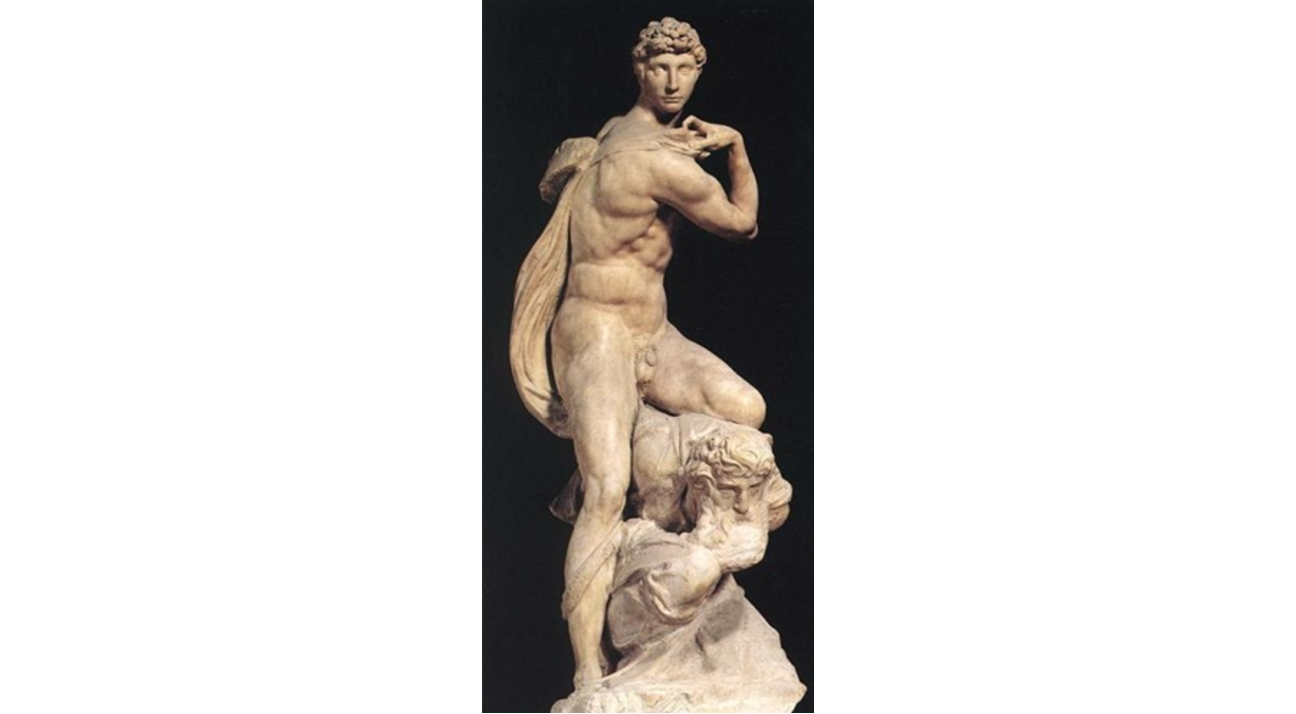
- elongated torso, exaggerated features
- figure serpentinate
- top figure, more powerful, bottom figure, subjugated
- allegorical figures, can be connected to any two opposing forces
Florence Victorious Over Pisa, 1565. Giambologna
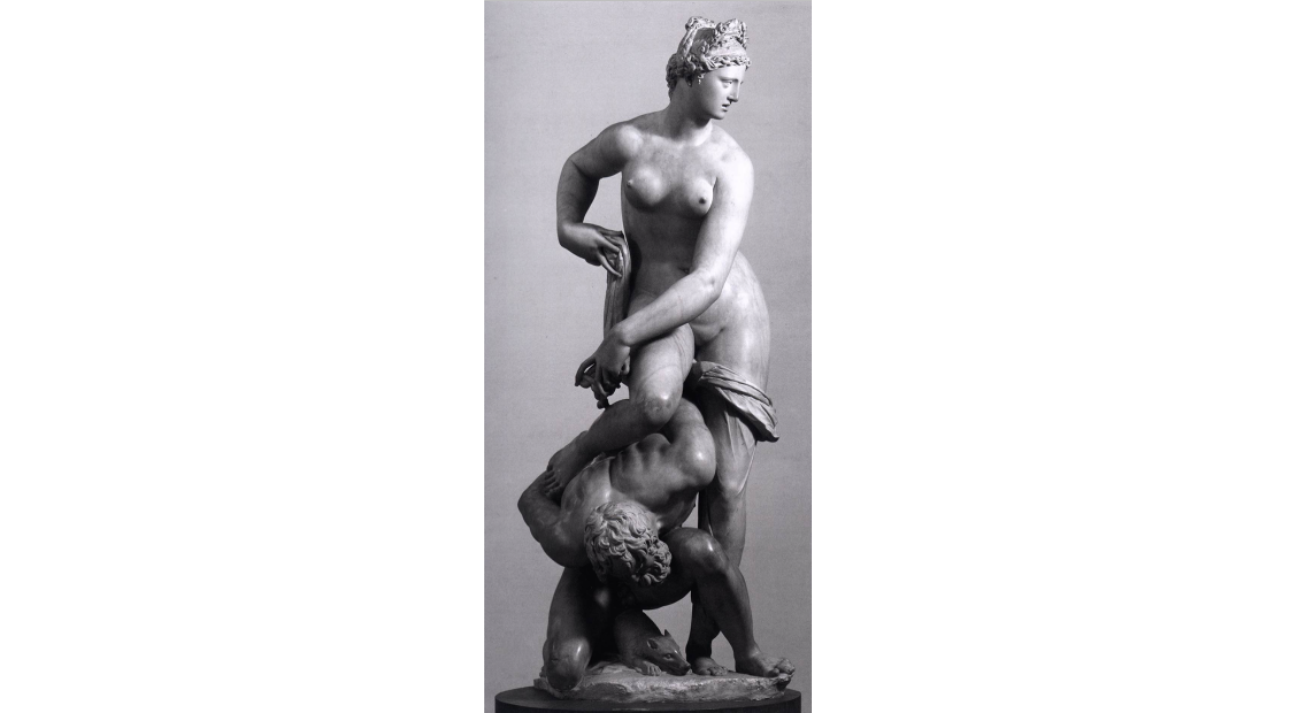
- Mannerist sculpture
- powerful figure subjugating another
- figures are contorted and intertwined
- idea taken from Michelangelo
- taking the human body and creating a less stiff, more fluid sculpture
- does not exaggerate the body
<<Il Ratto Della Sabine, 1574. Giambologna<<
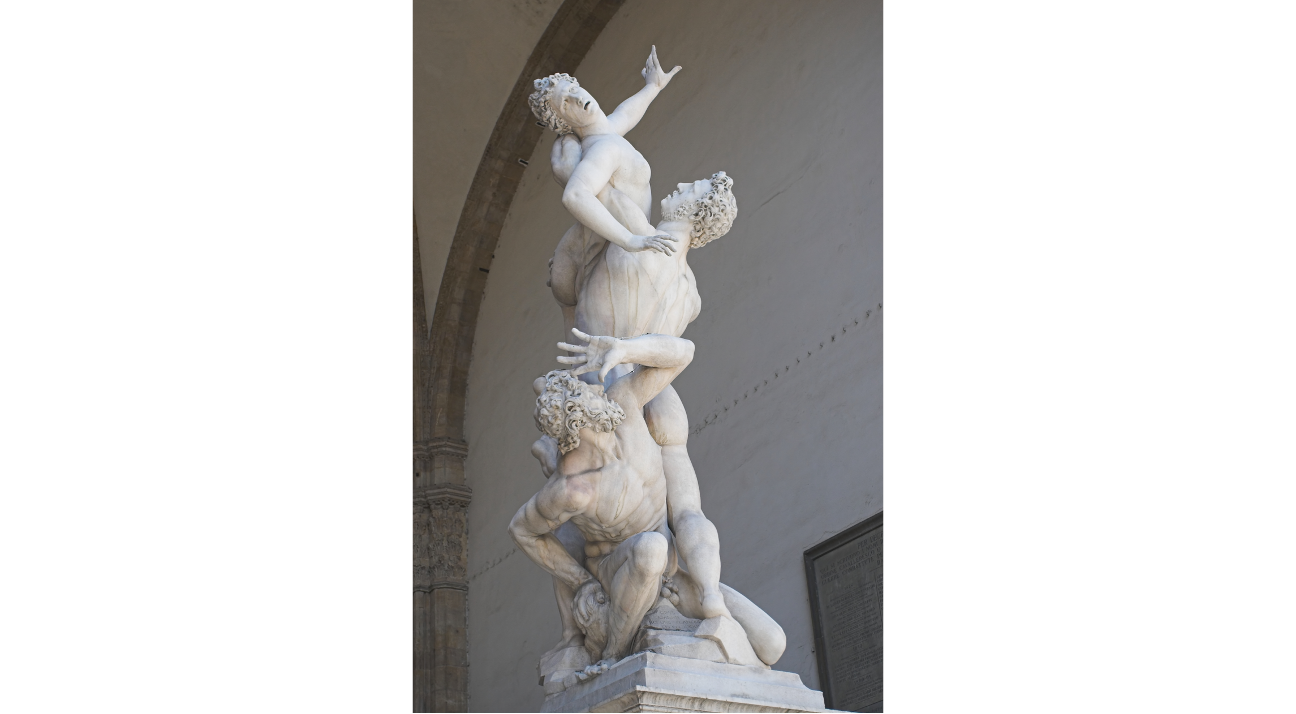
- figures are interconnected
- each figure is needed to complete the narrative
- beginning of the Roman republic (Florence sees itself as the return of the Roman republic), population was dwindling as a result of continuous war, invited the Sabines for a festival, once they arrived, Roman soldiers stole all the Sabine women
Hercules and Nessus, 1599. Giambologna
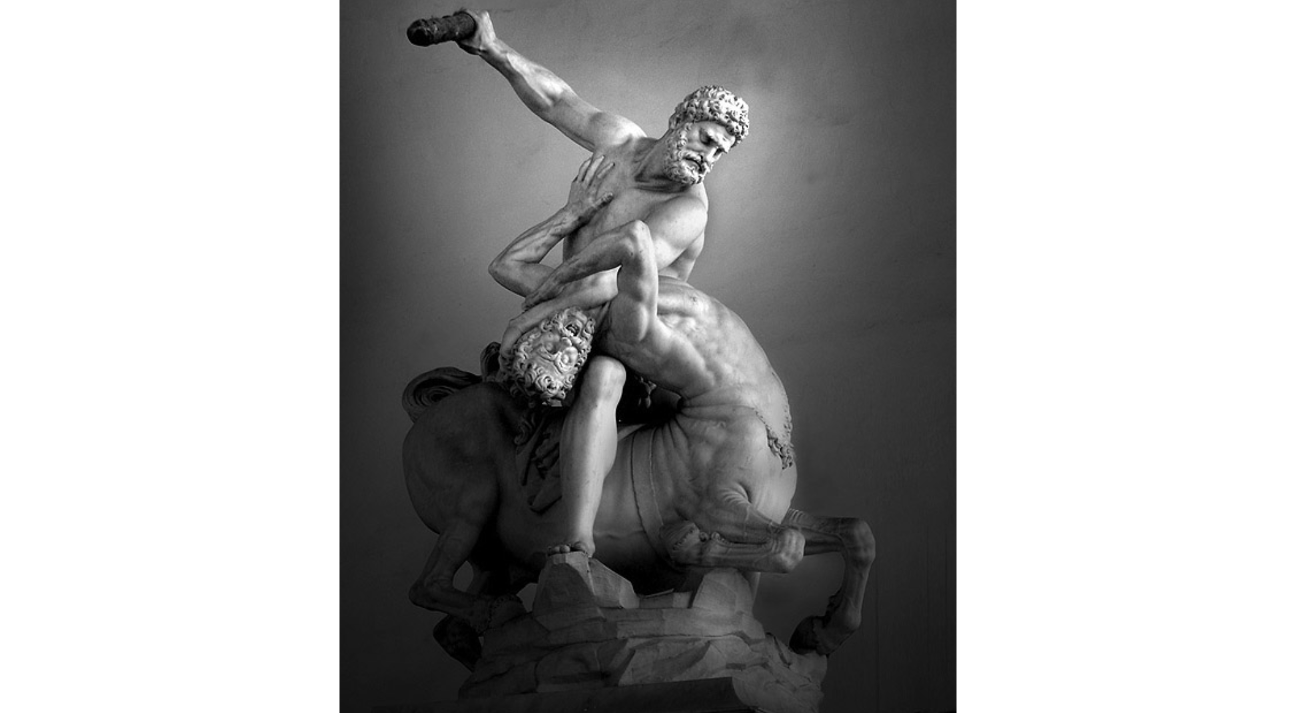
Doni Tondo (Holy Family), Michelangelo. 1504
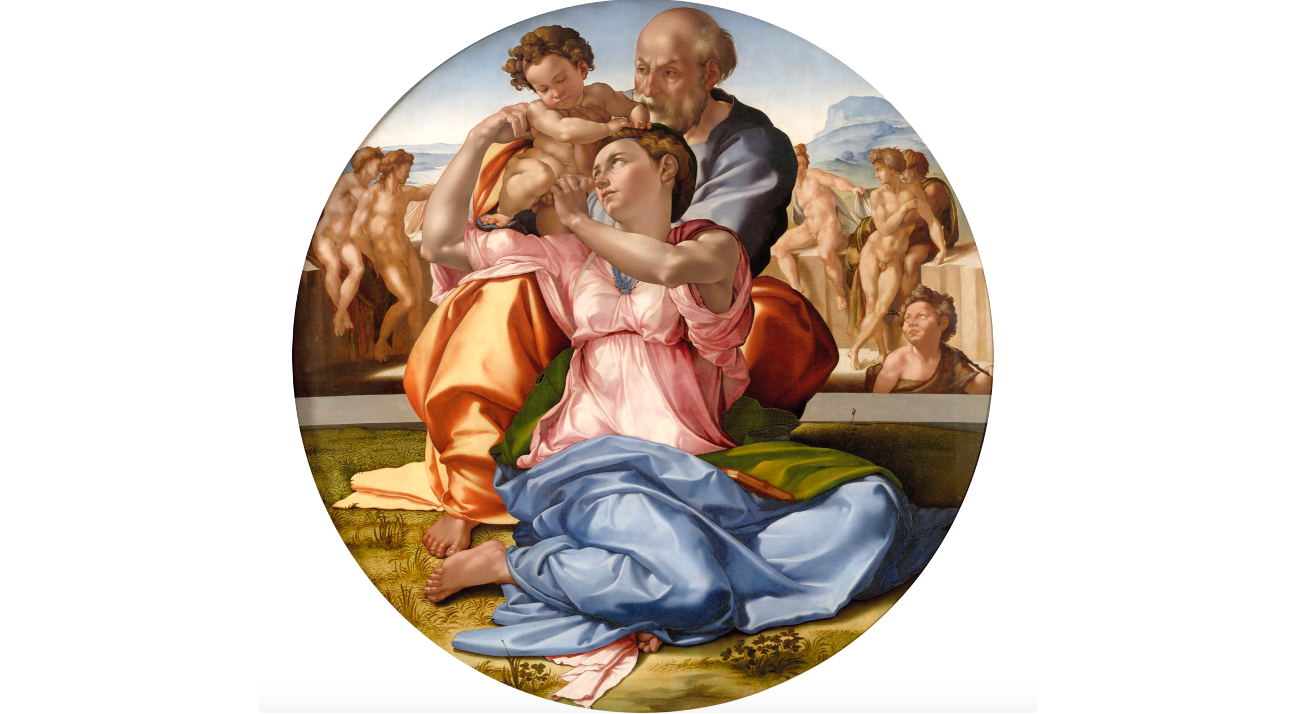
- Mary, child and Joseph
- poses of the figures unnecessarily complicated
- believed the figure was more beautiful (poetic) when it was complicated
- extra figures in the background common for Michelangelo
Sistine Chapel Ceiling, 1508-1512
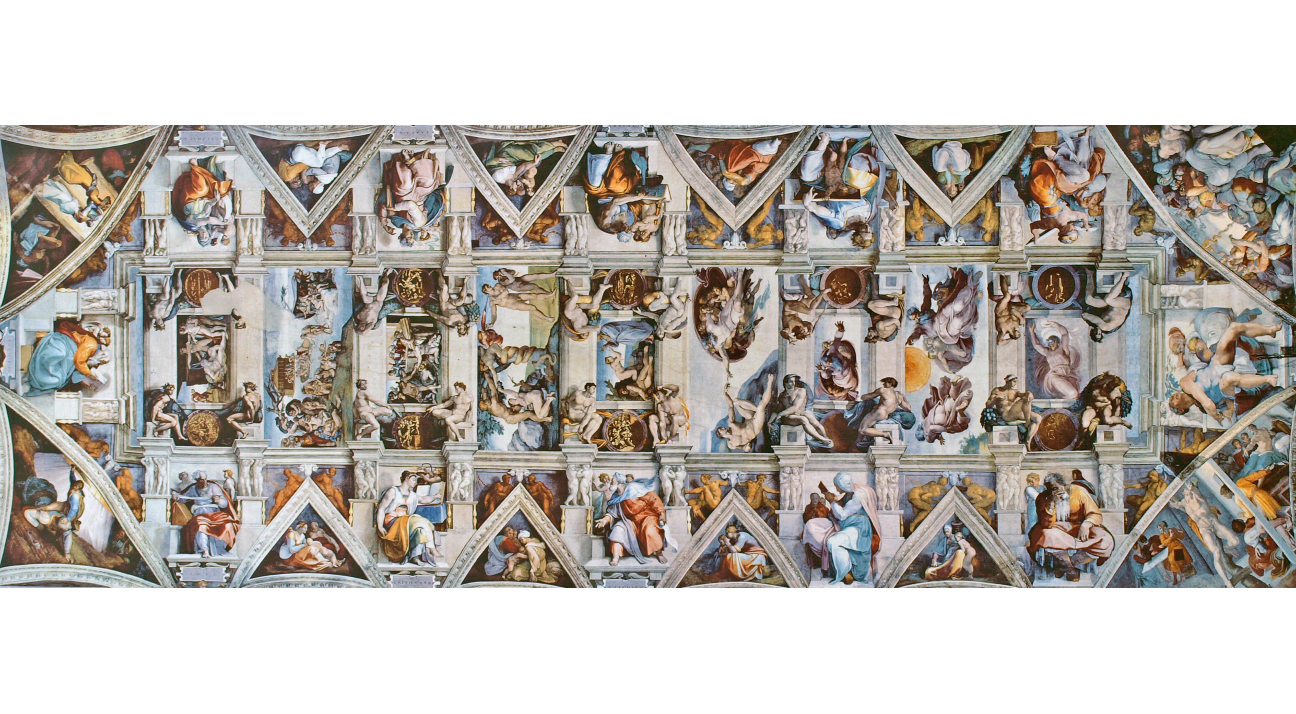
- Michelangelo only commissioned to paint the book of Genesis (satisfied in only 9 of the paintings), the rest was his own vision
Creation of Adam
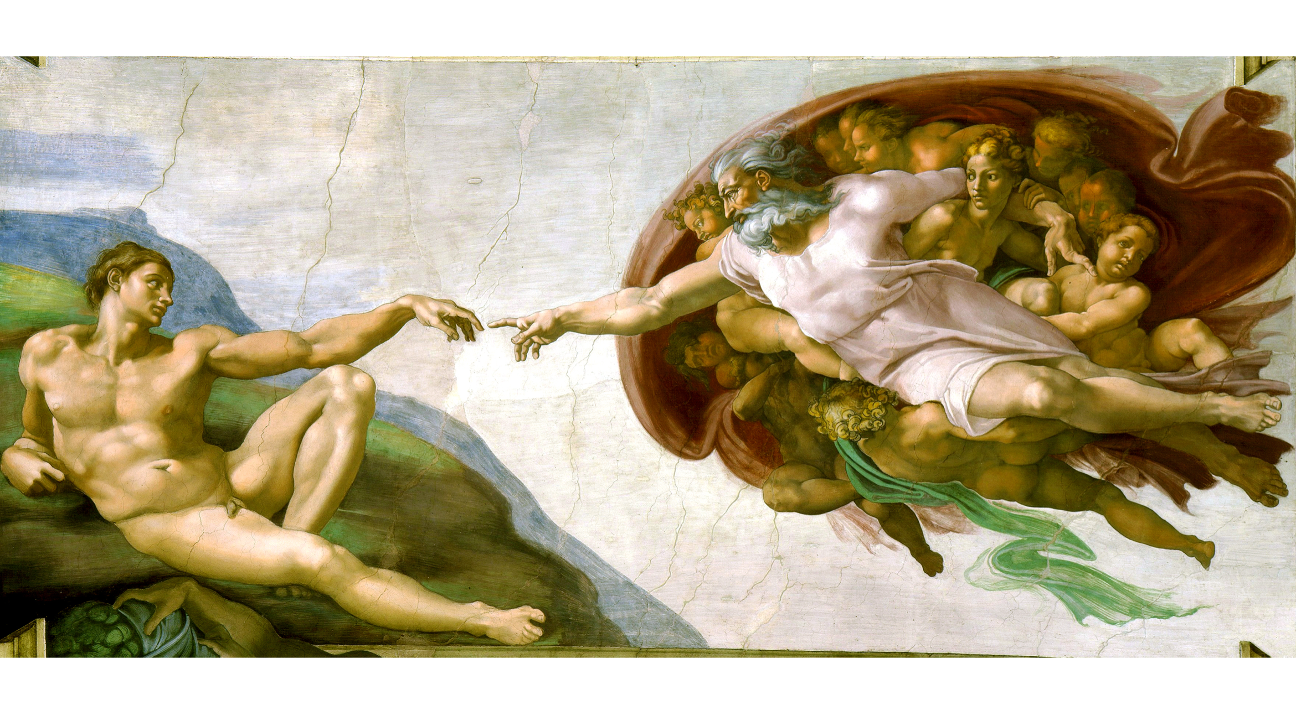
- moment before the action (like in the David)
- two figures, active and passive, concave and convex, relaxed and in action, etc.
- extra unnecessary figures in the background
Ignudo
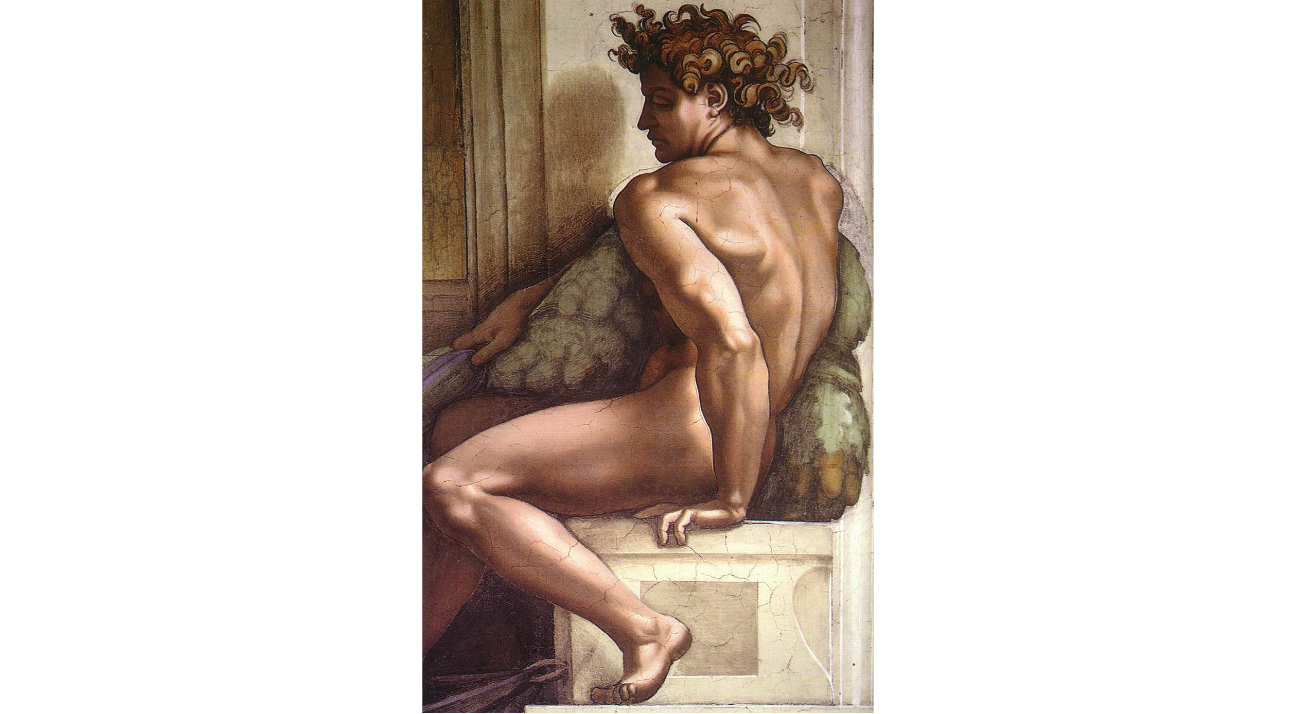
- ignudo - nude male figure
- non-biblical, serves no purpose connected to the narrative
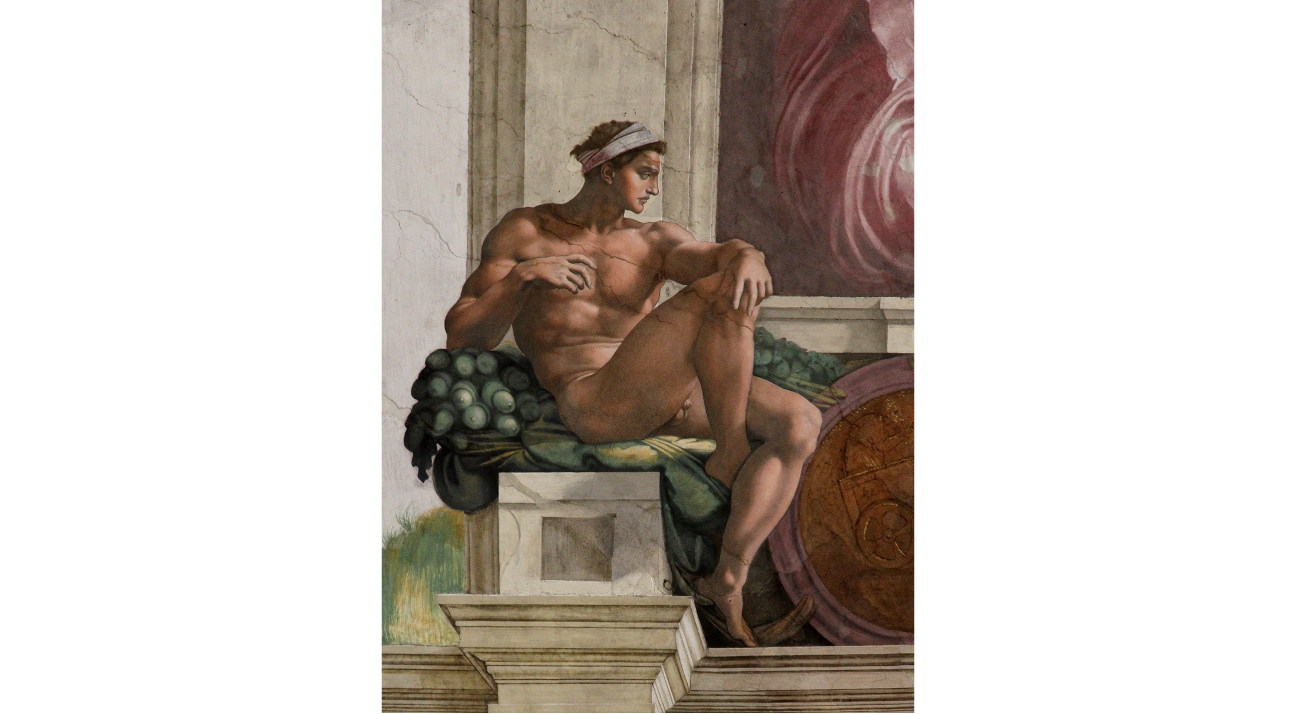
- what Michelangelo wanted to paint
Study for Libyan Sibyl
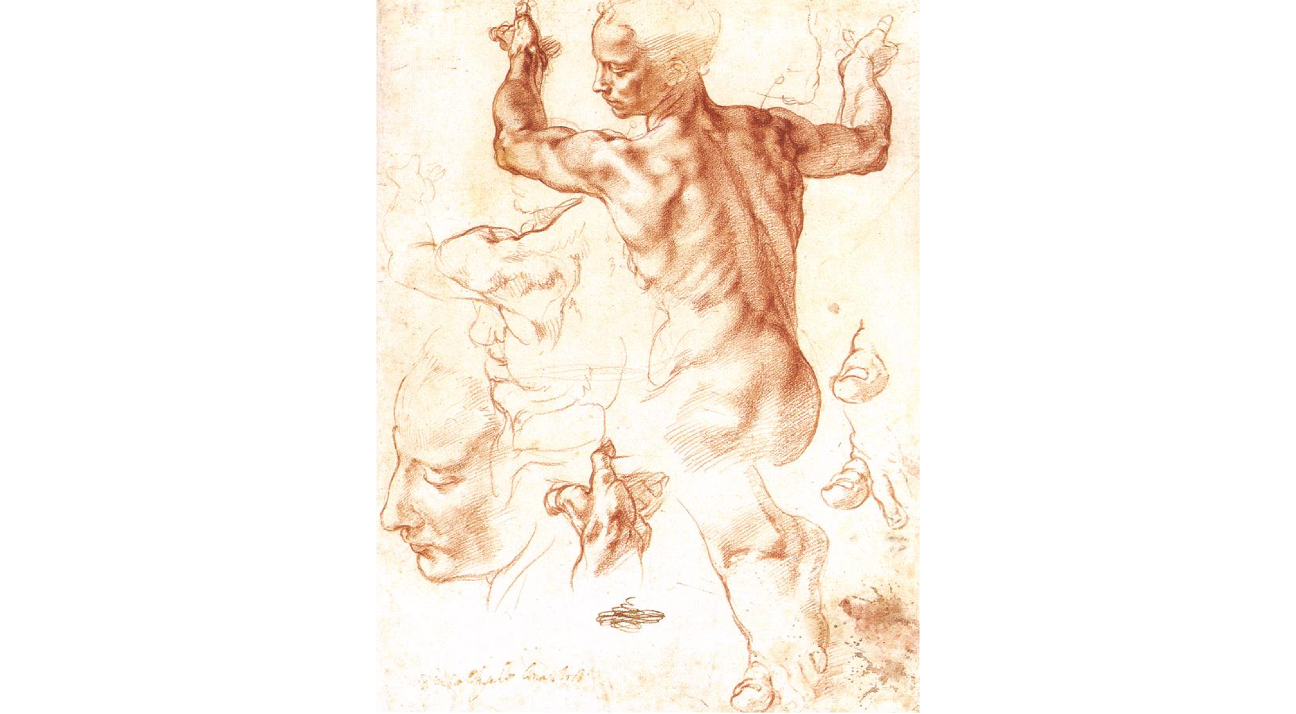
- page from Michelangelo’s sketchbook drawn from life, from the live figure
- figure of a young man
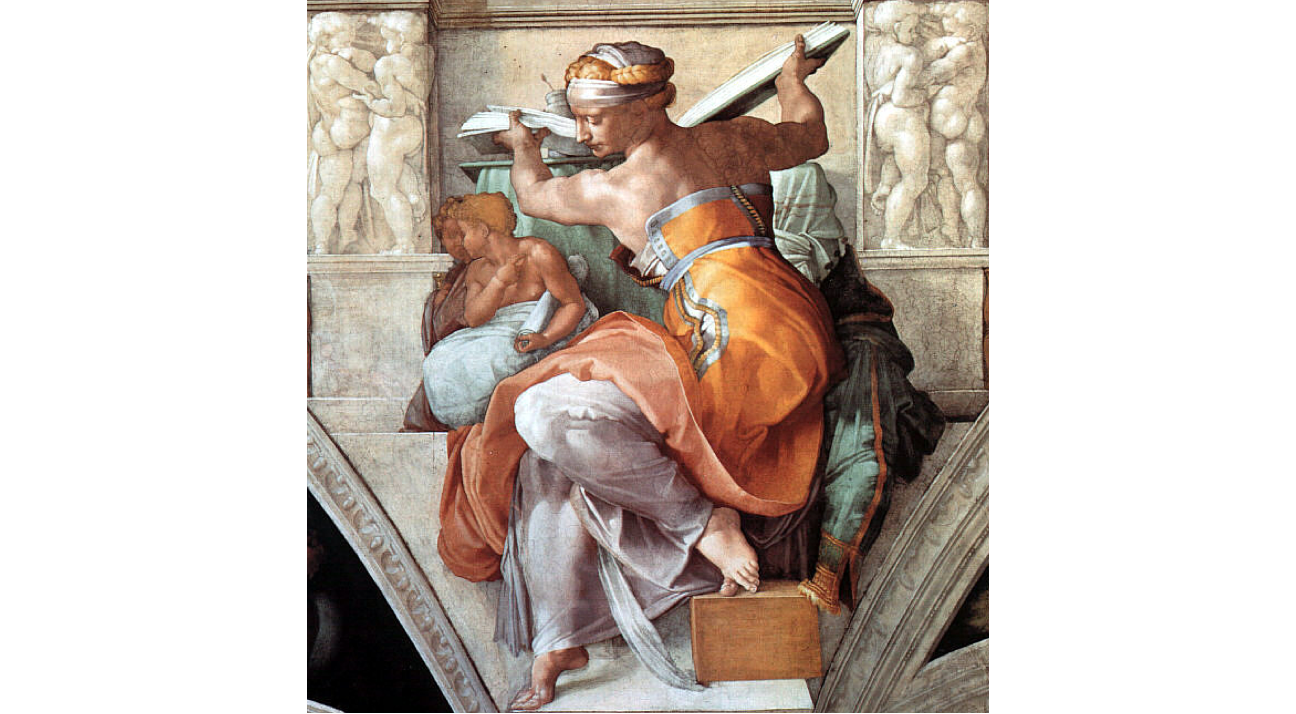
- recreated into a figure of a woman
Entombment, 1528. Pontormo
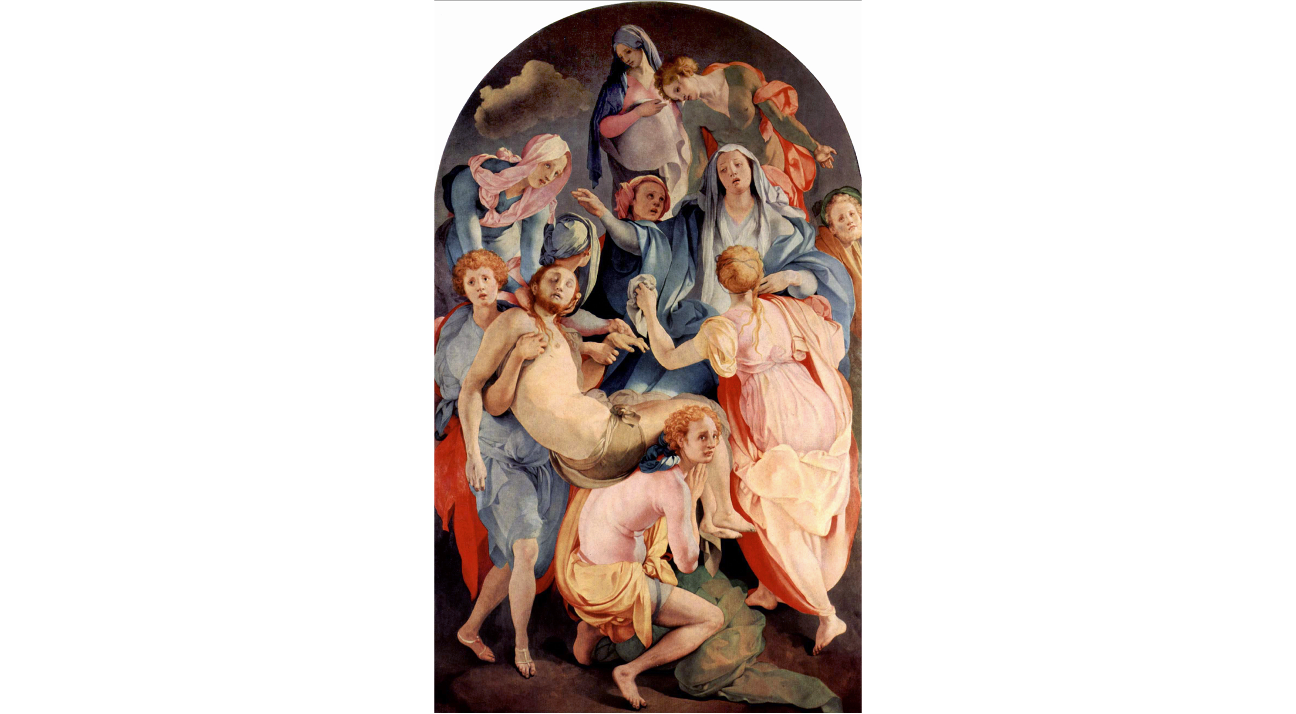
- Mannerist
- removal of the body of Christ from the cross, placing him in the tomb
- exaggerated features, Christ’s torso is elongated
- which figure is which is unknown, barely any information to decipher what is happening
- no crosses, no halos, etc.
- aspect of Mannerism
Madonna with the Long Neck, 1535. Parmagiannino
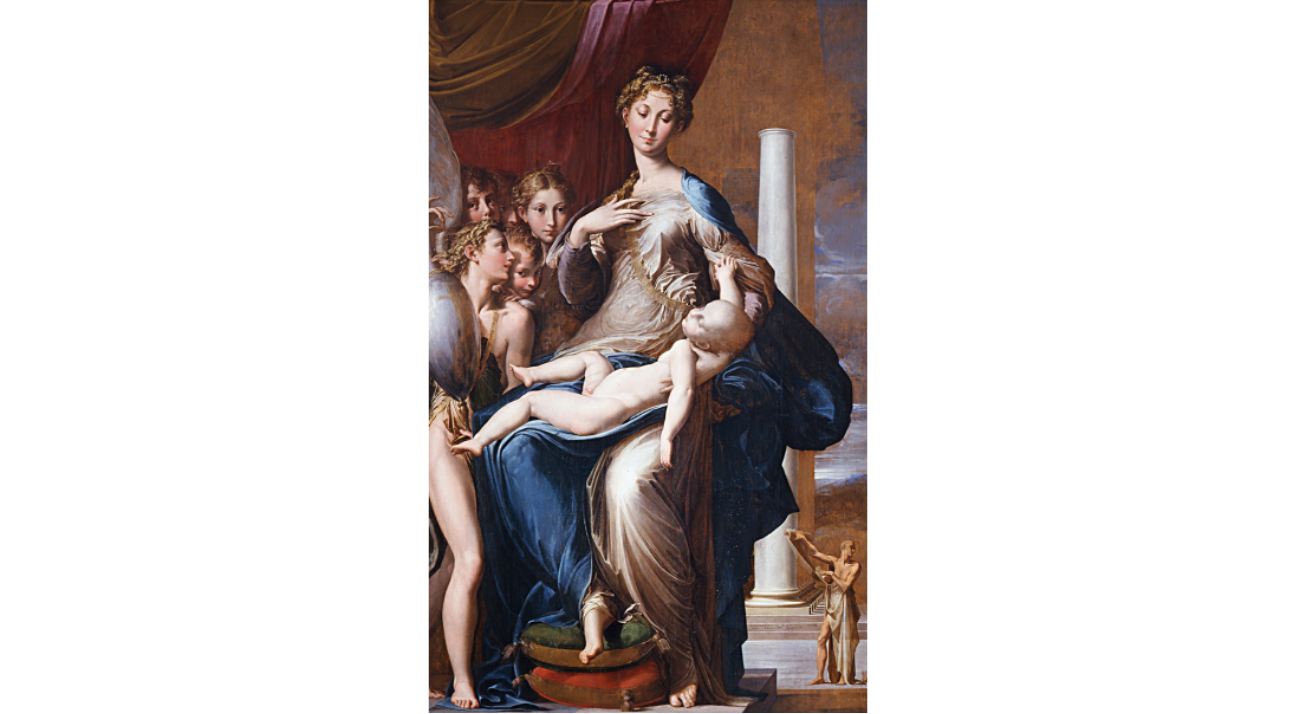
- Mannerist
- child is elongated, figures and proportions are exaggerated
- figure in the back looks like a very tiny human being instead of someone in the background
- extra figures in the painting, unsure what or who they represent
- columns in the background holding up nothing
John the Baptist, 1553. Bronzino
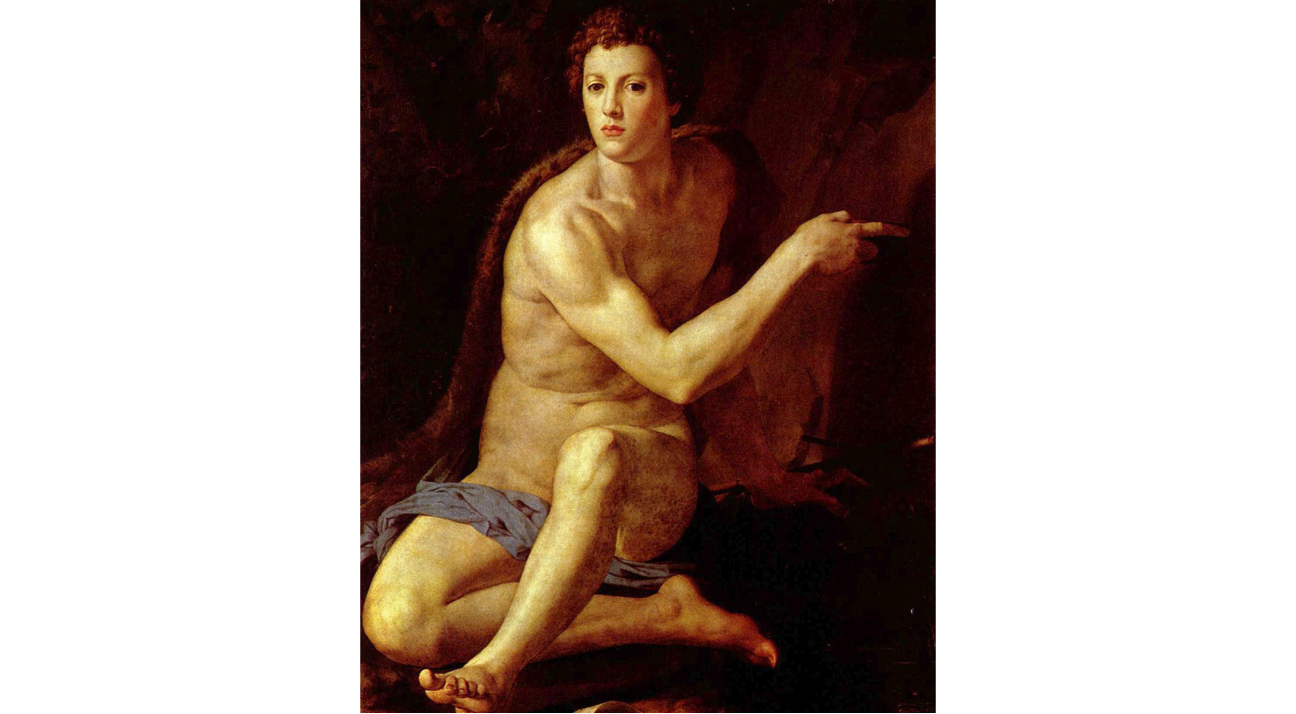
- Mannerist
- exaggerated pose, elongated torso, disproportionate to the rest of the body
- elitist - if history wasn’t understood, then you wouldn’t understand the artwork
Portrait of Cosimo I de’Medici as Orpheus, 1537. Bronzino
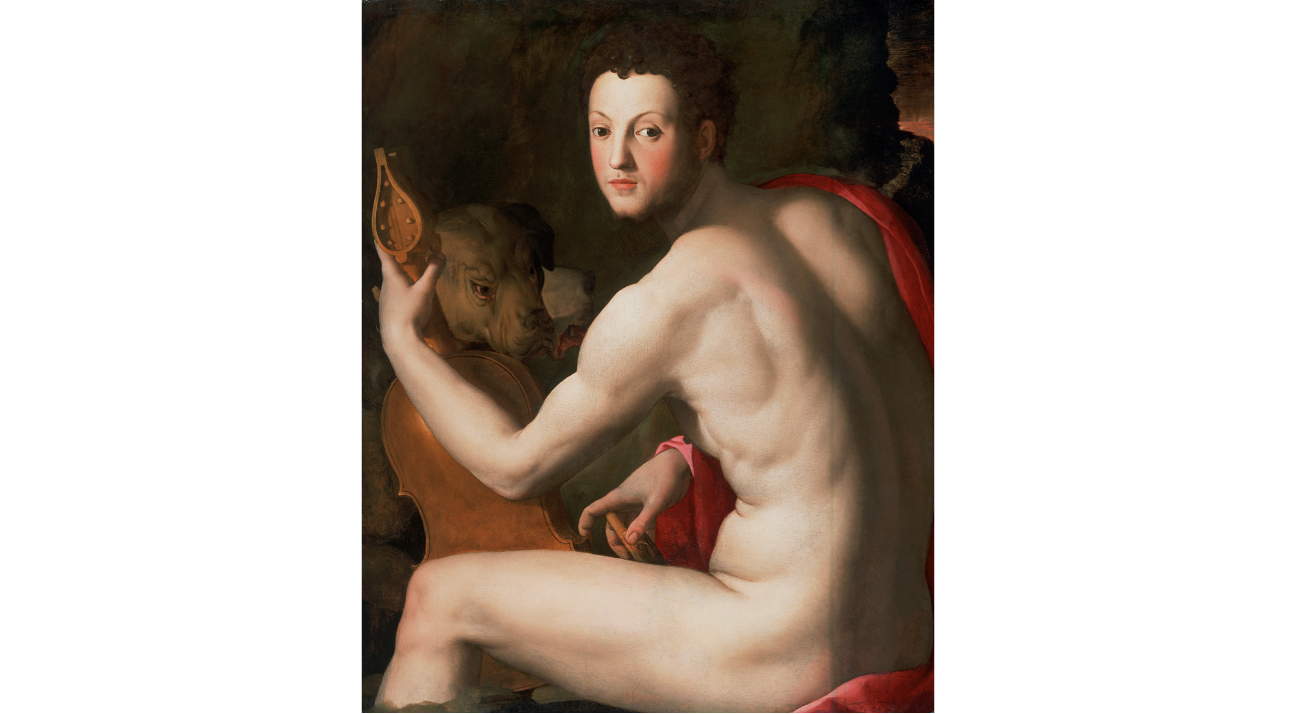
- elongated torso, bow placed in a provocative area
- creating a discussion of a story
- Orpheus’ wife died, he went to the Underworld to get her back, Hades says that he’ll return her, she’ll be right behind him as he goes back to the surface but if he turns around, she has to stay in the Underworld forever. Right before he makes it back, he turns around and sees her, she then disappears and has to stay in the Underworld forever.
